- English (EN)
- Español (ES)
- Português (BR)

Is Cali Safe? Crime Rates & Safety Report

Colombia : Safety by City
- Barranquilla
- Bucaramanga
- Santa Marta
The third-largest Colombian city, Cali, provides a relatively safe destination as long as you adhere to the Colombian tenet, “No dar papaya.”
That means don’t give papaya literally and it is slang for not flashing money or expensive items.
Despite the Colombian drug trade and housing some of the most famed drug cartels, Colombia still makes a fun and generally safe tourist destination.
- Warnings & Dangers in Cali
OVERALL RISK: MEDIUM
Cali provides a respite from the upheaval occurring in other areas of Colombia. Because of COVID-19 and crime and terrorism in Arauca, Cauca, and Norte de Santander, the US State Department has ranked Colombia as a country with a Level 4 Do Not Travel area. Organized crime has overtaken the country of Colombia with homicide, armed robbery, extortion, kidnapping, and robbery topping the list of problems. The Colombian government signed a peace agreement with the Revolutionary Armed Forces of Colombia (FARC). The terrorist group FARC contains some hold-out factions that refuse to demobilize though. Another terrorist group in the country, the National Liberation Army (ELN) continually plots attacks within the country’s borders. They typically target tourist hotspots, transportation hubs, and local government facilities. They also include religious locations and hotels as attack points as well as major cultural and sports events. Despite this, the country of Colombia did not receive its Level 4 rating until COVID-19.
TRANSPORT & TAXIS RISK: LOW
Despite the political unrest, you’ll probably feel at home since taxis provide a common mode of transport in the city of Cali. The taxicabs provide reliable and the easiest way to hail a cab is using the app EasyTaxi. The minimum fare is $1.40 but goes up just a bit on Sundays and during the evenings after 8 pm.
PICKPOCKETS RISK: HIGH
Throughout the past decade, Cali proved a safer place to visit. It has gone through changes though and become dangerous and violent in many areas. You are likely to get pickpocketed in Cali if you flash your papaya or you look like a tourist. The only way around this is to blend in completely and avoid taking anything of value on the streets with you.
NATURAL DISASTERS RISK: HIGH
Cali, Colombia experiences many dangerous natural hazards including hurricanes, tropical storms, earthquakes, volcanoes, and a rainy season that results in frequent landslides and floods. Even areas of the country that do not have a local volcano can experience issues from an eruption since the smoke and fire from the volcano travel through the atmosphere.
MUGGING RISK: HIGH
Muggings occur in Cali frequently. You should leave all of your valuables in the hotel safe. Try to blend in and look as much like a local as possible. Consulting with your hotel’s concierge to learn directions to your destination, then memorizing them so you never need to check them can help you stay safer.
TERRORISM RISK: HIGH
Cali could become a terrorist attack target during its major cultural events such as Carnevale. From August to September each year it offers numerous cultural events that could attract terrorists since they draw attendance from throughout the world. These include the Pacific Music Festival, meeting of Creators of Jazz Fusion and Experimental Jazz, the International Poetry Festival, the World Salsa Festival, the International Book Fair, the International Theater Festival, the International Film Festival, and the Cali Fair. As the major cultural mecca of Valle del Cauca, it gets picked as the destination for many major events, and, as such, terrorists may target it.
SCAMS RISK: LOW
You won’t find many street scams or other rip-offs in Cali, but you could get approached by someone about couriering drugs. Regardless of what you’re approached about carrying, always refuse politely and move on quickly.
WOMEN TRAVELERS RISK: LOW
According to World Nomads, women can safely travel solo to Cali, Colombia. You will do better there if you speak the language and avoid vulnerable situations. This means you should always stay aware of your surroundings. Either avoid drinking or set a limit and never leave your drink unattended or accept drinks from a stranger. Women alone on the street prove a more frequent mugging target so take a taxi or walk with a friend.
TAP WATER RISK: LOW
In the major cities of Colombia, you can drink the water straight out of the tap. The tap water in Cali, Colombia comes from the Cali River. It undergoes cleaning and potabilization at a treatment plant and is transported to homes and businesses throughout Cali by “clean pipes.”
- Safest Places to Visit in Cali
As long as you stick to touristy areas, you can stay relatively safe.
If you want to explore a typical neighborhood, choose a good neighborhood like Ciudad Jardin or Barrio El Penan.
Try the salsa clubs in San Antonio for evening entertainment since Cali is considered the salsa dance capital of the world.
When choosing your accommodations, pick a hotel with a doorman in the Normandia area.
Also, visit the butterfly farm and explore street art.
- Places to Avoid in Cali
Of course, every area has its neighborhoods to avoid and in Cali, those include Siloe, Terron Colorado, and Aguablanca.
If a local tells you not to go to an area, stay away from it because the police in Colombia, especially Cali does not service the bad neighborhoods.
Police corruption runs rampant there and those who live there and run travel blogs warn tourists that they should stick to the beaten path and tourist groups to stay safest.
- Safety Tips for Traveling to Cali
- Always keep a low profile when visiting the city and Colombia as a whole.
- Avoid going out drinking alone. Even when you and your friends go to bars or salsa clubs together, remain in control of yourselves and do not overdrink. Drunk tourists easily have bad things happen to them.
- Do not take drugs. Some individuals visit the country known for the Medellin cartel and decide unwittingly to try the local product. Doing any drugs anywhere in the country will land you in prison.
- Leave all of your valuables at home. Do not travel with a fancy phone, such as an iPhone, or bring an expensive camera. Buy a cheap phone before traveling that no one would consider flashy.
- Avoid bringing your own bicycle, especially an expensive one. Muggers have killed tourists for their carbon-frame bikes. The country is very poor, and the $3,000 bikes cost more than many people earn in a year. It is in very poor taste to flash your money in any way.
- Do not hire a prostitute or other sex worker. Colombia has become a hot spot for bachelor parties. Have fun without hiring or picking up on any locals. Many of the prostitutes are underaged and the situation is so serious that the government created a special hotline – Linea 141 – to report the abuse of children, including sex abuse and sex workers under the age of 18.
- Keep the little money that you take outside of the hotel in a money belt or other hidden means. Never flash the cash on the street. You will need cash since most places don’t accept credit cards.
- Never make jokes about the drug wars, the political climate, or other local issues. Colombians can take offense and you could end up hurt or dead.
- Hire a driver, using the taxis or Uber. Many tourists who drive themselves in a rental car have wrecks because the roads are bad, and mountain passes are treacherous. It takes experience to drive them.
- Use a local guide that you hire ahead of time. Better yet, plan your trip through a travel agent and use only organized, recommended tours that you booked ahead. Bird watchers and orchid collectors often try to explore on their own, but you should hire a guide to maximize your safety.
- So... How Safe Is Cali Really?
While COVID-19 has eroded safety there with respect to the health situation, the city of Cali still provides a mecca of cultural attractions.
This happening little city hosts so many festivals and meetings that it offers something for everyone.
You just have to know when to visit it.
As long as you take essential precautions, most of which you would take when visiting any major city in the US, too, you’ll be fine.
Yes, there is an enhanced risk of terrorist activity.
The breakoff groups from FARC notwithstanding though, the city provides a safe and fun place to visit and explore the culture of this South American country.
It is not a safe place for investigative journalists or foreign business people at this time.
That’s due to the political climate and the police and the people’s perception of foreign journalists.
Never wear any military-looking clothing and never insult their coffee.
The latter may seem strange since the country grows some of the finest coffee beans, but they export that.
The coffee served in most areas tastes terrible since they keep the worst for themselves.
If you order Brazilian coffee or send back your Colombian coffee, you will have insulted them.
- How Does Cali Compare?
- Useful Information
If you are not a Colombian citizen, you will need your passport to enter and leave Cali, Colombia. You won’t need a Colombian visa unless you plan to stay longer than 90 days, according to the US State Department.
The Colombian peso serves as the currency in the location. You can exchange your dollars for pesos before your trip by visiting the foreign exchange bureau, post office, or bank. Exchanging before you leave can result in better exchange rates.
Colombia experiences some of the nicest weather you can imagine. July, the coldest month in Cali, experiences a high temperature in the mid-60s F. During January, temps hover in the mid-80s F. Nightly lows drop about 20 degrees, so expect a low temperature in the mid-60s during January and February, for example.
You’ll need to fly into Alfonso Bonilla Aragon International Airport, outside of Cali. If you read old travel books, this airport used to be called Palmaseca International Airport.
Travel Insurance
It makes sense to purchase full travel insurance before visiting Cali. You could get hurt while there or mugged and the travel insurance covers your medical costs. Many people think of it as trip cancellation insurance, but it does much more than that. It can provide travel assistance if you get kidnapped by terrorists, for example.
Cali Weather Averages (Temperatures)
- Average High/Low Temperature
Colombia - Safety by City
- Where to Next?
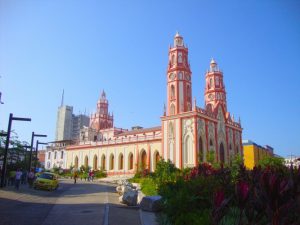
2 Reviews on Cali
Cali is such a gem of a city.
Unfortunately (or fortunately) Cali is not as well known as Cartagena, Bogota or Medellin. For example, did you know that Cali is the World Capital of Salsa? I didn’t know that. This city has so many things to see and do that you’ll be amazed. It’s one of the biggest surprises in recent years on my travels and I highly recommend you give it a shot.
There are many things to explore and I started with San Cipriano which is a not so well known day trip for people that want some adventure. This is a jungle town so no road leading to it. So how can you get to it? By riding something called Moto-brujas which are motorcycles on top of some wooden board that runs on a train track. Sounds exciting enough for you? Well it is.
I also recommend trekking when in Cali but always use a guide because some people have gotten lost without one. There are a few treks you can do. The one we did was named Pico de Loro but be careful as it’s not the easiest one by far. Ask your guide and see which trek would suit you.
Did you know Cali has a copy of the famous Christ the Redeemer statue from Rio? They do and it’s beautiful and on your way to it you can stop at any of the 18 or so pizzerias and eat some delicious pizza while also enjoying the stunning view. Make a day out of it – it’s worth it.
You can take salsa classes in many locations found here. The city lives for salsa and there are many places to both take classes in and also dance salsa in clubs. We went to Manicero and it was a great experience. Ask around as there are many choices.
And there are many, many more things to do in Cali. If you came here to stay a week you might end up staying a month since there’s so much to do and the prices are low.
Share Your Experience Cancel reply
Your Review
Title of your review
Article Contents
- Cali : Safety by City
- Overall Risk
- Transport & Taxis Risk
- Pickpockets Risk
- Natural Disasters Risk
- Mugging Risk
- Terrorism Risk
- Women Travelers Risk
- Tap Water Risk
- Weather Averages (Temperatures)
- User Reviews
- Share Your Experience
Popular Destinations

Safety Index
Recent reviews & comments.
- Nessma on 10 Most Dangerous Cities in France
- Danny Fields on 10 Safest Cities in Guatemala
- Bryan West on 10 Safest Cities in Guatemala
- Andrew Cole on 10 Safest Cities in Guatemala
- Kylie Smith on Thornton
Popular US States
- Pennsylvania

Is Cali Colombia Safe: 10 Essential Tips For Travelers
One of the questions I get asked frequently is “Is Cali Safe”? When it comes to safety in Colombia, this South American country might not have the best reputation. While there are safer cities such as Bogota , Medellin , and Cartagena , many tourists that like to explore the Salsa Capital of the World might wonder about the safety in Cali, Colombia.
Cali is one of the more dangerous cities in Colombia, but it is safe to travel as long as you take extra safety precautions. Crime is concentrated in a few areas, so as long as travelers stay in tourist areas, they’ll be safer. It is important that you don’t “ dar papaya “, a Colombian Spanish saying for “don’t put yourself in a position where people can take advantage of you.
This means things like wearing fancy clothes out in the open, flashing your valuables around, or more simple things like walking alone at night on a dark and narrow street.
There are lots you can do regarding safety in Cali that’ll minimize your risk in this beautiful city and allow you to explore salsa dancing, breathtaking nature, and its rich culture.
That is why we have written this article to make sure you have all the safety travel tips you need for your next trip to Cali Colombia!
Planning A Trip To Cali Last Minute?
Make sure you book your tours, places to stay, and airport transfers ahead of time to ensure availability!
Our recommended airport transfer to Cali:
- Cali Airport Transfer Service To City (Safest way to get to your hotel!)
Our recommended tours in Cali :
- City Highlights Tour, Cristales Hill and Local Drink (Must-do in Cali!)
- Bosque el Descanso Nature Excursion (Super fun!)
Our recommended places to stay in Cali:
- Alko Hotel Casa Nispero (Luxurious and affordable!)
- Faranda Collection Cali (Great value-for-money!!)
- La Palmera Hostel (Perfect for backpackers)
History of Safety and Crime In Cali, Colombia

It is no surprise that Cali does not have a good reputation regarding safety. This city was home to two of the most dangerous men in the drug industry(after Pablo Escobar), the Rodriguez Orejuela brothers . They were head of the infamous Cali Cartel, which originates around the city and the Valle del Cauca Department.
At its peak, this group of delinquents was said to have control of around 80% of the cocaine market in the world . Of course, the violence associated with this kind of activity overflowed the city, which soon had one of the highest crime rates in the world.
After the arrest of the head members of the Cali cartel in 1995, safety in Cali has been slowly on the rise. Along with the peace agreement between the Colombian government and the Revolutionary Armed Forces of Colombia (FARC), Cali no longer has the high homicide rates, violence and insecurity it once used to have.
Unfortunately, the outbreak of the COVID-19 pandemic deteriorated some of the achievements in terms of safety. With little to no tourism, locals looked for other methods to make an income, and some had no choice but to commit minor crimes such as theft and pickpocketing.
In 2021, Cali was the center of anti-government protests against new tax-related reforms, which were implemented to generate revenue for the government due to the lack of tourists. These reforms turned Cali into a battlefield, with many violent riots and people hurt.
Luckily, after the end of the pandemic, safety in Cali started improving and most tourist areas are now safe enough for travelers to have a great time.
Is Cali Colombia Safe For Travelers?
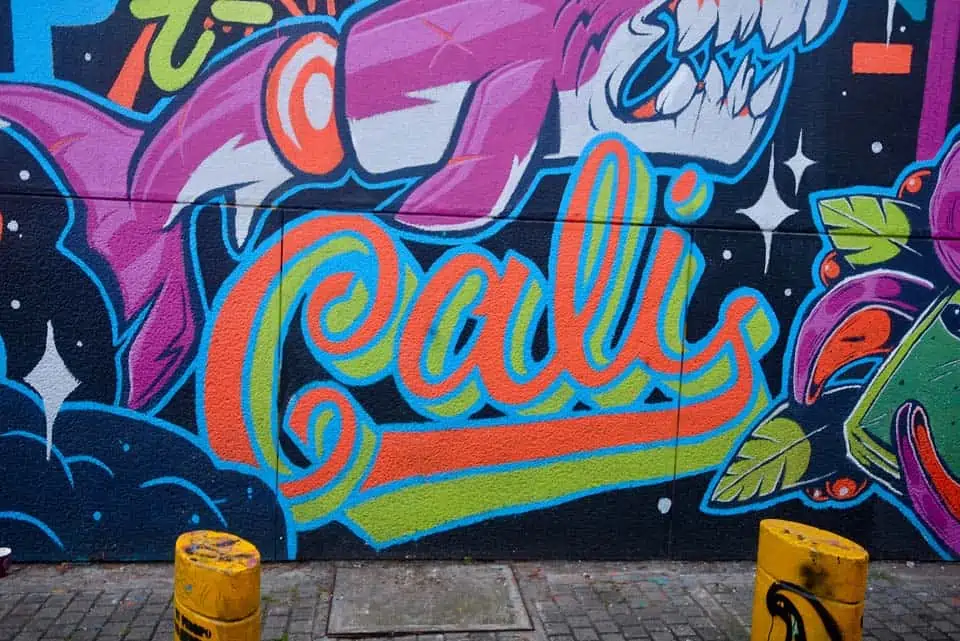
After all these stories about violence, drugs, and crime, you must wonder if it is worth traveling to Cali, Colombia. While safety is not guaranteed in Cali (or any place in fact), there are certain things that you can do to stay safer.
Generally speaking, as long as you are using common sense, avoiding the dangerous parts of the city, and staying alert to your surroundings, Cali is quite safe for travelers. Be extra careful when walking around alone, especially at night, as that is when most crimes happen.
Cali is not a place where you want to explore off the beaten path. Stay in the tourist areas and you are more likely to not encounter any risky situations on your trip.
Don’t Ruin Your Trip By Not Having Travel Insurance!
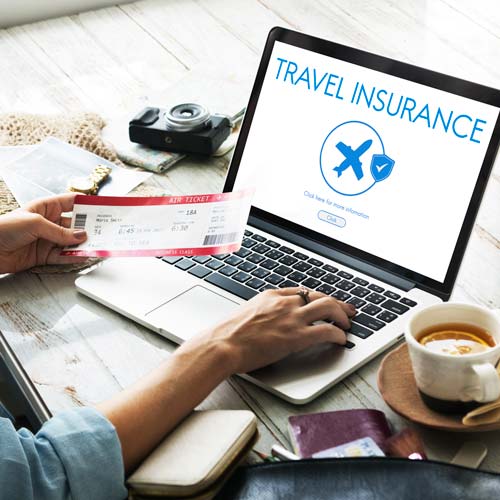
“Because Life Happens.”
Experience and enjoy your travel destination, embark on adventures, and create unforgettable memories, all while knowing you’re protected.
Is Cali Colombia Safe For Solo Female Travelers?

Typically speaking, Cali can be safe for solo female travelers. But like most of the world, solo female travelers tend to be perceived as easy targets and often garner more attention.
Like most South American countries, machismo is still very present in Colombia. This means you might get lots of catcalling and even some sexual harassment in Cali.
When you are walking in the street alone, it is best not to entertain any of the catcalling. You might be tempted to tell them to stop, but it could work against your own safety.
Sexual harassment is more common in clubs and bars. Though Cali has an incredible nightlife, women sometimes find themselves the subject of sexual harassment.
Read More: 21 Famous Landmarks In Colombia You Cannot Miss!
To stay safe in Cali, minimize walking around in the streets at night, especially alone. Avoid the dark and narrow alleys when someone can sexually assault you or just rob you. Don’t leave your drinks unattended, drink spiking does happen sometimes in Cali.
Colombians have a reputation for being charming and overly nice, which is true, but always remember that people might have hidden intentions.
If you are a female solo traveler in Cali (or Colombia in general), we recommend staying in one of the social hostels and making a friend or two to explore the city together. There is strength in numbers!
Is Cali Colombia Safe At Night?

Cali is a lot more dangerous at night, but travelers can generally stay safe as long as they are in the right neighborhoods. Cali can be pretty extreme if you end up in the wrong neighborhood at night.
As we’ve mentioned, there are risks when it comes to nightlife such as pickpocketing and drink spiking. Walking alone at night is strongly discouraged, especially if it is an area with a low flow of traffic. Just because you are in a safer neighborhood doesn’t mean that you are safe.
Criminals know that all the rich tourists staying in these areas. Though these areas have more police presence, they’ll try to commit petty crimes that won’t alarm the authorities.
Flashing your valuables, dressing like a rich tourist, and roaming around drunk or intoxicated are some behaviors you want to avoid if you want to stay safe.
If you want to get from place to place at night in Cali, we recommend you take an Uber or Cabify to avoid any unnecessary risk. If you are unsure about a particular neighborhood, it is always better to ask the receptionist at your accommodation.
Is Public Transportation Safe In Cali, Colombia?

The main form of public transportation in Cali is the Masivo Integrado de Occidente (MIO) and it covers about 95% of the city, including some of the main attractions in Cali. The MIO is a system of buses and cable cars, but at the moment, there is no metro in Cali.
Surprisingly, the MIO is quite safe in Cali, but pickpocketing on public transit is a concern. This is more common during rush hours when the buses are jammed-packed with people.
It is a good idea to wear an anti-theft bag or something close to your body so you can keep an eye on your belongings at all times. Don’t keep anything in your pockets because those are easy places for thieves to pickpocket.
It is also a good idea to keep the windows closed on the buses. Sometimes thieves will rob your belongings from the outside of the bus when it is stopped at a light.
Are Taxis Safe In Cali, Colombia?

Like in many other cities in Colombia, we wouldn’t recommend anyone take a taxi from the street in Cali, especially if you are traveling alone. Taxis in Colombia have a reputation for being potentially dangerous, and some even result in the infamous “ Millionaire’s Ride “.
Though the taxis in Cali are metered, some taxi drivers might upcharge you because you are a tourist. So, taxis in Cali aren’t exactly the most reliable or safest.
Luckily, apps like Uber, Didi, InDriver and Cabify solve the issue when you need to travel by cab. These taxi-hailing apps are easy to use and are the most reliable way to order a taxi. Cabify is generally more affordable and therefore more popular than Uber, but both apps are very safe and reliable.
Safe Neighborhoods In Cali, Colombia

The best way to remain safe in Cali is by picking a safe neighborhood to stay. There are several neighborhoods in Cali that are safe, such as:
- San Cayetano
- Ciudad Jardin
- San Antonio
- Historical center
- San Fernando
If you are a tourist in Cali, we recommend staying in El Peñón and San Antonio . These two neighborhoods are rather safe and offer visitors a plethora of activities.
If you are interested in some of the most famous landmarks and history in Cali, then the historical center is a great option.
For nightlife, the neighborhood you want to stay in Cali is San Fernando!
Read More: 17 Things You Didn’t Know Colombia Is Famous For!
Dangerous Areas In Cali Colombia
It is essential that you stay out of the dangerous areas in Cali if you want to stay safe. Generally speaking, the neighborhoods in the 13th, 14th, and 15th communes are known as the “ Aguablanca district “, and they are very dangerous.
Siloé in the 20th commune and the 21st communal are also dangerous. El Rodeo neighborhood in the 12th commune can be rather dangerous, so we recommend you avoid that as well.
And when we say unsafe, it is more than just getting your things robbed, so try your best to avoid those areas!
Read More: 13 Safest Cities In Colombia!
Safety Tips For Visiting Cali Colombia

While your safety is not guaranteed in Cali, there are several things you can do to make your trip safer. Here are some of our trial-and-tested travel safety tips for Cali Colombia:
- Learn Some Basic Spanish – Most locals in Cali don’t speak English, so it might be difficult to ask for help. That is why it is important to learn a few basic phrases and words in Spanish.
- Be Aware Of Your Surroundings, Especially At Night – Stay alert of what happening around you, as you can usually recognize danger before it happens. This is especially true at night.
- When Around With Confidence – Even if you don’t know where you are going, walk around and act like you do. Don’t give people a reason (don’t dar papaya) to come up to you. If you need directions, always ask in a store rather than on the streets.
- Stay In A Place With 24-Hour Security – This will make sure your things don’t get stolen when you are out and about.
- Try To Blend In – If you are able to blend in, you’ll attract a lot less attention. Don’t wear anything too flashy or wave your valuables around. Keep a low profile whenever you can.
- Travel With Travel Insurance – Travel Insurance could give you coverage in case something does happen to you, and it is also good to have peace of mind knowing you are protected. ✔️ Check out our recommended travel insurance here!
- Don’t Get Into A Taxi – As we mentioned, taxis can be unsafe and unreliable. Always use Cabify or Uber when you can!
- Don’t Take More Than What You Need When Going Out – Just in case you do get robbed, you won’t be losing more than you have to. I usually just take my phone, keys, cash, ID, and a credit card when I am out at night. Never take your passport with you at night.
- Don’t Accept Drugs – Colombia has a reputation for narco-tourism, and unfortunately, that is how most tourists get into trouble with the police. If someone offers you drugs in Cali, whether that is on street or at a nightclub, say no thank you (no gracias in Spanish). The drug dealer is sometimes working with the police to put you behind bars or to extort money from you.
- Don’t Fight Back If You Are Robbed – When you are robbed, the first instinct is to fight back. But in Cali, that is the last thing you should do. Criminals are not afraid to use their weapons, and nothing is worth more than your life!
Cali Colombia Safety FAQS
Is tap water safe to drink in cali colombia, is cali colombia worth visiting, is cali dangerous.
Drug cartel wars and internal conflicts have left a terrible reputation for Colombia when it comes to safety and Cali is no exception. However, safety in Cali has gotten a lot better nowadays and the city sees plenty of tourists every year.
We hope our article has answered all your safety questions in Cali. Have a great trip!
Disclaimer: Some of the links above are affiliate links. That means if you book or make a purchase through the links, we will earn a small commission at no extra cost to you ! The money will help run this site! Thank you !
World Traveler, Travel Blogger, Photographer
LivingOutLau
Sean is the founder of the travel blog, LivingOutLau. He has been to over 30 countries in over 5 years of travel. Every day, he is traveling and sharing his discoveries of the world through exceptional travel guides on his blog!
Is Cali, Colombia Safe?
It’s true— Colombia is becoming a hotspot for tourists, with a record-breaking 5.8 million visitors in 2023. CNN even named it one of the “Best Destinations to Visit,” and the star of our article, Cali, got a special mention from Forbes as a top place to visit.
Now, Cali isn’t just any city—it’s the salsa capital of Colombia! CNN even says salsa dancing here is a must-do experience. In this article, we’ve got another item to add to your Cali to-do list: street smarts— as Cali can be a safe destination to visit , but only if you’re careful. Let’s learn more.
Is Cali Safe to Visit?
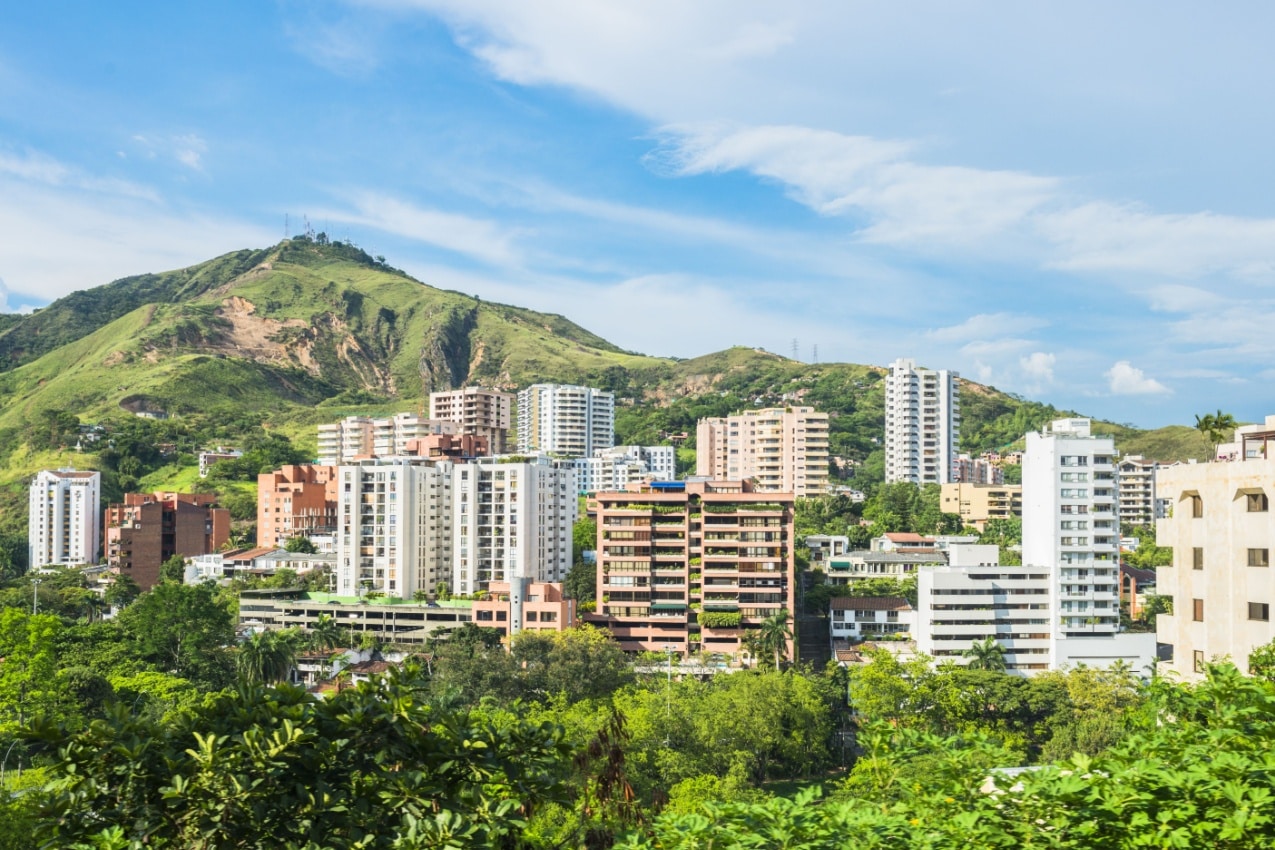
Yes, but not entirely.
Cali was once the base of operations for the Rodriguez brothers and their Cali Cartel, which was among the most powerful in the country.
But things have changed since then. Once the Rodriguez brothers got locked up for their crimes and put away for 30 years, the situation started to improve. Crime rates began to drop , improving the quality of life.
So, does this mean that you’re gonna get jumped on every street corner? Certainly not—but petty theft is still a big issue. And if you wander into the wrong part of town, you might as well stick a sign on your back saying “rob me.”
- International travel advisories: Level 2—visit with a high degree of caution
- Crime rating: 71.73—moderate, towards high
- Most common crime: Violent crimes, cybercrime, and theft
- Most low-crime municipalities: Comunas 1, 2, 4, 5, 6, 8, 10, 11, 16, 17, 18, 19, and 22
- Most high-crime municipalities: Comunas 3, 9, 13, 14, 15, 20, and 21
- Public transportation safety: Reliable, but be wary of pickpockets
- Road safety: Some roads are challenging to drive on, and some locals are known to drive very recklessly
- Safety walking alone during the day: Moderately safe
- Safety walking alone during the night: Highly unsafe
- Common natural disasters: Storms and earthquakes
- Carbon monoxide poisoning: Possible, carry a portable CO detector
- Police presence: Widespread, but may take longer to respond in case it deals with serious crimes
- Medical care quality: Good, but may be expensive if you don’t have a medical travel insurance
Travel Advisory for Colombia
The travel advisories of Canada , New Zealand , the UK , and Australia don’t discourage visiting Colombia, but they do urge tourists to exercise a “High Degree of Caution” (Level-2 safety category). The US advisory, on the other hand, is a bit more cautious, telling travelers to “Reconsider Travel” to Colombia (Level 3).
Violent crime is the main worry in Colombia, which has led to specific areas being flagged as no-go zones. But the good news is that Cali isn’t on that list!
That said, Colombia is still Colombia, so you have to be street-smart. According to the advisories, the main concerns in Cali are thefts and cybercrime —especially through online dating apps .
So—if you’re packing your bags to Cali, just be careful who you meet and keep your belongings close.
A Comprehensive Look at Cali Crime Rates
Cali’s crime rating sits at 71.73, which is moderate but approaching high. The big worries here are things like property crimes, drugs, and corruption. But when it comes to crimes tourists might actually face, like insults or physical attacks based on things like race or gender, the rates are low.
According to Columbia Reports , 75% of Cali’s residents don’t feel secure in their own city, but the level of wariness varies depending on where you are. In the Northwest and Northeast parts of Cali, locals feel the most secure, and that goes for tourists too . On the flip side, the South, East, and Aguablanca areas are where locals feel most at risk, so it’s best for tourists to avoid these areas.
Now, the following info might stress you out— Cali is ranked among the 40 most dangerous cities globally . However, it’s not all doom and gloom, because there are safe neighborhoods in Cali where violence is less common, such as:
- Comunas 1 and 2 in Northwest Cali
- Comunas 4, 5, 6, and 8 in Northeast Cali
- Comuna 10 (City’s center)
- Comunas 11, 16, 17, 18, 19, and 22 in East Cali
Stick to these areas if you visit this city!
On the flip side, areas like Comuna 3 and 9 in Central Cali, Comuna 20 in Southern Cali, and Comuna 13, 14, 15, and 21 in Aguablanca are THE crime spots and no place for a tourist to go.
Source : Numbeo , 2024 data based on 123 contributors.
Personal Crime in Cali
According to Numbeo, personal crimes are somewhat common in Colombia, but whether you encounter them depends on where you are, the time of day, and how you carry yourself.
For instance, walking alone at night in Cali can be very risky. The nightlife scene can get hectic, potentially with criminals out and about. Also, Cali has some very dangerous areas where a great majority of the personal crimes happen the most—we mentioned them above—so make sure to avoid them.
If you’re traveling solo in Cali, especially as a woman, you might face some unwanted attention like wolf-whistling or catcalling. The key is not to respond to it, as engaging may give the wrong impression. Also, it’s best to avoid drinking too much, as it may limit your ability to make sound judgments regarding a situation or a stranger you meet.
Property Crime in Cali
Tourists usually carry more cash and valuables when they go on vacation, which is why they become targets for thefts and pickpocketing.
In Cali, pickpockets and thieves often operate on crowded buses and trains, as well as around cafes or bars, museums and popular attractions, and public ATMs.
Avoid standing out as a potential victim by not walking alone, especially at night. Leave expensive jewelry and large sums of cash at home, and use caution when using public ATMs. It’s safer to withdraw money from ATMs located in banks or malls where there’s a security presence.
Even in seemingly safe places like hotel lobbies, stay alert for opportunistic pickpockets who may take advantage of distractions, such as during check-in, when you leave your luggage on the side and concentrate on the paperwork.
Police Presence in Cali
If you ever find yourself in trouble in Cali, calling the police is your best option. However, be prepared for the fact that they might not arrive as quickly as you’d hoped. Sometimes, crime rates can affect their response times.
It’s important to be aware that there have been cases of fake police officers pretending to check for documents or money with the intention to rob. Corruption can also be an issue —in fact, a study found that 11% of people surveyed in Colombia had been asked for a bribe by police officers.
So it would be in your best interest to be a law-abiding tourist and practice increased caution so you won’t need any assistance from the police in the first place.
Public Transportation Safety in Cali
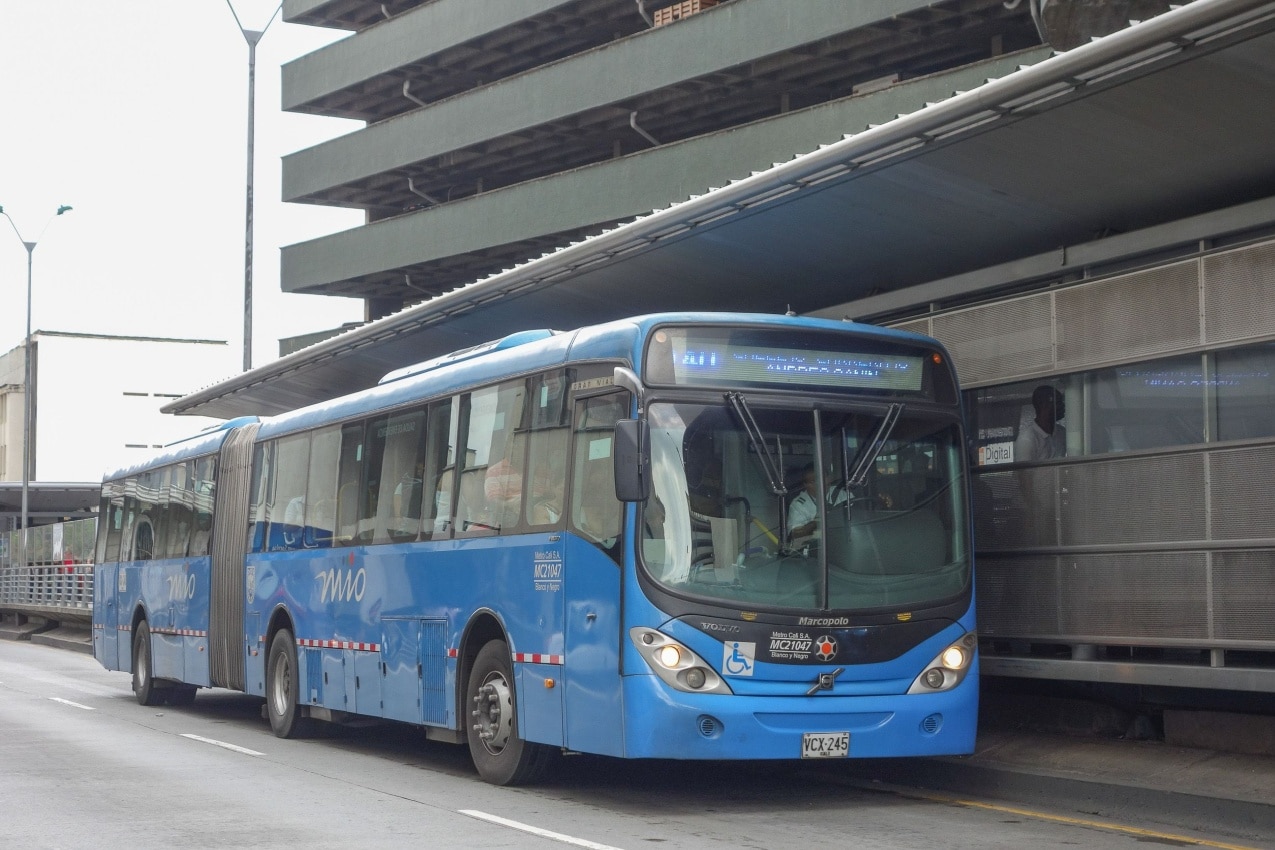
Public transport in Cali is usually reliable but is the hitpoint for thieves. To keep your stuff safe, use an anti-theft bag that’s hard for thieves to snatch, and don’t leave anything valuable in your pockets. And if you’re on a bus, it’s smart to keep the windows closed, so nobody can swipe your stuff from outside when the bus stops.
Taking a random taxi off the street isn’t the best idea. Some drivers might try to overcharge you, seeing you as an easy target. Instead, try the ride-sharing services Uber or InDriver . They’re safer and more reliable. InDriver is usually cheaper and more popular, but both apps will get you where you need to go safely.
Road Safety in Cali
When it comes to road safety in Cali, there are some things to keep in mind:
- Some road signs may be tough to spot or missing altogether.
- Lighting and guard rails might be lacking in certain areas.
- Watch out for livestock roaming on rural roads.
- During busy times, pedestrians might share the road.
- Local drivers can be pretty aggressive and reckless, leading to lots of accidents.
If you’re driving in Cali, here’s what to do:
- Stay off the roads at night if you can.
- Avoid secondary roads, as they’re sometimes targeted by criminals.
- Don’t pick up hitchhikers.
- Keep your doors locked and windows up.
- Hide your valuables under your seat.
- Bring along a cell phone.
- Opt for guarded parking spots when you’re in the city.
Medical Care Quality in Cali
When it comes to healthcare in Cali, you’ve got some good options, especially in the city itself.
Here are some of the best hospitals:
- Fundación Valle Del Lili
- Centro Médico Imbanaco De Cali S.A.
- Clínica De Occidente
- Clínica De Alta Complejidad Santa Bárbara S.A.S
- Clinica Farallones S A
- Hospital Universitario Del Valle Evaristo Garcia E.S.E.
You’ll also find plenty of pharmacies around, many of which are open 24/7 and offer affordable over-the-counter medications. Here are a few reputable ones:
- Droguerías y Farmacias Cruz Verde
- Tecnoquimicas
It’s always a good idea to consider travel health insurance for peace of mind. Look into options like VisitorsCoverage , Insured Nomads , and SafetyWing to make sure you’re covered financially at your chosen healthcare facility.
Is It Safe to Travel Solo in Cali?
Traveling solo in Cali can be safe, but it’s essential to be cautious. Solo travelers can sometimes attract unwanted attention and be seen as easier targets for crimes.
If you’re exploring Cali alone, consider staying in social hostels where you can meet other travelers and explore the city together. There’s safety in numbers, and making friends along the way can enhance your experience. But remember, keep your wits about you—watch out for pickpockets, spiked drinks, intoxicated people (especially at night), and unlicensed taxis. While most locals are friendly, it pays to be on your toes, as not everyone may have your best interests at heart.
Perils of Nature: The Risk of Natural Disasters in Cali
Cali is susceptible to storms and earthquakes, but don’t worry—these are pretty rare and not life-threatening!
Cali tends to get the most rain in spring, particularly in April and during fall, especially in November. In these periods, storms can brew up, bringing heavy rainfall, strong winds, and sometimes flooding and landslides—a real domino effect of events.
In 2023, Cali dodged any major storms, but in 2022 and 2021 , they wreaked havoc, causing flooding, landslides, and other damage like fallen trees and collapsed buildings.
Luckily, we’ve got weather reports to rely on so we can stay up-to-date and avoid getting caught in a storm. For the latest updates on upcoming storms, check out the National Weather Service .
Earthquakes
In Cali, big earthquakes are pretty rare. The last one that shook the area was a tiny 2.8-magnitude quake on March 24, 2024. There was another one a bit stronger, a 2.9 magnitude quake on March 15, but most people hardly noticed it.
Even though they’re rare, it’s smart to know what to do if the ground starts shaking:
- Drop to the ground to avoid getting knocked over
- Take cover under something sturdy to shield yourself from falling stuff
- Hold on until the shaking stops to avoid getting hurt
For the latest updates on earthquakes in Colombia, you can check out the VolcanoDiscovery website.
Beware the Silent Threat: Carbon Monoxide Poisoning in Cali
Carbon monoxide usually leaks from appliances that aren’t looked after properly or don’t have good ventilation. Without a detector to warn you, you might not even know you’re breathing it in, which can be really dangerous.
In Cali, there haven’t been any reports of carbon monoxide incidents. However, other cities in Colombia, like Medellín , have had incidents of carbon monoxide poisoning in hotels. It’s happened elsewhere in the world too, like in the Bahamas and Mexico City .
Accommodations aren’t required to install a CO detector yet, so to be on the safe side, think about bringing your own portable carbon monoxide detector when you travel . They’re simple gadgets that could save your life and are definitely worth having.
If you start experiencing headaches, dizziness, or nausea while you’re indoors, it could mean you’ve been exposed to carbon monoxide. If that happens, get out of there right away and get help from a doctor.
Cali Weather Patterns: What to Expect
Cali has a tropical climate, which means it’s warm and humid year-round.
Temperatures typically range from 66°F to 85°F (about 18.9°C to 29.4°C), rarely dropping below 64°F or rising above 89°F (about 17.8°C to 31.7°C).
The sunny stretch in Cali starts in summer and lasts until early fall. July is the clearest month , with the sky being clear around 25% of the time. During this sunny period, there’s hardly any rain. July sees the fewest rainy days , averaging only 6.0 days with 1.1 inches of rainfall (about 2.8 centimeters).
From mid-September to June, Cali experiences cloudier weather. April is the cloudiest month , with the sky mostly cloudy about 89% of the time. With clouds also comes rain, so from fall to spring, there’s more than a 33% chance of rain in Cali. October has the most rainy days , averaging 13.6 days, while November sees the most rainfall , with 3.9 inches (about 9.9 centimeters). Rain also makes the air humid. During this period, Cali feels humid at least 81% of the time. May has the most humid days , with 29.6 days, while August has the fewest , with 23.9 days.
The best thing of all is that the water temperature remains around 81°F (about 27.2°C) year-round , so taking a dip in chilly water would be the least of your worries!
Monthly Average Temperatures in Cali
Source : WeatherSpark , 2024 data
When Is the Best Time to Visit Cali?
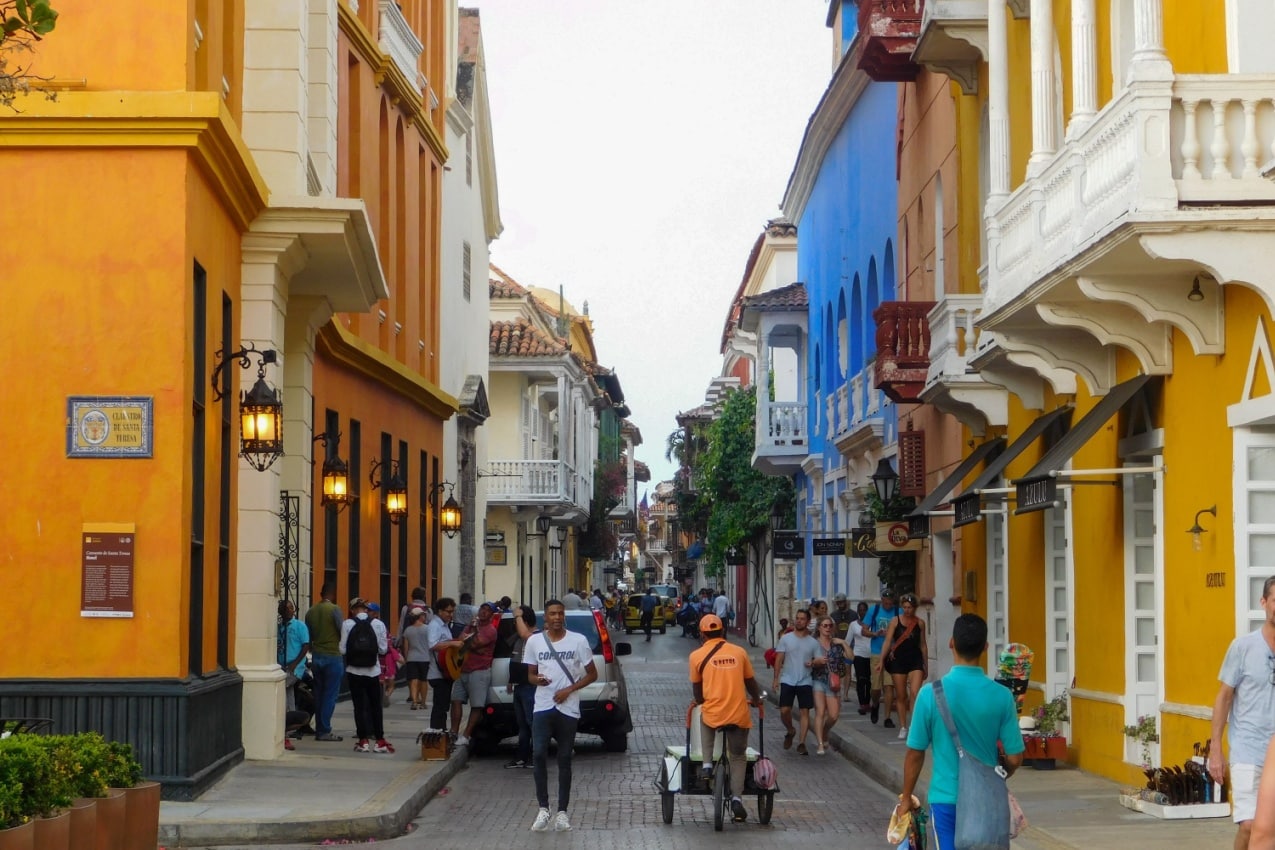
The best time to visit Cali is during the summer months from June to August.
Summer is Cali’s dry season, meaning you’ll get loads of sunshine without worrying about rain spoiling your plans. Plus, with longer days, you’ll have more time to explore the city and soak up the vibes.
During summer, Cali is in its shoulder season, which means fewer tourists compared to peak times. It’s the sweet spot—you’ll still get that lively atmosphere without the crowds, and you’ll likely snag better deals on flights and places to stay.
Just be ready for some serious heat! If you’re not into sweltering temperatures, you might prefer visiting during the peak months from December to March. But expect bigger crowds and higher prices. Or, if you want a calmer stay, consider visiting during the off-season in April-May or October-November—but bring an umbrella, as it may get a bit rainy.
How to Stay Safe in Cali
- The city center can be risky after dark, so it’s best to avoid it.
- If you’re planning to hike Tres Cruces, go with a group.
- For a safe stay, consider neighborhoods like Santa Monica, Ciudad Jardin, San Antonio, El Peñon, or Granada.
- If a police officer stops you randomly and asks to check your belongings or documents, request to go to a police station for verification. This precaution can help prevent falling victim to scammers posing as officers.
- Be wary of people handing out flyers or trying to sell you something. While you’re distracted, they or an accomplice might try to pick your pockets.
- Foreigners are sometimes targeted for overcharging, so it’s always a good idea to confirm prices before making any purchases
- When taking taxis, always have your door locked, and rely on GPS to ensure you’re taking the correct route.
- Leave valuables behind. Carry only essentials like a photocopy of your passport and money for the day.
- Never leave your drink unattended to avoid the risk of drink-spiking.
- Limit cell phone use in public.
- Stay informed about safety updates by reading local news from reliable sources and consider registering with the Smart Traveler Enrollment Program (STEP) for emergency assistance.
Useful Apps to Enhance Your Experience
- Rome2Rio : Lists all the options to travel from point A to point B, whether it’s buses, trains, or flights.
- BusBud : If you’re planning to travel by bus, you can use this app to compare different bus companies and book tickets hassle-free.
- Rappi : Need food, coffee, or groceries delivered? Order through Colombia’s trusted delivery service.
- GetYourGuide : Want to explore and find cool activities? This app is your go-to for tours, city walks, and more.
- Google Maps : Essential for navigation and finding your way around either by foot or local transport. You can even use it offline with downloaded maps.
- Uber : Looking for a ride? Uber’s usually cheaper than regular taxis and is widely available in Colombia.
- InDriver : Another option for rides, but here you get to negotiate the fare. You set the price, and the driver can accept or counteroffer. Handy for saving a few bucks.
Emergency Numbers
- National emergency number: 123
- Tourist Police: (1) 3374413
- Metropolitan Police: 112
- Fire Department: 119
- Medical Emergencies: 125
- Traffic Police: 127
- Toxicological Centre: 136
- Civil Defense: 144
- DAS (Security Department): 153
- DIJIN (Directorate of Judicial Police): 157
- GAULA (Kidnapping and Extortion Squad): 165
Enjoy Cali, But Remain Vigilant
Cali is far from being a danger zone like you see in the movies, but you should be more cautious here than usual—it’s Colombia, after all!
Petty crime is the main concern in Cali—but so it is in New York , Paris , and London —so take the same precautions you would in any major city! Secure your belongings, keep an eye on your surroundings, and be cautious in crowded areas. Whether you’re exploring Cali’s salsa clubs or wandering the streets, it pays to be vigilant.
Cali has its quirks, but it’s nothing you can’t handle with a bit of awareness and care. Safe travels!
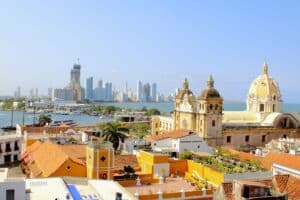
Colombia Safety 2024: Is Colombia Safe to Visit
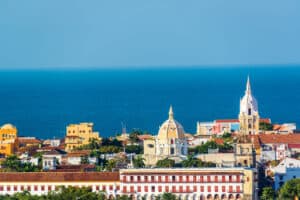
Cartagena Safety 2024: Is Cartagena Safe to Visit?
Your email address will not be published. Required fields are marked *
Save my name, email, and website in this browser for the next time I comment.
- Meet the Team
- Work with Us
- Czech Republic
- Netherlands
- Switzerland
- Scandinavia
- Philippines
- South Korea
- New Zealand
- South Africa
- Budget Travel
- Work & Travel
- The Broke Backpacker Manifesto
- Travel Resources
- How to Travel on $10/day
Home » South America » Travel Safety
Is Colombia Safe for Travel? (Insider Tips 2024)
You might be wondering “why is Colombia so dangerous?” Well, Colombia used to be considered one of the most dangerous countries in the world. Rife with violence, even as late as 2002, it had one of the highest homicide rates in the world. So some people thought I was on a death wish when I booked a one-way flight there.
But today it’s another story. With a BOOMING tourism sector, Colombia is now a popular destination with glowing beaches, dense rainforests, momentous mountains, and rich history.
However, though the civil war ‘officially’ ended in 2016, drug trafficking and militias are still active. So is Colombia safe? Or just how dangerous is Colombia?
Don’t worry. The Broke Backpacker team LOVE this country, so with this guide for safe travel in Colombia, you’ll have an amazing time AND stay safe whilst doing it!
We’ll look at whether it’s safe to use public transportation (spoilers: YES), safety in remote areas , getting around Colombia safely, and everything else in between. We’ll even talk travel tips for female solo travelers.
Whether you’re thinking about backpacking through Colombia alone or long-term, or if you’re just worried about an upcoming two-week trip, it’s ok. I’ve got you! Here’s the full story: staying safe in Colombia goes like this .
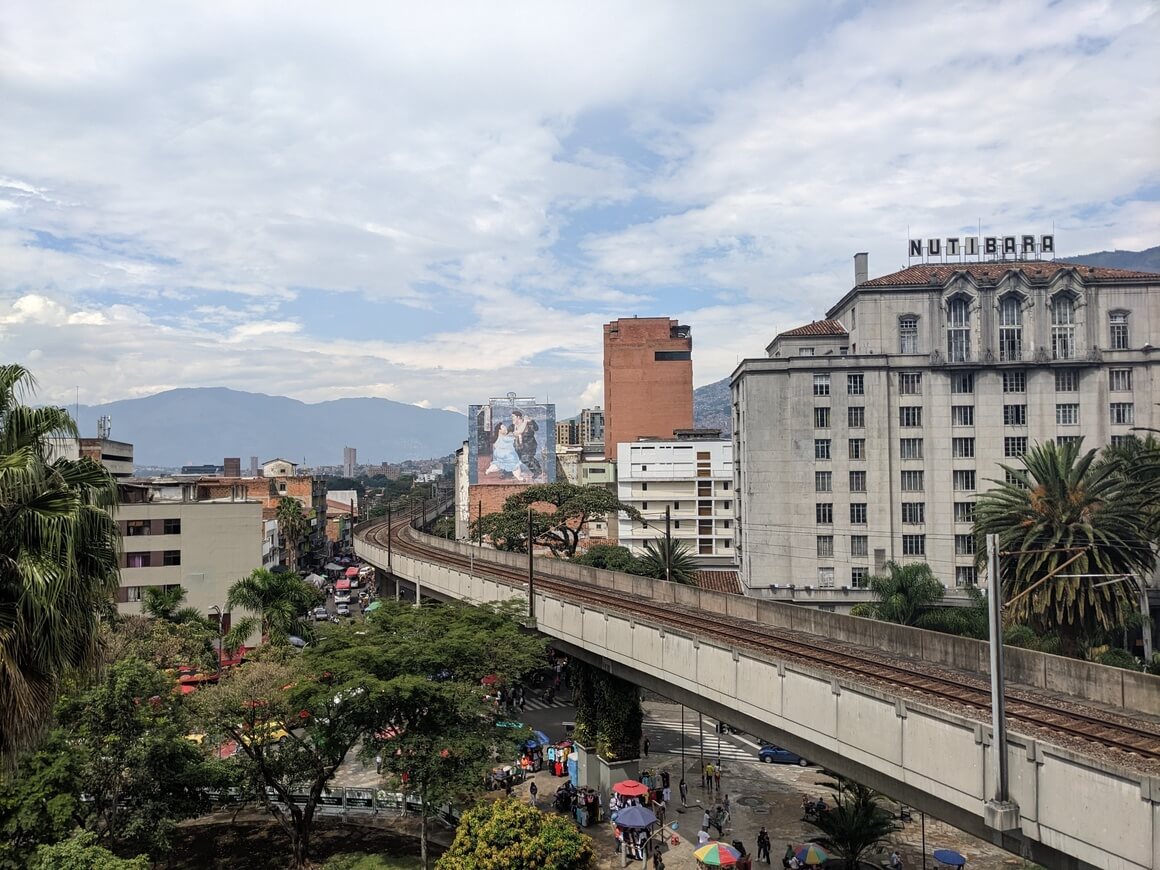
The Broke Backpacker is supported by you . Clicking through our links may earn us a small affiliate commission, and that's what allows us to keep producing free content 🙂 Learn more .
There is no such thing as a perfect safety guide, as things change quickly. The question of “Is Colombia Safe?” will ALWAYS have a different answer depending on who you ask.
The information in this safety guide was accurate at the time of writing. If you use our guide, do your own research, and practice common sense, you will probably have a wonderful and safe trip to Colombia.
If you see any outdated information, we would really appreciate it if you could reach out in the comments below. Otherwise, stay safe friends!
Updated April 2024
Is Colombia Safe to Visit Right Now?
Safest places in colombia, 19 top safety tips for traveling to colombia, is colombia safe to travel alone, is colombia safe for solo female travelers, where to start your travels in colombia, is colombia safe for families, getting around colombia safely, scams in colombia, what to pack for your colombia trip, getting insured before visiting colombia, faqs about staying safe in colombia, so, how safe is colombia.
Yes! It absolutely is safe to travel to Colombia , today. Around 5,188,312 international visitors were welcomed in Colombia from January to November 2023 as recorded by Ministry of Commerce, Industry and Tourism . Most tourists had a secured visit.
But let me flip that on its head too… Is it dangerous to backpack in Colombia? Well… yes, it can be too. It makes a huge difference to know a few tips for staying safe in Colombia.
Why is Colombia so dangerous? The truth is, most places in the world are dangerous in some form or another . Colombia has one of the fastest-growing tourist markets globally. It’s hard to argue with the millions of tourists who visit and leave totally unaffected.
Regardless of the status of travel advisories, Colombia is the new darling of South American travel . The country has been ‘rediscovered’ despite the misconception that it’s unsafe to visit Colombia.
You might think of Pablo Escobar and drug-related criminal activity, but today Colombia is becoming increasingly estranged from its violent past . Though not the safest place in the world, serious progress is happening.
So what do we have to consider with safety in Colombia? Crime rates remain relatively high but that’s mainly involving petty theft (mugging and pickpocketing) – so there are areas to avoid. Kidnappings and illegal armed groups are extremely rare now but are still a slight risk.
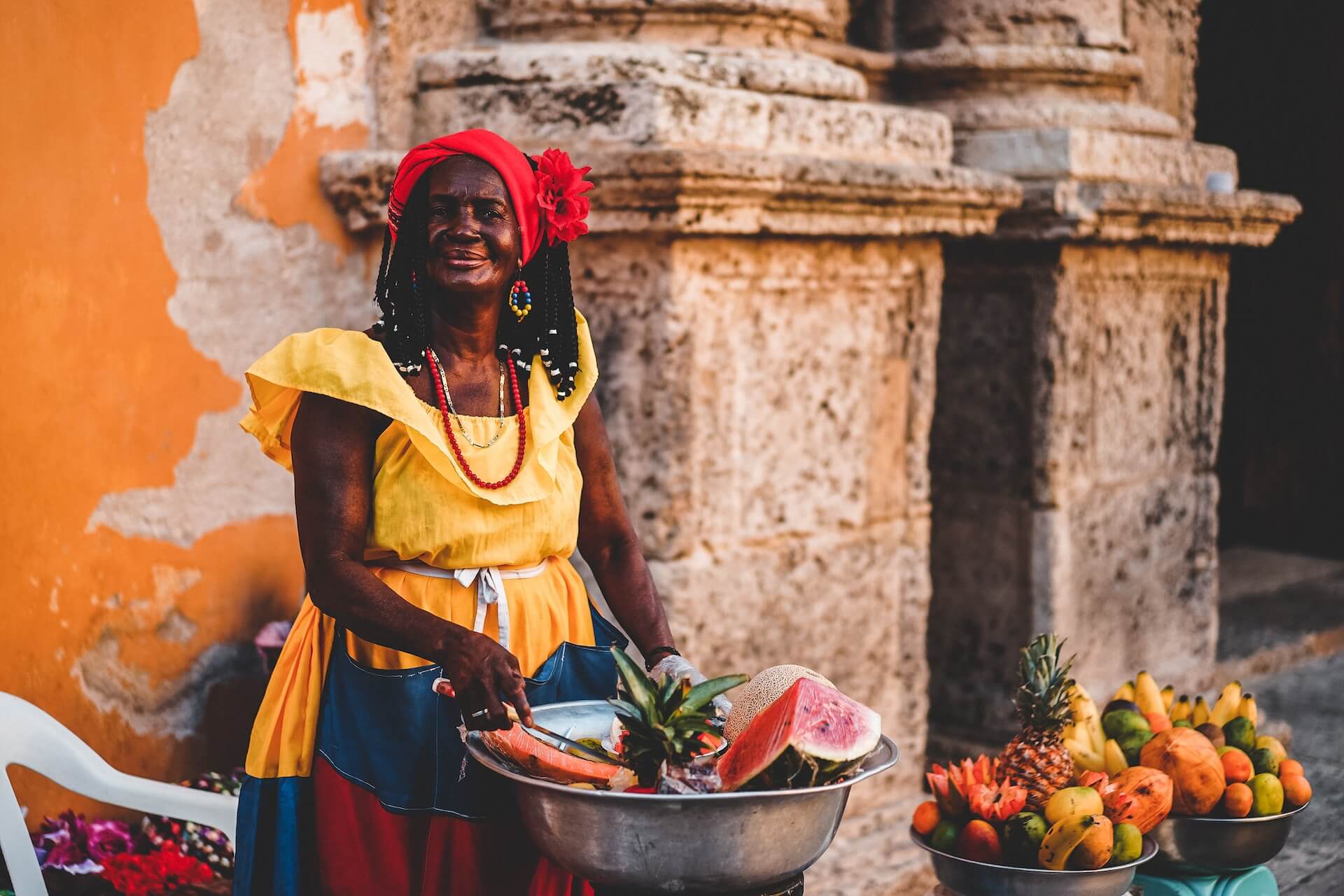
Landmines are an ongoing issue. Then there’s nature; earthquakes occur regularly, intense rains cause landslides, and there are dangerous critters lurking in the jungles. Needless to say, security situations can change pretty quickly.
However, that doesn’t keep the tourists away, nor backpackers, and it shouldn’t keep you away either . Tourism is BIG news here. Colombia is safe to visit these days with sensible heads on….
Stick to the main routes or go with a reputable tour company. If you’re visiting the Lost City , you have to book a tour. You may be backpacking, but sticking to the tourist routes is probably your safest bet right now.
In Colombia, when choosing a city to visit or good hostels to stay in , research and caution are essential. You don’t want to end up in a sketchy area.
To help you out, here are some of the safest areas to visit in Colombia below.
Quick side note: all of these areas we’re going to list below can be dangerous if you act carelessly. To stay safe, stick to our safety tips and use your travel common sense.
Don’t let the news and prejudices about this glorious country stop you. I’ve been backpacking in Bogota and other major cities and it quickly turned Colombia into one of my favourite countries. They can all be visited safely.
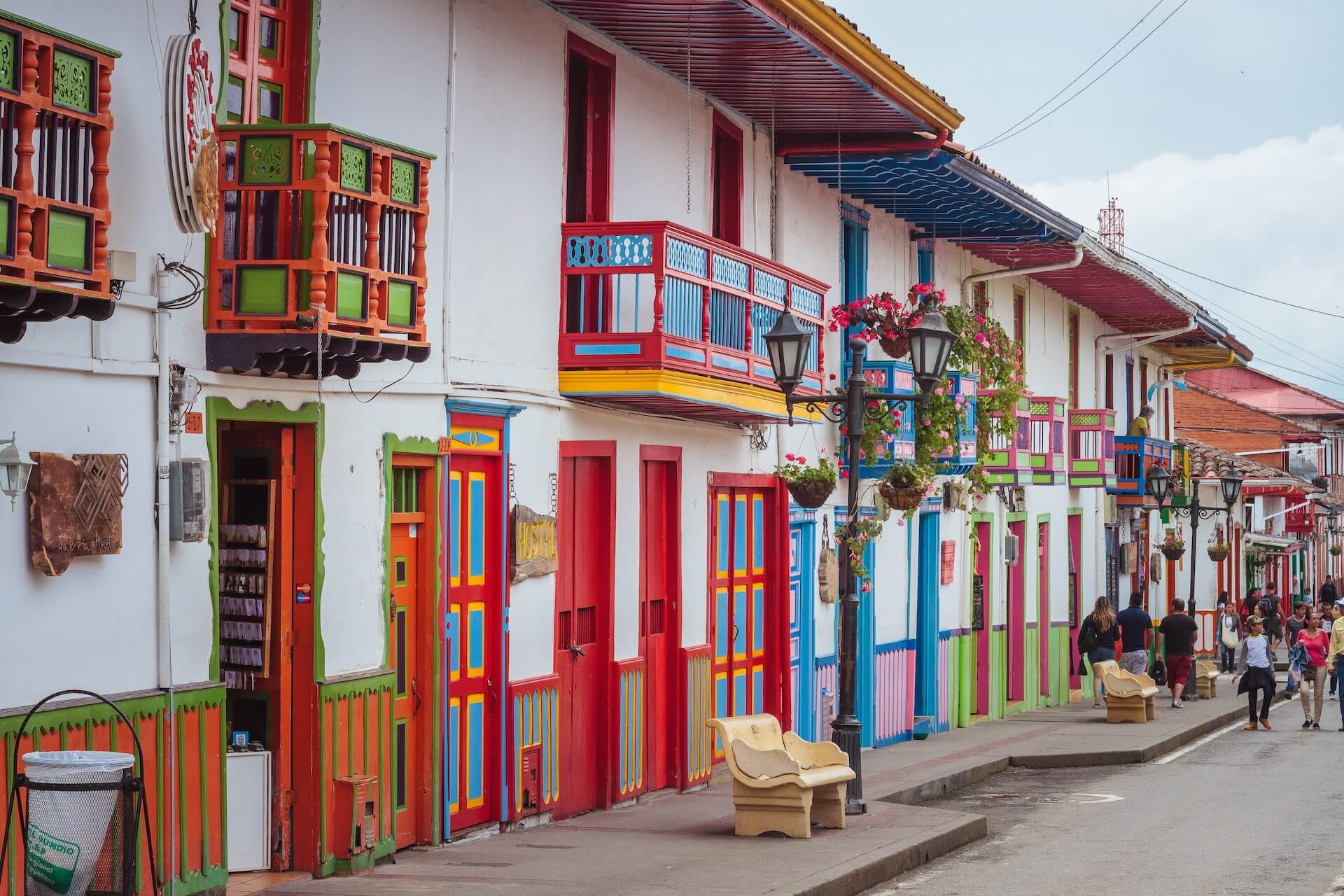
- Cartagena – On Colombia’s Caribbean coast, it’s an old port city within a walled city. When visiting Cartagena , Bocagrande is the safest neighbourhood to stay in – home to gated communities and wealthy Colombians with CCTV cameras and security everywhere.
- Medellin – With Pablo Escobar gone, life in the city changed: violent crime plummeted. In fact, today it’s safer than many other major cities in South America. One of the best areas to stay in Medellin is the Laureles Neighborhood.
- Minca – This little mountain town attracts floods of tourists. For that, you’re well protected and very few problems are reported.
- Eje Cafetero (The Coffee Region) – One of the most chill areas to stay in Colombia, you can explore beautiful, small towns and interact with friendly locals. Many towns are safe to walk around at night, too.
Dangerous Places in Colombia
We don’t necessarily align our thoughts with the US government, but this time we do and with good reason: I strongly recommend you take the advice. At present, the USA Government travel advice for Colombia restricts travel to these high-risk areas:
- Arauca, Cauca (excluding Popayán)
- Norte de Santander
- The Colombia-Venezuela border
There is absolutely no reason for tourists to visit these places anyway. Travel to Venezuela is an extremely bad idea in the current climate.
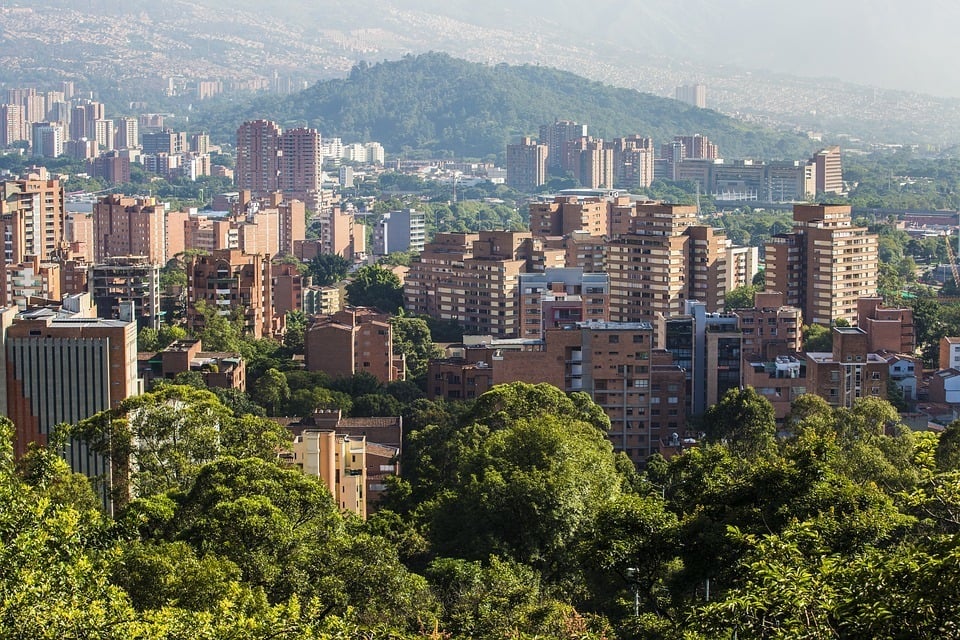
So yeah, not all places in Colombia are safe. Yet there are some places considered “unsafe” by some but can be visited safely – with extra precautions and vigilance. Here are some of those places:
- Cali (Santiago de Cali) – Cali is known to be Colombia’s most dangerous and violent city. You COULD visit it, but your overall safety will shoot up if you decide to stay away.
- Bogota – There are good reasons to visit the capital city and Bogota IS safe , but statistically it’s got the second highest crime rate in Colombia.
- Central Medellin – In general, this city is a safe destination for travellers, but avoid the city centre. This is where the vast majority of the problems are reported.
- Barranquilla – A super cool place to experience Carnival de Barranquilla , but a high crime rate for Colombia, in general. If you head to the festival, check out these hostels in Barranquilla where you can meet friends before getting out.
It’s important to know that you CAN be safe in Colombia, but you need research. Basically, your general rule is, the more tourists, the less chance you have of encountering serious issues: the second rule is the more tourists, the more chance you have of petty issues. So decide your balance between major cities and small towns.
Avoid ANYWHERE at night (unless locals tell you otherwise) and always ask locals which areas you should avoid. A bit of caution goes a long way!
Keeping your money safe in Colombia
One of the most common things to happen to you whilst travelling is losing your money. And let’s face it: the most annoying way for this to actually occur is when it’s stolen from you.
Petty crime is pretty much a problem all over the world.The best solution? Get a money belt.

Stash your cash safely with this money belt. It will keep your valuables safely concealed, no matter where you go.
It looks exactly like a normal belt except for a SECRET interior pocket perfectly designed to hide a wad of cash, a passport photocopy or anything else you may wish to hide. Never get caught with your pants down again! (Unless you want to…)
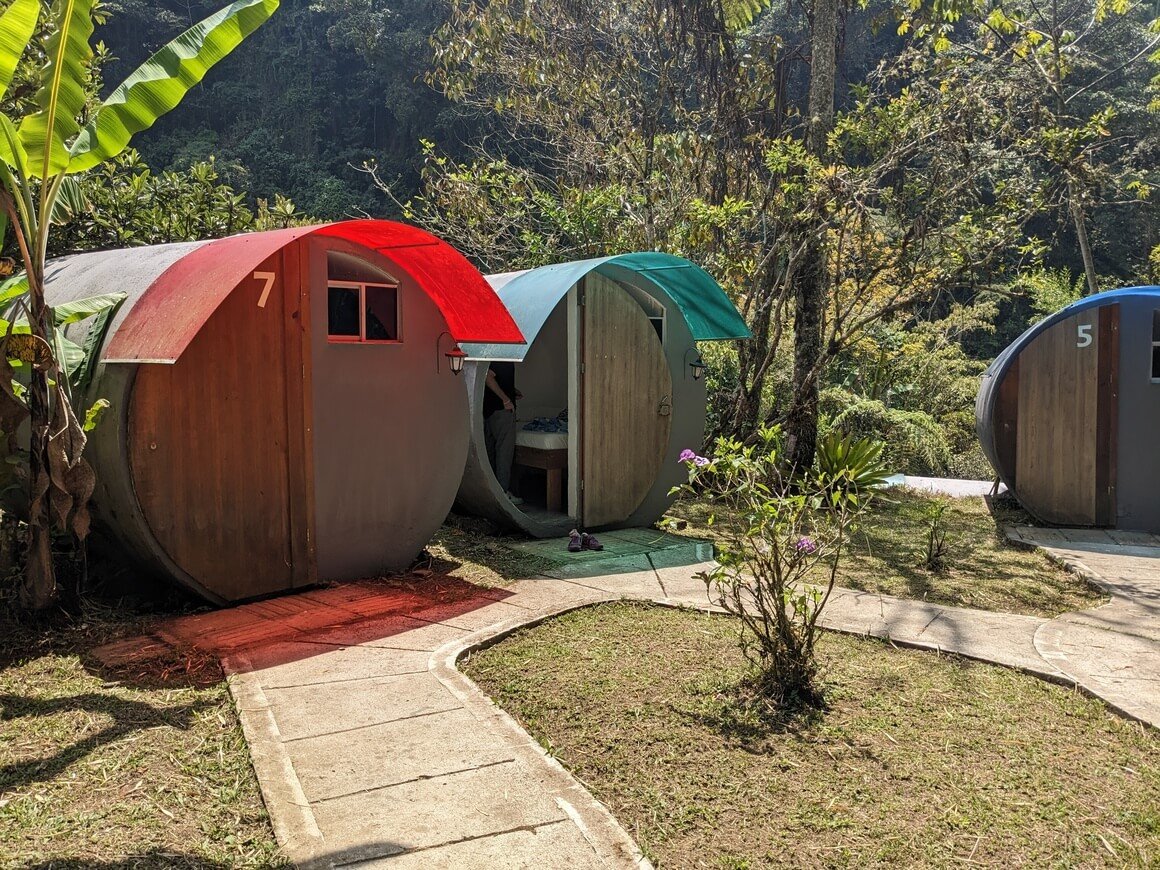
Most visits to Colombia are trouble-free. But knowing a few safety tips for Colombia really helps. Here are our top Colombia safety tips:
- Monitor local media – stay up to date with security issues and weather.
- Don’t look rich – ideal targets for potential thieves.
- Carry a decoy wallet – Have a few pesos in a crappy throwaway.
- Split your cash up – and hide it well . You DO NOT want to lose all your money at once.
- Say no to illegal cabs – no, no, no, no. Nope. Never a smart move.
- Don’t use ATMs after dark – thieves operate best at night and ATMs are the perfect spot.
- Always keep an emergency stash of cash – Never keep all your cards/ currency in one place. And hide it all from thieves with a hidden money belt .
- Carry a copy of your passport and visa – local cops don’t get paid a lot and can hassle tourists who don’t carry these.
- Learn some Spanish – this will get you far.
- Be aware of scams – more info on this to come.
- Be responsible with drugs – sensible head on at all times.
- Watch your belongings in crowds – an easy place for pickpockets.
- IF someone wants to rob you, don’t resist – your money, or your life, is not worth it.
- Go with a well-reviewed guides on treks – they know where to walk and will spot the venomous snakes that you’d step on.
- Know your limits – getting dead drunk, high, and exhausted isn’t a good idea.
- DON’T walk around at night – always get a cab.
- Take a good medical kit with you – you never know when you might need it!
- NEVER accept drinks or cigarettes from strangers – politely turn them down. Scopolamine spiking happens.
- Avoiding political protests and demonstrations – It’s not the time.
Safety tips for Colombia don’t vary much from anywhere else in the world. Staying safe isn’t too difficult. Traveling smart and trusting your instincts is key!
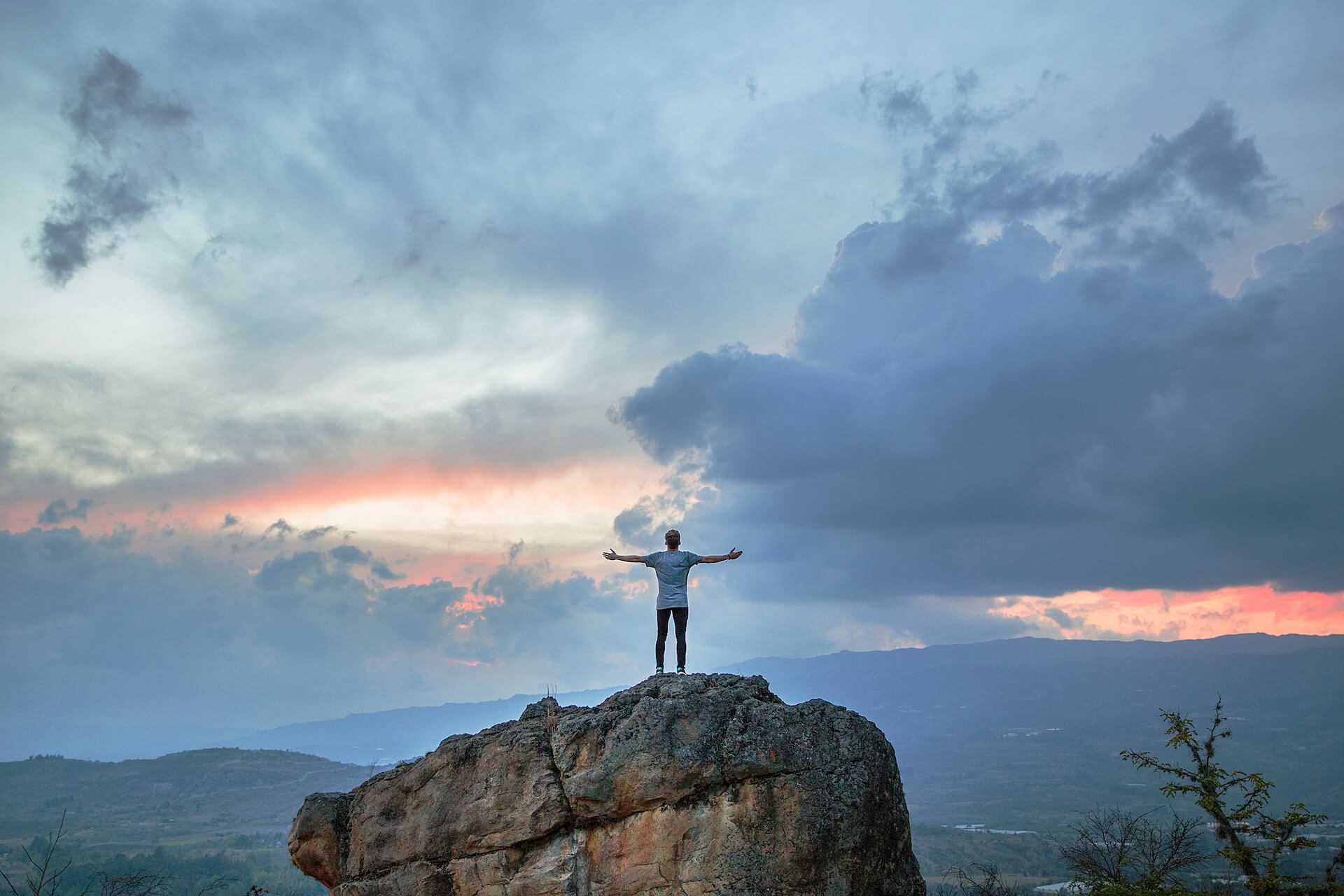
Yes, Colombia is safe to travel alone. However, that doesn’t mean you can wander around the country without a care in the world.
Here are a few travel safety tips for Colombia to keep in mind when you travel by yourself to Colombia.
- Meet other travelers – There’s safety in numbers. Plus, it’s the best way to beat the “solo traveling blues” and share travel tips.
- Read reviews – for staying in good hostels or going on organized tours.
- Blend in – Look at what other people are wearing. A singlet and short shorts isn’t always a good idea.
- The same goes for talking loudly – shouting around in English (or your native language) makes you stand out like a BEACON.
- Get some Spanish in your brain – If you’re lost, this will help you become un-lost. If you want to meet locals, this is how. Learning at least a little bit of Spanish goes very, very far.
- Trust your gut – If something doesn’t feel right, get out of there. Be smart, but also remember that Colombians are REALLY friendly in essence.
- Don’t listen to fear-mongering stories – Tourism is still in its infancy here meaning people are happy to see you and chat (which is why Spanish helps).
- Be aware of travel warnings – especially at border areas.
- Head out into nature, see the smaller towns, but stick to tourist areas where other backpackers are , and you’ll be fine.
I’m confident that Colombia is safe to travel alone. I know because I’ve done it and met many others who have too.
It’s not be the best place for a nervous first-time solo traveler, but if you’re smart and flexible, you’ll be better prepared for this amazing new experience and to be welcomed into a vibrant society!
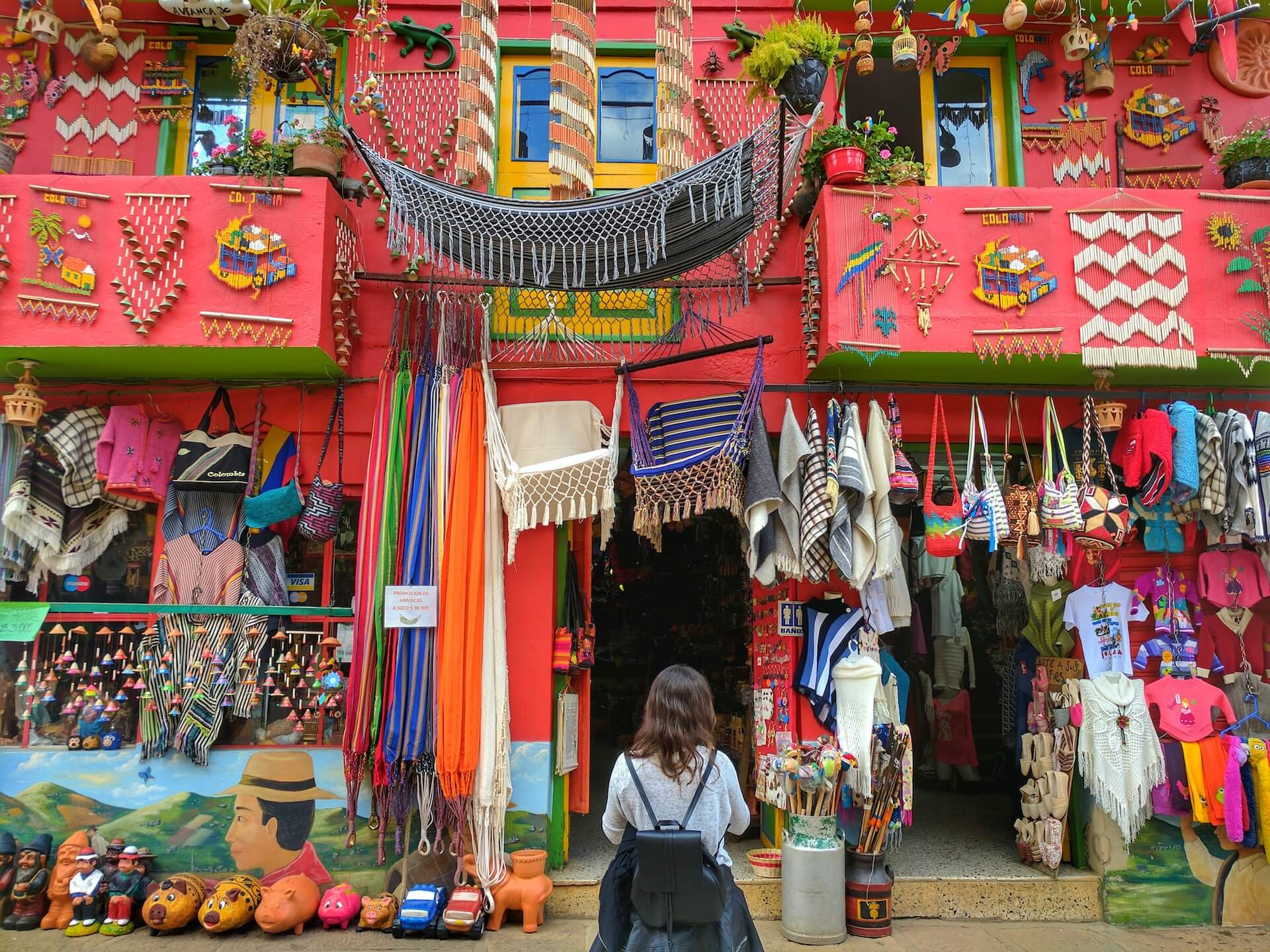
Well we’ve established that Colombia is safe for solo travelers. But when it comes to being a female solo traveler , there are always other things to consider – sad but true.
Everyone, regardless of gender, should be able to travel where they want. For that matter, a lot of women (despite audible concerns) travel to Colombia anyway.
It may not be the safest places in the world to visit for women travelling alone, but it shouldn’t be overlooked for women altogether. Many women travel to Colombia alone, perfectly safely! But here are some things to know:
- Colombia is still a pretty macho society – Catcalls are still accepted behaviour. Ignore it, walk by, and be confident. This is part of the culture and society you’re visiting and reacting won’t make your day any better.
- Dress according to the destination – some areas can be surprisingly conservative.
- Get a SIM card – Keep in touch with people back home.
- Do your research – Are there security concerns? Is this hostel good for solo females ?
- Don’t drink too much – Keep clear judgements.
- Remember: most of the violent crime you hear about is gang-related i.e. gangs attacking other gangs.
- Take taxis but DON’T hail one – Download a taxi app or get your hostel to call you one.
- Don’t leave your bag on the floor – even literally right next to you.
- Make a fuss – Shout and alert people nearby. This will likely spook any would-be thief. Ideally, get the attention of tourist police. Tourism is important for Colombia, and they want to make sure you don’t leave with any bad stories to take home with you.
- Try not to look lost – It’s a good way to look like a target.
Lastly, and most importantly, YOU CAN ALWAYS SAY NO .
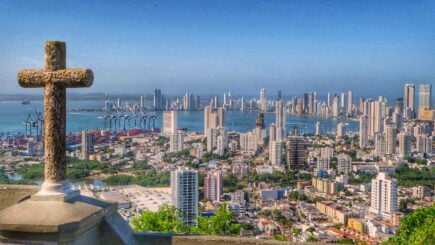
Cartagena (Bocagrande)
Cartagena can actually be a very safe place to visit, especially if you choose the right area. A very wealthy but also very secure area is Bocagrande. It’s a great family and expat heaven.
Is it safe to go to Colombia with your kids? Maybe you’ve watched too much Narcos, but if you’re thinking this is a drug-riddled war-zone, you couldn’t be more wrong.
It’s not easy, but most definitely Colombia is safe to travel for families. For example, the UK’s advice for travel to Colombia has no overall restrictions.
All sorts of tourists are heading to check out the hidden-in-plain-sight gem that is Colombia. Everybody’s welcome and that goes for families too.
Colombia is a country on the up. The arts and literary scenes are flourishing, tourism is booming, and you’ll be happy to know that Colombian culture is family oriented. There’s you as an individual – and then there’s the family as a whole, which is usually the center of a Colombian person’s life.
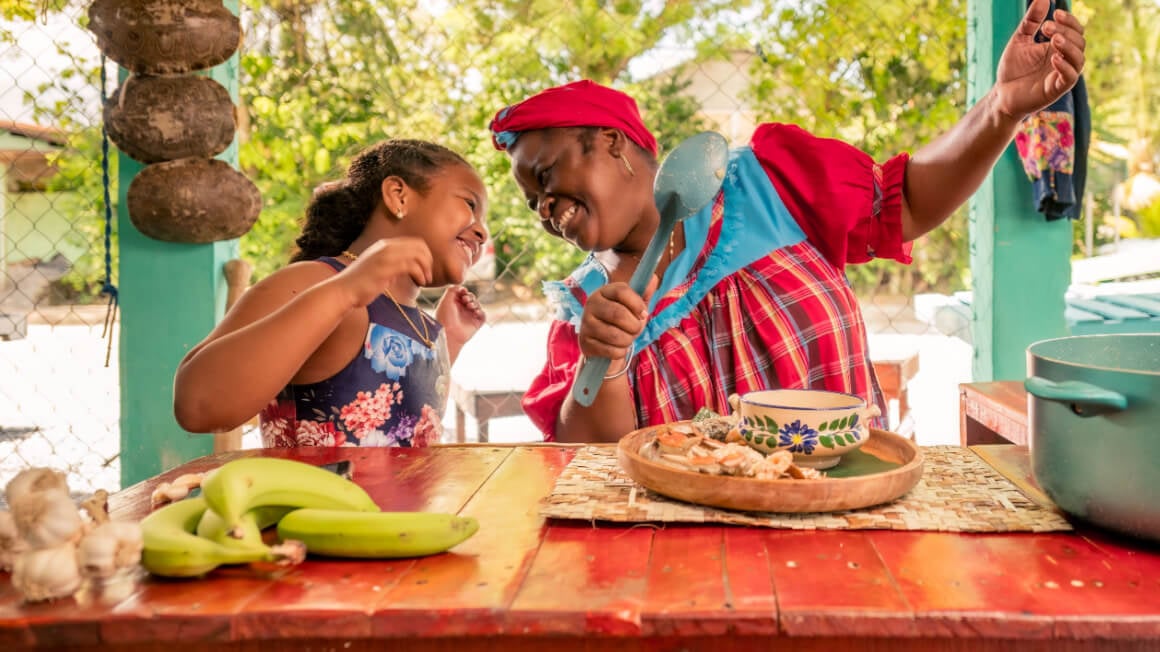
On top of that, family-friendly activities and adventurous outdoor exploration abound. You can spend nights in a jungle treehouse, play around on beach havens, and trek through cloud forests, amongst other things.
Without a doubt, Colombia is safe for families to travel. Take all the usual precautions that you would when traveling with children (medication, snacks, first aid kit, etc. etc.) and you’ll all have an unforgettable time.
Honestly, it’s not totally safe to drive in Colombia . Unless you’re a super-confident driver, it’s not worth the stress. If you’re planning on driving in Colombia, take extra precautions choosing your route.
Only take well-established routes between tourist areas. More rural areas put you at risk of being pulled over, questioned, or worse. Road conditions vary a lot.
Don’t drive at night. There are too many hidden hazards.
One thing I’ve learned in Colombia is that traveling on public transport is safer. Bus travel is your buddy in Colombia. Companies vary in levels of quality, so do your research.
Night buses are safe in Colombia. Though, comfort is a luxury here, especially traveling long-distance.
Colectivos (minibuses) or busetas (local buses) are used for short-distance travel. These are relatively safe AND cheap. Just always be aware of pickpockets.
Other than the Medellin Metro , there are no public trains in Colombia. Though there is the Turistren (yes, tourist train ) between Bogota and Zipaquira. It’s safe to travel by train in Colombia this way.
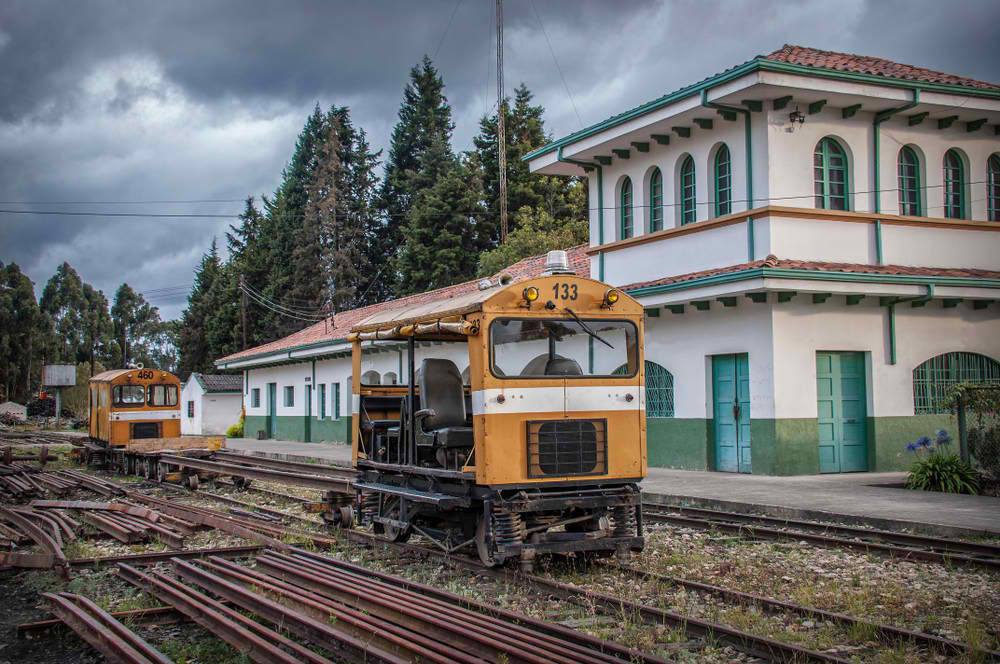
When using taxis in Colombia, ONLY USE OFFICIAL TAXIS . Ask your accommodation where to find these. Illegal taxis are active and you don’t want to find out the consequences of using them.
Better yet, Uber is safe in Colombia. They’re much safer and cheaper than taxis. They also have local taxi apps which work great.
Air travel is safe and convenient in Colombia if you don’t mind the carbon footprint. Overall, and surprisingly, public transport is safe in Colombia.
Pro Safety Tip: Downloading an app called Tappsi is a good way to check taxis. You’ll know the car’s registration and driver’s ID and they’ll log the journey.
So, unfortunately, scams do happen in Colombia and scammers target tourists. I wholeheartedly believe that most of them are not bad people: many are just less fortunate and scamming tourists is a quick fix for their situation.
Serious and violent crime is rare – express kidnappings, sexual assault, drug cartels, and murder shouldn’t scare you here, we want to avoid petty theft too. One of the best ways to avoid being scammed is to understand how they are practised. Here are some typical examples:
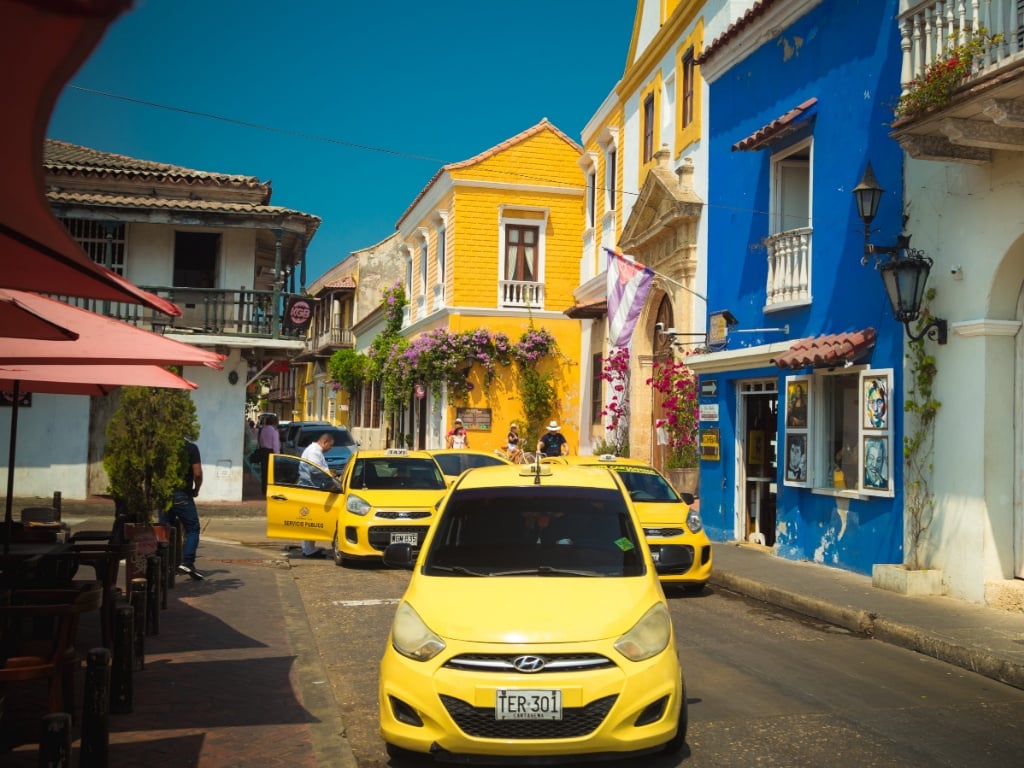
- The overpriced service – Ask for prices before you accept a service.
- Fake taxis – no, not that kind – actual fake taxis. Using them makes you vulnerable.
- The distraction techniques – “Look at this!”… then the pocket’s picked of unsuspecting victims. Ignore them.
- ‘Plain clothes police officers’ – These are people masquerading as police officers and after your money.
Generally, Colombias are super friendly. Sometimes it feels a bit eerie, especially in large cities. But really, most of the time they are just trying to be kind and inviting.
However, if someone is too close for comfort or it just feels weird, don’t feel bad for them to remove yourself from the situation. If someone is making you feel uncomfortable, don’t worry about making them uncomfortable. Your safety is always more important.
Everyone’s packing list is going to look a little different, but here are a few things I would never want to travel to Colombia without…

Hanging Laundry Bag
Trust us, this is an absolute game changer. Super compact, a hanging mesh laundry bag stops your dirty clothes from stinking, you don’t know how much you need one of these… so just get it, thank us later.

A decent head torch could save your life. If you want to explore caves, unlit temples, or simply find your way to the bathroom during a blackout, a headtorch is a must.

Yesim stands as a premier eSIM service provider, catering specifically to the mobile internet needs of travellers.

Monopoly Deal
Forget about Poker! Monopoly Deal is the single best travel card game that we have ever played. Works with 2-5 players and guarantees happy days.

This is a regular looking belt with a concealed pocket on the inside – you can hide up to twenty notes inside and wear it through airport scanners without it setting them off.
As soon as you know you’re heading to Colombia, prepare yourself with trusty travel insurance .
ALWAYS sort out your backpacker insurance before your trip. There’s plenty to choose from in that department, but a good place to start is Safety Wing .
They offer month-to-month payments, no lock-in contracts, and require absolutely no itineraries: that’s the exact kind of insurance long-term travellers and digital nomads need.

SafetyWing is cheap, easy, and admin-free: just sign up lickety-split so you can get back to it!
Click the button below to learn more about SafetyWing’s setup or read our insider review for the full tasty scoop.
Here are some quick answers to common questions about safety in Colombia.
What should you avoid in Colombia?
Avoid these things in Colombia to stay safe: – Avoid standing out or looking rich – Hand over the goods if you’re being robbed – Say no to illegal cabs – Don’t use ATMs after dark
Is Colombia safe to live in?
Yes, Colombia is generally safe to live in, and in recent years more expats are moving to Colombia, all of them enticed by warmer climates, nice people, and amazing scenery. Blending in is key, Spanish is a must, then you’re less prone to problems faced by tourists and backpackers.
What is the most dangerous part of Colombia?
Altos de Cazucá, also known as District 4 of Soacha, is the most dangerous part of Colombia. Travellers are advised to avoid this district completely. Soacha is located close to Bogota.
Can you drink the water in Colombia?
The tap water in Colombia is safe to drink in many places – but not everywhere. Colombia is working on their water systems and water treatment is improving . Check with locals when you arrive. In rural areas, it may pose health risks but bottled water is cheap.
Yes, Colombia is safe, but only if you take care.
It would be such a shame to miss out on Colombia because of scary stories that have come out of this country, based on an outdated reputation. Those days have largely passed. The incredible coffee, extremely friendly people, wild nature, epic major cities, mind-boggling landscapes and drastic beaches… how could you miss that?
Colombia still isn’t what we’d class as 100% safe. There are pickpockets, fraudulent taxis, occasional muggings, and people posing as local authorities. Be sensible, trust your gut, and monitor local media to help you avoid any danger.
Avoid anything political or security-related. Any isolated or deserted areas, you need not investigate. Respect local laws.
With this guide, you have an even safer destination. You now have a ton of travel tips with your safety in mind. Ultimately, most trips to Colombia are trouble-free, but stay clued up. With that, you’ll be less worried about potential dangers, and more interested in getting properly absorbed into this amazing country.
Remember the emergency number: 123 . Get the number down of your embassy too.
Then get booking your tickets! You’ll probably find one of us here too…
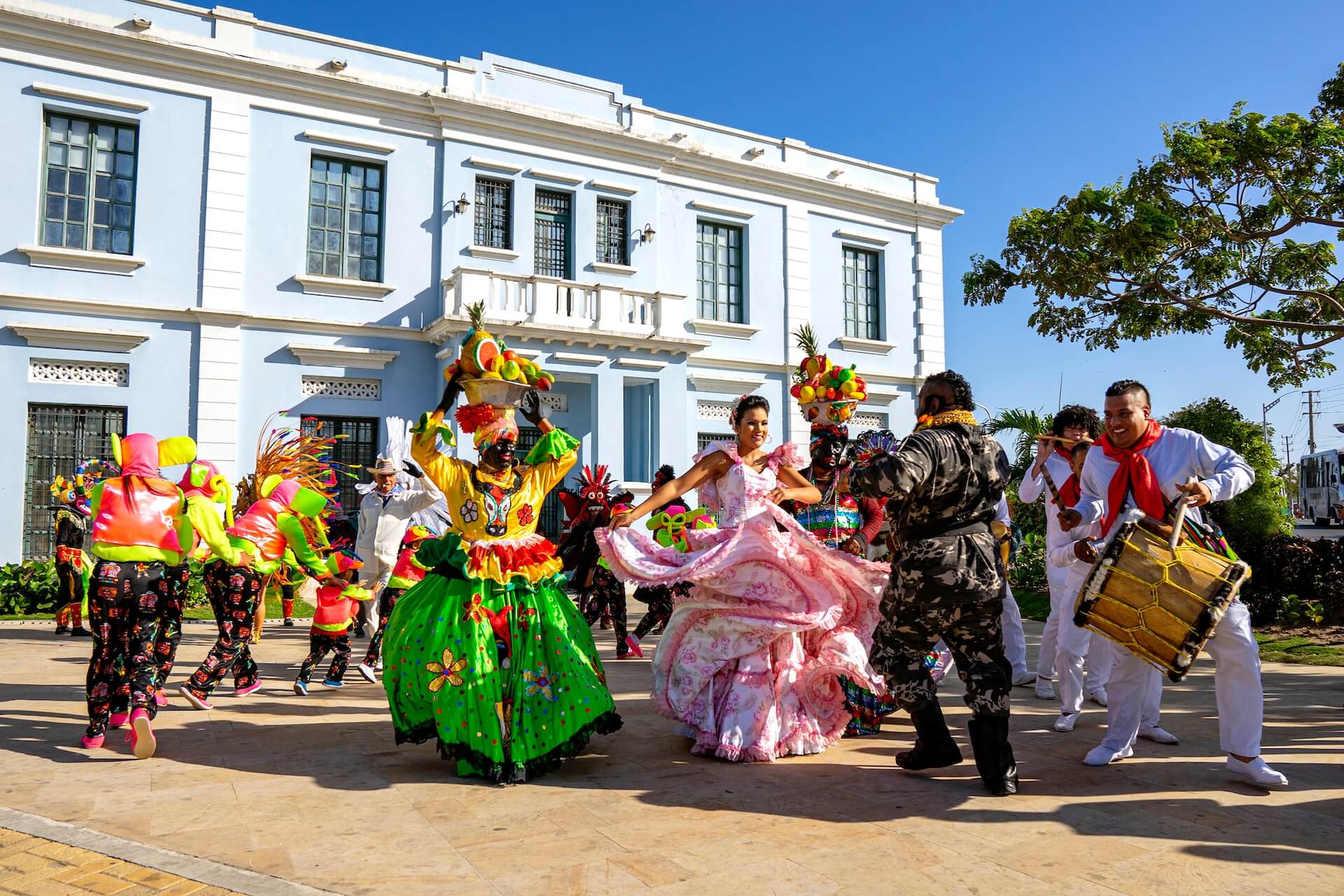
Looking for more info on traveling to Colombia?
- Get inspired by these EPIC bucket list adventures !
- Swing by one of these fabulous festivals
- Don’t forget to add an epic national park to your itinerary
- See exactly how to travel the world for a year , even if you’re broke
- Plan the rest of your trip with our fantastic backpacking Colombia travel guide!
Disclaimer: Safety conditions change all over the world on a daily basis. We do our best to advise but this info may already be out of date. Do your own research. Enjoy your travels!
Updated April 2023 by Laura Hall

Share or save this post

11 Comments
I find this guiding quite accurate. I have visited Colombia +20 times over the last 20 years and in most remote and rural areas. While most of the cities have progressed positively over the last 10-15 years due to foreign investment, tourism and increased job posdibilities some cities have went in the oposite direction, ex Caii, Palmira and Buenaventura. It was an interesting reading. I am travelling out of Cali tomorrow with my family after another great visit. Reg Inge
I live in Colombia and for me it is a beautiful country, People are still stuck in Pablo Escobar era, but that is in the past, I mean, saying like: “Germany is a dangerous country because of hitler”, Man that was long time ago. Same thing with Colombia, although Pablo Escobar was a little bit recent (1980, 1990) but it doesn’t mean that 1 person will change the way we look an entire country. Colombia can be dangerous, Nobody can’t say it is not. But I think people are still saying this country is dangerous because of 1 single person. Kinda unfair. And why seeing only the bad things? We can enjoy the amazing places, foods, traditions of this country. And we are not done yet. Colombia is still fighting to achieve our president’s goal of “total peace”. I am proud of this strong and persistent nation. And I will never stop being it.
Thanks for your comment.
Well the “Pablo Escobar” era wasn’t just dangerous because of one man was it? It was dangerous because of multiple, huge, powerful drug cartels warring with each other, with the government and then the para-militaries were also adding to the melee.
But yeah we agree, Colombia has turned a corner since then and is indeed a brilliant and beautiful country to visit. However comparing it to Germany is completely disingenuous, the fact is that street crime remains endemic and that obvious Gringo’s are a target – that is our first hand experience talking.
I think your opinion of Barranquilla is really wrong. There are obviously places you should avoid, but compare to other cities Colombia is relatively safe. As you said, you need to be always careful in some areas of the cities or avoid completely some neighborhoods, but to tell to avoid the city completely is just doing it an injustice. Yes, in Barranquilla there is not so much to see, is really not so much a tourist city outside of the Carnaval time, but still is a really nice place.
I can you tell you right now you’re opinion on Cali is wrong. It’s very clean, vibrant, friendly people, and the home of salsa. One of my favorite cities in Colombia!
Thank you very much for this article!
I agree, I am not from Colombia… I have been working in security matters over 20 years in other countries and recently I am working here (Colombia), theses tips we often use to show our expatriates persons to guarantee a productive and safe staying in this country. From my side you have 20 points.
Some cities are more dangerous than other ones, with more attention to the rural and borders area. We need to have in mind the proactive culture, do not give the opportunity to delinquents, you only need to follow the suggestings…
I’m Colombian. I live in Medellin. This article is pretty accurate. I love my country and we (colombians) hope that many foreing people can come and visit us.
Gracias por comentar! A lot of us on the Broke Backpacker team love Colombia too! <3
We were mugged at knifepoint in Medellin two days after our arrival. On the first day we were followed by shady individuals. No, Colombia is clearly not safe. We had read all the safety warning and were very worried about the security situation, but that did not help us (though we were not carrying anything of value except our phones).
I’ve travelled continuously for the past two years to some pretty bad places and would consider myself a very experienced traveler, but have never felt as unsafe as here. I would strongly advice against travel to Colombia.
Great article!
For a great country! 🙂
Leave a Reply Cancel reply
Your email address will not be published. Required fields are marked *
Save my name, email, and website in this browser for the next time I comment.
Notify me of followup comments via e-mail.
Spark Nomad
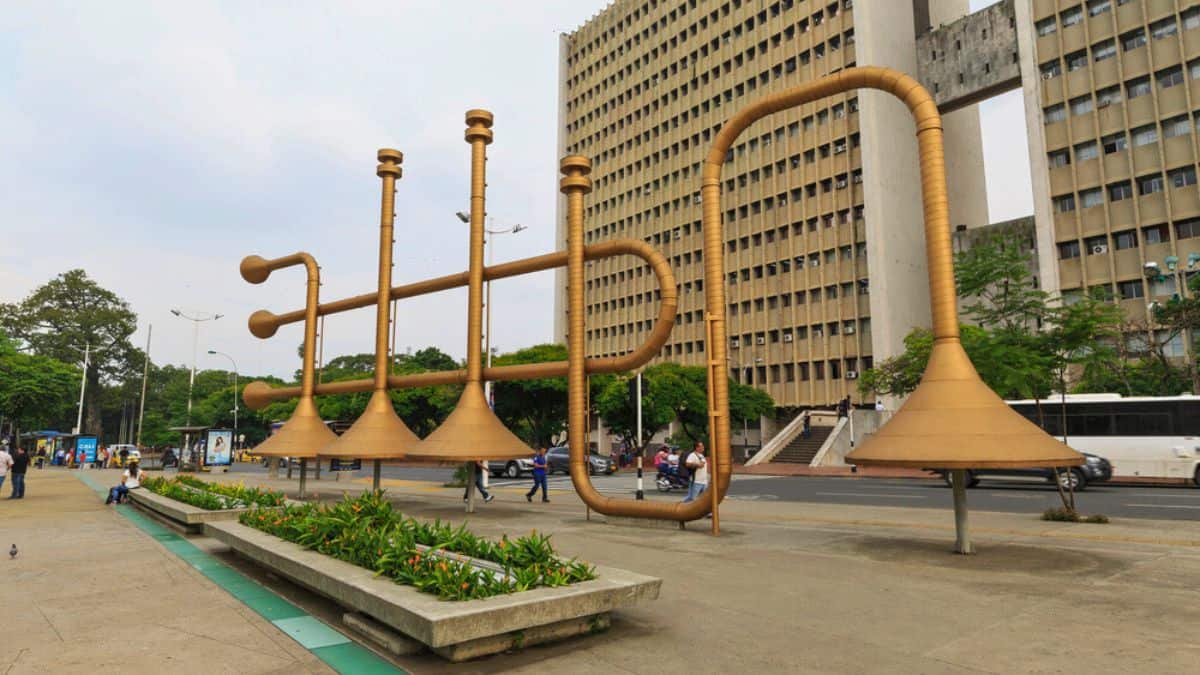
Is Cali Colombia Safe? – 11 Tips To Have A Peaceful Vacation
Are you thinking about visiting the salsa capital of the world, but you are wondering: is Cali Colombia safe? Here’s exactly what to be on the lookout for and how to feel perfectly safe in this incredible city.
No place in this world is completely safe. Even in the countries deemed as the “best places to live in” and “best cities,” your safety is not guaranteed. When you travel to Colombia or any other South American country, you have to manage the risks and avoid them by following the safety tips.
Being prepared to travel to this exotic Latin American locale goes beyond booking your accommodations and packing your sunblock. You need to learn all relevant information about this city’s security situation and tips on staying safe and enjoying Cali.
Read more to make your Colombia travel safe.
Table of Contents
Cali Colombia Safety
The risks involved in visiting Cali depend on the part of the city. If you know where to go and stay in Cali , you won’t have to face any unwanted situations. Criminal activity in Cali, especially property crimes, is a problem that still needs solving by the Colombian government.
There are many thieves roaming the streets looking for an opportunity. We advise you to watch your surroundings constantly.
The police in Cali are another major problem; they always find ways to fine you instead of helping you out. You may lose more money to law enforcement than to criminals, so it is better to take precautions to avoid this.
The reputation of this third-largest Colombian city as a tourist-friendly spot can use some help. Colombia placed 10 th on a list of the world’s most dangerous places to live . Still, if you ask, “Is Cali completely safe?” the answer would be, “No, it’s not 100% safe.”
However, the media has this habit of exaggerating things.
Despite all this negative publicity, we would still advise you to visit Cali to experience that this city is not as dangerous as it is reputed to be. You just need to be informed, alert, safety-conscious, and street smart. I was perfectly safe in Cali when I was in my early 20s, traveling solo as a female.
How To Stay Safe In Cali Colombia
Concerned about the possibility of illness, scams, robbery, and cancellations while traveling? It’s crucial to get travel insurance to ensure that if an unfortunate event does occur, you can cover your losses. I always have travel insurance whenever I leave home.
For digital nomads and long-term travelers, SafetyWing provides convenient and cost-effective plans that are tailored to their specific needs. With their budget-friendly monthly plans, excellent customer service, and user-friendly claims process, it’s an ideal solution for individuals on the move.
To get a quote right away, utilize the widget provided below:
What Are The Safest Neighborhoods In Cali?
There are a lot of neighborhoods in Cali that are tourist-friendly. If you stick to these areas without exploring every other place you hear about, you will probably have a safe trip.
Areas such as Cuidad Jardin or Barrio El Peñon are the best places to find many activities. Because of the huge crowds in these places, you have a very low chance of becoming a robbery victim.
Another great neighborhood to visit is San Antonio. If you visit, you’ll know why they call Cali the world’s salsa capital . Although these neighborhoods are considered safe, we advise you to remain aware of your surroundings.
Other neighborhoods, such as Santa Monica, Granada, and Juanambú, are highly rated regarding safety. These are the places where most travelers prefer staying, so if you are looking for a place other than these, please read the safety tips to ensure that you return safely from your trip.
Where To Stay In Cali Colombia
Hotel farallones cali (budget).
Hotel Farallones Cali is close to Saint Peter Cathedral, just a short walk away. It’s a simple hotel in Cali with a shared space for guests to relax. You can find a reception desk open all day and night, plus they offer room service. The hotel also has free WiFi everywhere. They have rooms suitable for families, too.
Granada Real (Mid-range)
Granada Real offers various amenities, including a restaurant, a 24/7 front desk, and room service. Additionally, free Wi-Fi is available throughout the property. Certain rooms also have a patio offering views of the city.
Hotel Intercontinental (Luxury)
In downtown Cali, Hotel Intercontinental offers cozy rooms in shades of gold and peach and complimentary WiFi. The well-lit rooms feature wooden floors and are equipped with air conditioning, cable TV, and queen-size beds.
For more accommodation options, you may click on the map.
Places To Avoid
Some dangerous places are in the city, and we highly advise foreigners like you not to visit. These include neighborhoods like Siloe, Aguablanca, and Terrón Colorado. The streets in these places are not as safe as the rest of the city, so try to avoid going there or just take a cab.
Some places are safe to visit but only for a certain period. One of them is El Centro, where taking a cab after dark is advisable. It is a marketplace where pickpockets look for an opportunity disguised in large crowds. We recommend not staying there till late at night alone.
Risks Involved In Visiting Cali
Considering the risks before visiting any place is the key to proper safety. Taking precautionary measures after identifying the risks involved makes it easy to handle difficult situations and sometimes avoid them altogether.
We have listed some risks involved in visiting Cali.
Taxis are the best mode of transportation in Cali, and the risk of getting into trouble while traveling in them is pretty low. The fares fluctuate depending on the day and time you travel, but it’s always safe and reliable.
Cali’s crime rate has improved a lot in the last couple of decades, but the danger of robberies still looms over the streets of some neighborhoods. You have a high chance of getting pickpocketed if you look like a tourist showing off your expensive phone and watch.
Natural Disaster
Natural disasters are common in Colombia, and Cali is no exception. Hurricanes, earthquakes, and volcanic eruptions can be seen occasionally. Landslides and floods are other issues the locals often face, especially after heavy rainfall.
Scams are not seen as often as other crimes in Cali but beware of drug pushers as they might approach you to sell drugs. Do not, under any circumstances, buy drugs from them, and you have a high chance of getting scammed if you do so. Refuse them politely and move on from that place as soon as possible.
Solo Females

Foreign women are not as safe on the streets of Cali as in other parts of Colombia. This may be because Cali does not receive a lot of tourists, and a solo female walking alone on the streets has a higher risk of becoming a mugging target.
So, female solo travelers, we advise you to stay off the dangerous neighborhoods, walk with someone, or take a taxi instead.
11 Tips to Stay Safe In Cali
There are a few tips that can help you avoid any unwanted situation. Please follow all these tips carefully to get the best out of your Cali trip.
1. Dress Like Locals
Dressing like locals will make you less visible to potential pickpockets roaming around. They will think of you as a poor local with nothing valuable to offer, protecting you from getting targeted.
Even if you’re blonde or have blue eyes, not wearing extremely fancy or expensive clothes will already do the trick.
2. Avoid Drugs
There are a lot of drug dealers in Colombia, and Cali is no different. Unfortunately, there’s still a lot of drug tourism in Colombia. However, the people in Colombia try to get as far away from drugs as possible, as it is the cause of so much bloodshed in their country.
Try to stay away from drugs when visiting. Especially when people randomly approach you on the street, reject their offer, and get away from that place quickly.
3. Don’t Carry Valuable Items
No Dar Papaya is a popular quote in Colombia. It means not making yourself an easy target for thieves. This includes carrying valuable items to show off on the streets, so please keep your items at the hotel.
4. Be Conscious of Streetwalkers
Some of the most beautiful Colombian women and transgender people walking the streets at night can be prostitutes. Keep that in mind, and be prepared to approach them.
5. Learn Some Spanish
It’s best to learn Spanish to help you communicate with the locals. Many Colombians can help you understand the Colombian culture well, allowing you to handle any bad situation better.
6. Carry Little Money With You Outside
We advise you to carry as little money as you can with you, preferably using ATMs or debit cards for transactions. They are much safer to carry on the streets of Cali.
7. Use a Taxi or Uber
Walking on the streets can be risky, especially at night, so try using Uber or a taxi. Taxi drivers are friendly and help you get to your destination without any trouble.
8. Hire a Local Guide
If you want to know more about Cali and prefer to be accompanied by someone, hire a guide to help you plan your trip. They can also help you decide which places are safe and worth visiting.
9. Don’t Use Phones on the Streets
The expensive smartphone is a luxury that more than half of the people of Colombia can not afford. So, it is an unsafe move to use it on the streets, especially at night; it can attract thieves and make you an easy target.
10. Keep Your Backpack in Front
If you carry valuable items in a backpack, we recommend keeping them in front, making it harder for people to unzip them and get your valuables out.
Another solution to this problem is to wear a money belt , where you can keep your cash and valuables like credit cards.
11. Be Alert
If you choose to walk on the streets or commute alone, you will have to pay proper attention to the surroundings. Stay at a place with a lot of people nearby to avoid getting robbed.
Frequently Asked Questions – Is Cali Colombia Safe?
Is cali colombia safe for tourists.
Cali, Colombia, is safe for tourists if they take safety precautions seriously and adequately. Although it is not well-known for tourism, Cali still has a lot to offer visitors. It can provide a complete package, from its vibrant Cali nightlife to wonderful activities to sensational sights.
Please make sure that you visit the places that are tourist-friendly. Some neighborhoods receive more tourists than others, making them safer to visit. However, if you are an explorer who wants to experience every side of Colombia, you must carefully consider the risks before making any decision.
Is Cali Colombia Poor?
Some neighborhoods are poorer than others, and you should avoid them. Some of them are Siloe and Aguablanca, where there is not much for tourists to see or experience.
A regular bike here costs more than half the income of half the locals living in Colombia, reflecting the country’s economic condition. This will give you an idea of how luxurious your $1,000 phone will be for the people living there. So, staying low-key without showing off your valuable items is better.
Conclusion – Is Cali Colombia Safe?
When you visit Colombia or other Latin American countries, one of the things you should check is security.
This article may sound like a complete warning to stay away from Cali, but it is not. Like other cities globally, Cali has its share of high crime rates and danger zones, perhaps more. Similarly, Cali–with its famous salsa culture, vibrant nightlife, and amazing events–also has more to offer.
So, is Cali, Colombia, safe? It can be, but only if you take the necessary precautions, like the ones we shared in this post. The answer is a toss-up between taking smart, informed risks to live more colorfully or staying on the super cautious road.
A visit to Cali is bound to be a most memorable experience with all the best things to do in Cali . Making Cali a safe destination for you is in your hands.
Your Ultimate Travel Guide & Booking Resources
Skyscanner is my trusted ally for booking flights, guiding me to the perfect travel options while making the journey planning process a breeze with its user-friendly interface and extensive search capabilities.
12Go Asia is my ultimate travel companion in Asia, offering the best budget service platform for seamless booking of trains, buses, ferries, and flights, ensuring every adventure unfolds smoothly and effortlessly.
Booking.com is my ultimate lodging partner. It offers many accommodations worldwide and simplifies my travel experiences with its user-friendly platform and unbeatable deals.
Get Your Guide is my go-to for personalized travel experiences, enriching my journeys with unique tours and activities curated to my interests, making every adventure unforgettable and tailored to my preferences.
SafetyWing is my peace of mind on the go, offering comprehensive travel medical insurance with affordable plans and hassle-free claims, ensuring I can explore the world worry-free, knowing I’m protected wherever I roam.
LifeStraw Go Bottle is my trusted hydration companion for outdoor adventures, filtering water on-the-go to keep me safe and hydrated, ensuring every hike or travel experience is worry-free and enjoyable.
Related Reads:
- Where to Stay in Medellin, Colombia: 5 Best Places To Stay In The City
- Medellin Colombia Nightlife: 2022 Guide To Best Bars and Clubs
Founder of Spark Nomad, Radical FIRE, Copywriter
Expertise: Personal finance and travel content. I’m a full-time traveler, and I’ve been to 49 countries and 5 continents. Education: Bachelor of Economics at Radboud University, Master in Finance at Radboud University, Minor in Economics at Chapman University. Over 200 articles, essays, and short stories published across the web.
Marjolein Dilven is a journalist and founder of Spark Nomad, a travel platform, and Radical FIRE, a personal finance platform. Marjolein has a finance and economics background with a master’s in Finance. She has quit her job to travel the world, documenting her travels on Spark Nomad to help people plan their travels. Marjolein Dilven has written for publications like MSN, Associated Press, CNBC, Town News syndicate, and more.
Why You Shouldn't Be Afraid to Go To Cali
Generally, Cali is a safe place to travel (with a little know-how!). But like elsewhere in the world, Colombia has seen cases of coronavirus.
Check out our update below.
Table of Contents
Update: covid-19 in colombia, uber is always a safe bet, safety starts where you stay, most crimes are those of opportunity, learn the local lingo.
Like many cities, Cali has been hit by COVID. However, by following the local rules, a fun and safe trip to Colombia is possible.
COVID safety requirements in Cali, Colombia:
- Travelers must be vaccinated or have a valid negative COVID test before they can enter Colombia.
- Travelers must show proof that they received the final injection of the series more than 14 days prior to travel. Otherwise, a PCR test taken no more than 72 hours prior to arrival or an antigen test taken no more than 48 hours prior to arrival is required.
- The Check-Mig registration form is required and must be completed 24 hours prior to arrival. Travelers can complete the form on Colombia's government website , or use services like iVisa that simplify and streamline the process .
Cali locals can help you navigate the rules and give you the inside scoop on where to learn and practice salsa dancing.
Know where to avoid—and where to party!
Cali is one city where it’s not a bad idea to stay on the beaten path—neighborhoods like Ciudad Jardin and Barrio El Peñon are traveler-friendly with Instagram-worthy photo ops worthy of the best cities in Colombia . San Antonio is home to salsa clubs on every corner, with thumping beats pouring into the streets. Normandia is a great place to stay, with plenty of Airbnbs and hotels for travelers of all types. Like any city, however, Cali has a few places to steer clear of. For instance, you likely won’t want to be wandering around Siloe, Aguablanca, or Terron Colorado ensure you won’t accidentally wander into a neighborhood you shouldn’t, choose one of our Colombian travel planners to build you a custom offline map for your smartphone!
Uber is a great way to get around Colombia , and Cali is no exception. Some travelers report being overcharged or having communication issues with regular cab drivers, so Uber can help avoid this hassle altogether, and can help you stay safe on your Colombian adventure .
When you stay in Cali, you might want to consider staying somewhere with a doorman or a front desk area. Options like hotels, hostels, and nicer apartment buildings will likely have someone to greet you before you enter your room. This ensures no one is entering your building who shouldn’t be—thus keeping you safe on your Colombian sojourn !
Petty crime is by far the largest issue in Cali, and petty crime relies largely on . Fortunately, the best deterrent comes down to education and awareness! By following the same advice you would take in any large foreign city, you can be sure you’ll be safe while you explore Colombia . Don’t give thieves the opportunity to ruin your trip: lock up your windows, doors, and valuables. Make sure your camera and phone are stored safely, especially when you’re out in Cali’s famous salsa clubs! Another tip on staying safe, especially for solo female travelers , is to carefully watch your drink—you never know who could be up to no good! Our Colombian travel experts can give you more insight into common scams and issues faced by travelers to Cali.
Want to know an awesome way to ensure your safety, get where you’re going, and make new friends? Learn some Spanish! When you’re hitting the dance floor in one of Cali’s salsa clubs, you’re going to want to know your from your . Here are some great phrases to know:
- “Where is …”→“¿Dónde está …”
- “How much is …”→“¿Cuánto es …”
- “I need help”→“Necesito ”
- “Hello”→“Hola”
- “Thank you”→“Gracias”
- “Where is the bathroom”→“¿Dónde está el baño?”
- “Do you speak English?”→“¿Habla Inglés?”
Ready to plan your own Cali adventure? Reach out to one of our local travel experts or message us directly to create your own personalized travel itinerary. And b efore your trip, make sure to check out:
- Connect With a Local to Plan Your Trip
- Colombia FAQs
- Colombia Itinerary
- Colombia Visa Requirements
Looking for more info?

Is Cali Colombia Dangerous? (Safety Tips, Safe Neighborhoods, & More)

Planning a trip to Colombia, but wondering if Cali is a dangerous place to visit?
As a former Colombia resident and traveler all over the country, I’ve got all the expert need to know safety info for Cali.
While Cali had quite the dangerous past, it’s now a great place to visit in Colombia that’s typically safe (I visited as a solo female) as long as normal precautions are taken.
➡️ Our Top Pick : To avoid wandering the city alone, taking a best sights in Cali tour is a safe & easy way to explore.
🇨🇴 Overview: Is Cali, Colombia Dangerous?
While I lived in Colombia , I often traveled around the country alone as a solo female , so I was always paying attention to safety.
👉 Because of my experiences & local knowledge of Colombia, I can share details about whether or not Cali is still dangerous, give tips to help make it even safer, & share the dangerous areas to avoid & the safe places to stay here.

⚠️ Is Cali, Colombia A Dangerous Place To Visit? (Facts & Statistics)
For those unfamiliar with the history of Pablo Escobar, the rival Cali cartel played a huge role in this drug war back in the 1990s & it was one of the most dangerous places in Colombia.
Before moving here, I studied history (lots of Latin American) and I wondered how much things had changed , & if places like Medellín or Cali were less dangerous than they used to be.

👉 While there are still some echoes of this dangerous past today in parts of Colombia, including Cali (particularly the eastern side), it’s now a much safer place to visit and both the city & the country are very much worth visiting .
📉 Cali, Colombia Statistics
- Cali’s Homicide Rate Peaked In 1994
- Cali, Colombia Was One Of The 10 Most Dangerous Cities In The World
- 50% Of Victims Were Intoxicated Or At A Bar When Killed
- Enforcement Policies Led To A 50% Decrease In The Homicide Rate By 1997
- A 2012 Effort To Fight Crime At The National Level Led To A 25% Decrease In Homicides Within 2 Years
- Since 2012, Homicide Rates Have Continued To Gradually Fall

Is Cali, Colombia Dangerous For Solo Female Travelers?
When I lived in Colombia, I traveled alone to cities & towns all over, including Cali. I explored the city a little on my own & took a city tour with a group to avoid dangerous situations as much as possible, but I never felt unsafe here.
*️⃣ Tip : Be aware of surroundings, avoid flashy fashion, be inconspicuous with tech, & make smart decisions to be as safe as possible in Cali, Colombia.
Is Cali, Colombia Dangerous At Night?
Like most larger cities, Cali, Colombia becomes a little more dangerous at night , especially for those traveling alone and/or females.
There are more vulnerable scenarios at night, so be extra cautious & avoid them as much as possible.

*️⃣ Tip : To explore Cali (or any city in Colombia) at night, go on tours , stay in groups, stick to tourist areas, arrange private transfers, & use highly rated ride-shares to avoid dangerous situations as much as possible.
ℹ️ Tips To Make Cali, Colombia Less Dangerous
Always be proactive about safety when traveling , especially alone, but don’t be afraid of Colombia, just use some of these safety tips to be extra safe here:
- No Dar Papaya : the number one safety rule in Colombia means not allowing easy or obvious opportunities to be taken advantage of (waving around a $1000 phone for example), & not getting into vulnerable situations (walking alone on an empty, dark street for example)
- Don’t Hail Taxi’s Off The Street : taxi’s are notorious for being dangerous in Colombia so public transportation, ride-shares, tours, or private transportation are better in Cali
- Keep To Busy, Tourist Areas : parts of Cali, Colombia are still dangerous so stick to tourist areas, stay in groups, don’t flash expensive things, & always be aware

- Don’t Carry Around All Money/Credit Cards : don’t carry everything; keep some at the hotel, in a wallet, a pocket or sock, or even an inconspicuous money belt
- Don’t Take An Actual Passport Out : when going out, don’t carry an official passport, instead make a couple copies and use those
- Avoid Street Food : although it’s cheap & tasty, it’s easy to get sick from street food; avoid it to stay healthy, especially for those with food allergies or a clean lifestyle

- Take Toilet Paper Everywhere : cities shouldn’t be much of a problem, but in small towns (like San Agustín or Salento ) or out hiking, not all bathrooms will have free toilet paper
- Avoid Airbnbs : we’ve had many problems & we know others who had problems with Airbnb in Colombia , so unless a host is highly rated with lots of reviews, we suggest sticking with hotels in Cali

*️⃣ Tip : Cali is actually a decent city to find allergy friendly, vegan , or somewhat healthier food options.
🛑 Dangerous Areas To Avoid In Cali, Colombia
Although there’s typically no reason to go to them anyway, these are the more dangerous neighborhoods to avoid in Cali, Colombia:
❌ East Side Of Cali (absolutely don’t go here) ❌ Manuela Beltran Neighborhood ❌ Aguablanca (Comuna 13, 14, 15, & 21) ❌ San Antonio (at night) ❌ Alameda (after dark) ❌ Comuna 20

🏨 Safe Places To Stay In Cali, Colombia
The 2 best safe neighborhoods to stay in Cali, Colombia are El Peñon & Granada (parts of San Antonio are okay, but it’s more sketchy/dangerous at night).

👉 Best, Safe El Peñon Hotels :
- Hotel Obelisco
- Hotel Dann Cali
- Hotel Dann Carlton Cali
- Hotel El Peñon
👉 Best, Safe Granada Hotels
- Cali Marriott Hotel
- Leclerc Hotel Boutique Cali Granada
- Hotel Stein Colonial
- Hotel Casa del Hidalgo
*️⃣ Tip : Cali’s a popular place to visit in Colombia, but it’s not somewhere I’d personally go way out of my way to visit (I think beautiful places like the Coffee Region deserve more time).

🔁 Wrap Up: Is Cali, Colombia Dangerous?
Taking some simple precautions to avoid certain dangerous situations during a visit to Cali, Colombia is the best way to stay as safe as possible , but still enjoy this wonderful salsa obsessed city.
Haley is the owner and author of Fernweh Foreigner, a travel blog that helps users explore the world while eating healthy & staying active. When she isn't writing blog posts about her favorite destinations, she is out playing or watching soccer, getting inspired by books & film, or cooking (because there is so much cooking with a clean lifestyle!)
13 things to know before visiting Colombia
Feb 29, 2024 • 9 min read
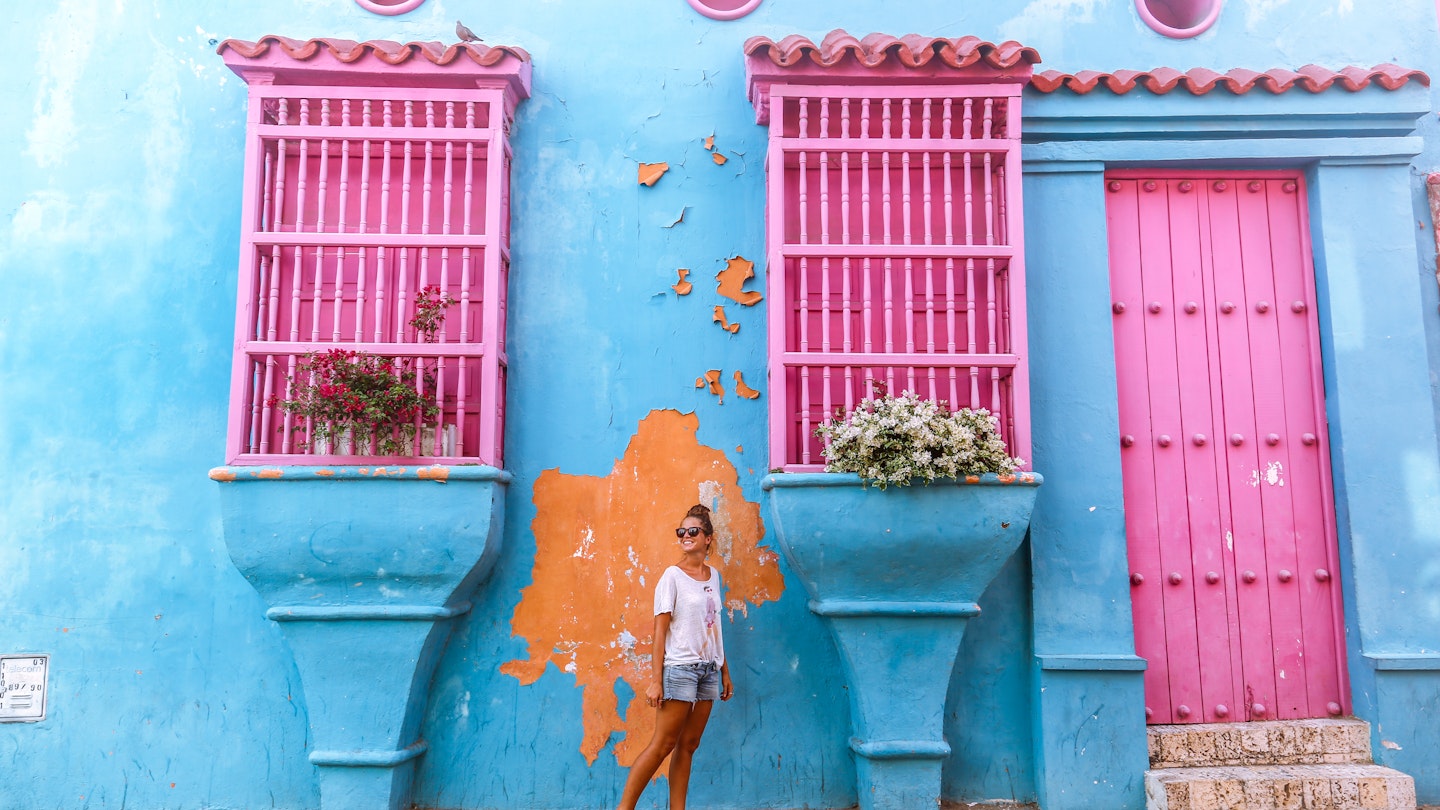
From health and safety to etiquette, these tips can help you plan your trip to Colombia © jeremykingnz / Shutterstock
Whether you’re drawn by its beguiling coastlines , untamed jungle or high-altitude national parks , Colombia is guaranteed to dazzle.
After decades of association with armed conflict and drug cartels, this South American country has moved well beyond those dark decades, emerging from that chapter of history as one of the continent’s most thrilling and welcoming destinations to explore .
Travelers to Colombia should prepare for a trip that will leave them wishing they never had a return ticket, thanks to the country’s remarkably warm and friendly people and uniquely Latin spirit.
Follow these tips on planning and health and safety to ensure a truly unforgettable trip to Colombia.
1. Don't attempt to see all of Colombia in one trip
A big mistake that even seasoned travelers have made is to try and pack too much into a trip around Colombia. Before trying to squeeze every last corner of the country into a two-week itinerary, cast your eyes over the map.
Stick to exploring one section of the country and exploring it well: spend three weeks bouncing between sun-soaked, Caribbean beaches or heading from Medellín deep into the Zona Cafetera . Your trip should match Colombia’s characteristic pace: slow and enjoyable.
2. Domestic flights are affordable and quick
If you’re still planning to cram as many places as possible into a short trip, Colombia’s wealth of low-cost airlines offer the most efficient way of getting around (although there's your carbon footprint to consider too).
While nothing quite compares with the cultural experience of taking a regional bus (where you’ll be “entertained” by deafening music for the duration), increasingly cheap fares are available for domestic flights.
Don’t be fooled by headline prices, these typically don’t include checked baggage. Peak traveling seasons (December through mid-January, Semana Santa and June through August) will add a premium and can sell out rapidly, so book flights in advance if visiting during these months.
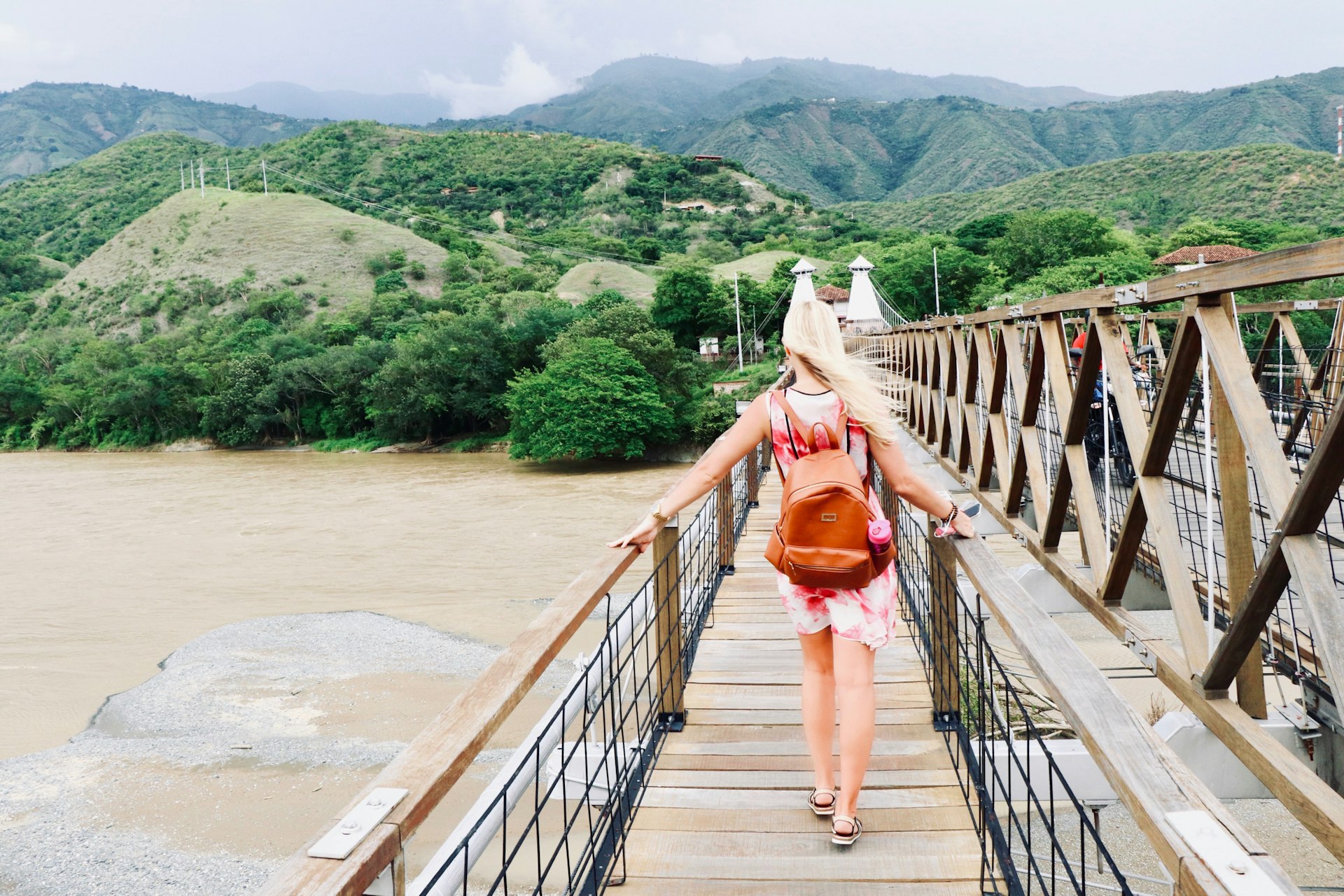
3. Pack for all weather
Whether you’re hitting the Caribbean coast or heading to the rainier climes of the capital, Bogotá , you can expect to experience a full array of weather conditions.
While Colombia officially has two distinct seasons – the dry season (December through February and July through August) and the rainy season (April, May, and September through November) – because of the country’s variation in altitudes and ecosystems, you’ll probably experience all four seasons in one trip.
As a rule, the Caribbean coast is hot and humid, while Bogotá and the wider Andean regions receive a surfeit of rain. Come prepared with plenty of layers, including a warm, easy-to-pack rain jacket, and you’ll be primed to adapt to whatever the weather might throw at you.
4. A little Spanish will get you a long way
For a country so long enveloped by violent conflict, Colombia today is a remarkably open and welcoming destination for international travelers. Wherever you are, it’s easy to strike up a conversation with the owner of a restaurant, your taxi driver or a local enjoying the sunshine in a city plaza (and they’ll be delighted if you do!).
Knowing more than the basics of Spanish can go a long way, spurring engaging, fascinating conversations about Colombian culture, football, history and politics.
Colombian Spanish, particularly in Bogotá and Medellín, is considered one of the easiest to understand in Latin America because Colombians tend to enunciate their words. Make the most of affordable language schools in both cities to get some practice in before you head out into the rest of the country.
5. There are checkpoints with a strong military presence
When traveling in rural parts of Colombia, it’s not uncommon to come across road checkpoints staffed by army personnel, who’ll often ask to see your documents before waving you on your way.
In areas recently opened to tourism, you might even spot tanks and other military vehicles stationed alongside roads.
While it might seem intimidating, the strong military presence around the country is there for the safety of the local people – and you. Be polite and have the correct paperwork (either your actual passport or a photocopy of the main page and entry stamp) with you, and you’ll rarely have an issue.

6. Don’t expect punctuality
Like much of Latin America, Colombian culture isn’t known for its strict adherence to the clock, and a punctuality-obsessed traveler is often a disappointed one. “Colombian time” is practically its own time zone, and you should leave any notions of timeliness at home.
To avoid getting frustrated, relax and embrace being flexible – really, the only way to deal with the typically laid-back Colombian attitude toward life, the universe and pretty much everything.
While big, inter-regional buses and flights do tend to leave on time, tight schedules aren't followed in many other contexts. If you’re making an appointment with a Colombian person or waiting for a rural colectivo to depart, bring a book as you may well be waiting up to an hour beyond the agreed time.
7. Drugs and talking about that Netflix show are big no-nos
If there’s one way to annoy Colombians, it’s to get onto a topic that many Western tourists, despite Colombian’s attempts to dissuade them, continue to associate with the country: drugs. Illegal substances are a taboo subject in Colombia, and despite (or more likely, because of) the country’s history, few Colombians take them.
Residents of Medellín, in particular, are fed up with the city’s association with drug cartels and with tourists who go there to use cocaine, which is illegal and could see you getting into a lot of trouble if caught.
When traveling in Colombia, don’t mention Narcos , either. Colombians are frustrated with the Netflix show’s portrayal of the country and what they see as the exaltation of a mass murderer.
Show some respect and steer clear of the many Pablo Escobar tours, too. Listening to local people's experiences during the drug-war years is likely to be far more informative and accurate.
8. Taxis will help you get around safely
While safety is no longer the same overwhelming concern it once was, taking taxis when traveling between neighborhoods in big cities across Colombia is a sensible choice.
Wandering around at night, particularly after you’ve had a shot of heady aguardiente or two, is often an invitation to opportunist thieves.
Taxis are extremely affordable and relatively painless if using a ride-share app, such as Cabify or Uber . Hailing a taxi can leave you open to scams or worse, so calling for a cab (or asking your hotel to) is recommended. Always confirm the price or check that the taxi has a working meter before entering a vehicle.
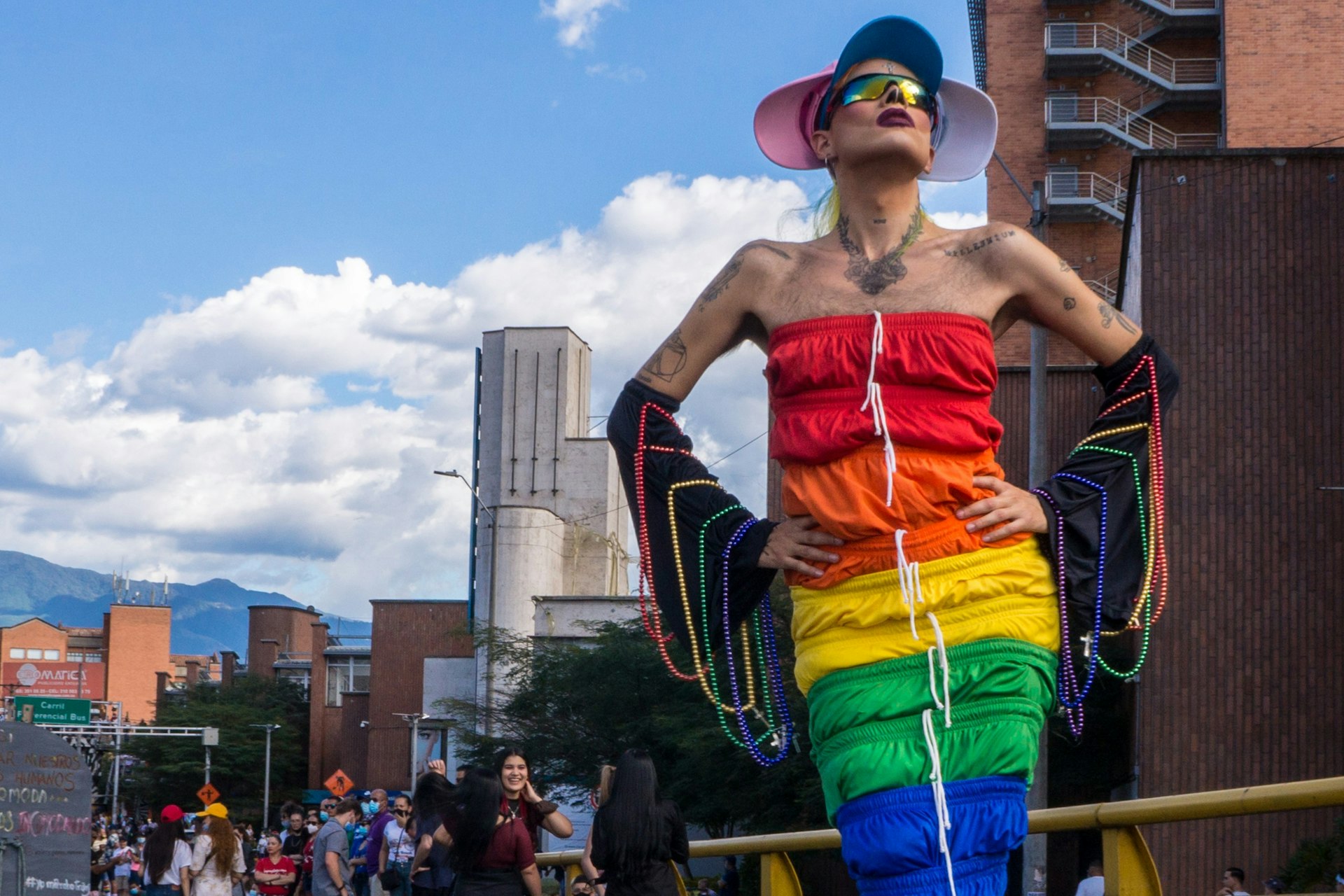
9. Bogotá has a well-established gay scene
Homosexuality was decriminalized in Colombia in early 1980s, and the first same-sex marriage ceremony was performed in 2013 – evidence that this country has some of the more progressive attitudes toward LGBTIQ+ rights in Latin America.
Bogotá has a well-established gay scene, with bars and nightlife mostly found in Chapinero, one of the city’s most dynamic neighborhoods . Some lodgings and restaurants are beginning to advertise themselves as gay-friendly.
Despite its progressive laws, much of Colombian society remains traditionalist, and many same-sex couples still feel unsafe showing affection in public. For more information specifically for LGBTIQ+ travelers, check out Guia Gay Colombia.
10. Tipping isn’t obligatory, but it is appreciated
Dining out in Colombia is extremely affordable.
When you go to pay the bill at fancier or more upmarket restaurants, it’s likely you’ll be asked if you want to include the propina (tip), typically around 10% of the cost of the meal.
Service in restaurants, cafes and bars across Colombia is generally much better than in many other parts of South America , so unless you had a terrible experience, consider paying the tip to show your appreciation.

11. Traveling is safe – but stick to the beaten track
Colombia has experienced an about-face in the past few decades, shedding its title as one of Latin America’s most dangerous countries and coming into its own as a worthy travel destination.
It all comes down to the history-making peace accords signed in 2016 between the Colombian government and the FARC, which, after five decades of conflict, have led to many rural parts of the country finally shifting from no-go areas into welcoming places for visitors.
However, it still isn’t wise to go too far off the beaten path. Some rural areas remain dangerous because of their links with neo-paramilitary and drug-trafficking groups, particularly along the borders with Panama, Venezuela and Ecuador.
Before traveling anywhere unusual, always research the situation on the ground as well as your government’s travel advisories.
12. Scams and muggings do happen
While safety has improved significantly, you should always “ no dar papaya .” This delightful idiom – which literally translates to “don’t give papaya” – means you should always keep your wits about you, staying alert to those who would take advantage of you.
In practice, this means following common-sense guidelines: don’t wander down dark, empty streets at night, don’t head out into neighborhoods you don’t know without checking their safety first and don’t flap about the city with an expensive camera or phone on display.
Travel insurance is essential because muggings are, unfortunately still an issue in cities such as Bogota, Cali and Medellín.
You should never resist if someone tries to rob you. Distraction techniques are those used most fruitfully by would-be thieves, so always be wary of people coming up to you in the street or being asked to show your money to scammers posing as police officers.
If things do go wrong, head to the nearest police station immediately to report the crime. The police will put together a report and give you a copy, which you’ll need to make an insurance claim.
13. Don’t let this country’s history scare you away
Colombia has come on leaps and bounds since the dark days of the 1980s and 1990s, and its residents are more than excited to show you their beautiful and wonderfully diverse country.
The biggest mistake you can make is to let Netflix or historic newspaper headlines scare you away: this is a country that just about every traveler can’t help but fall in love with. The biggest danger when visiting Colombia? Finding yourself never wanting to leave.
This article was first published May 14, 2022 and updated Feb 29, 2024.
Explore related stories
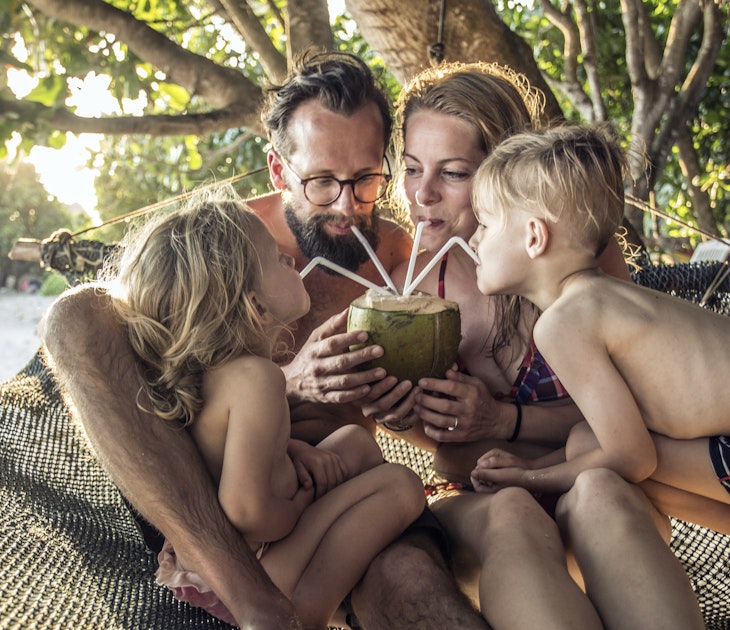
Budget Travel
May 8, 2024 • 5 min read
With a little planning, a memorable, affordable family vacation is well within reach. Here’s how.

Mar 2, 2024 • 8 min read
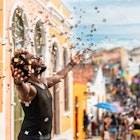
Mar 1, 2024 • 9 min read

Feb 11, 2024 • 9 min read

Feb 1, 2024 • 7 min read

Jan 30, 2024 • 9 min read
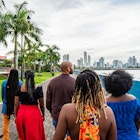
Dec 23, 2023 • 6 min read

Dec 20, 2023 • 7 min read

Dec 15, 2023 • 7 min read

Dec 14, 2023 • 3 min read
How to Live Abroad
- The World's Best Places to Retire
- Travel—How, When, and Where to Go
- Real Estate Overseas
- Earn, Bank, Diversify, Invest
- Retirement Planning
- How to Move Out of the U.S.
- All Destinations
- Editor's Choice
- Daily e-Letter
- Our Experts
- Testimonials
Cali, Colombia
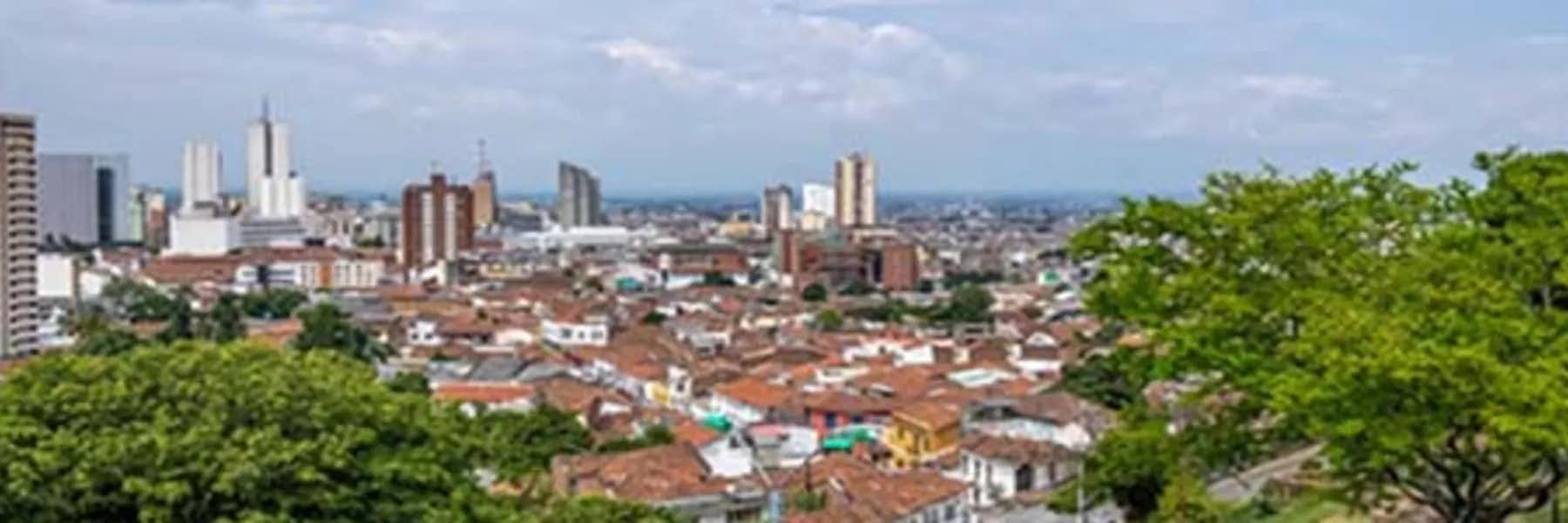
Cali, Colombia: Things To Do and Safety in The Salsa Capital of the World
Written by Michael Bjorn Huseby
Cali, a hotbed for Salsa music, is located in a valley adjacent to the magnificent Andes Mountains. Hop in a car, and you can be at the ocean in just a couple of hours.
But Colombia’s third-largest city is best known for its energetic atmosphere, growing economy, and bustling nightlife. With over 2 million people, Cali is a center of Latin culture, industry, and education. If you’re looking for an exciting life in the city, Cali might be the place for you.
Move to Cali, Colombia

Cali’s warm weather, low cost of living, and bustling nightlife all make the city an attractive option for those looking for some Latin flavor.
The Alfonso Bonilla Aragón International Airport has direct flights all over the Americas, including routes to the United States. You can fly nonstop from Cali to Miami for just $390 roundtrip.
Colombia’s nature-filled Coffee Triangle is just four hours away by bus, with tickets as low as $7. You can also reach Colombia’s west coast in just a couple of hours. Transportation to the ocean costs less than $10.
Cali’s ever-expanding public transport system makes it easy to get around the city. A trip on the local MIO bus system costs just $0.70. MIO also operates cable cars, which transport you up hilly areas with 360-degree views of the city. Uber is also available, with rides costing a fraction of what they would in a major United States city.
Transportation isn’t the only place where you’ll be pleasantly surprised by the low cost of living. Housing is remarkably affordable in Cali, with two-bedroom apartments available for as little as $350 per month in upscale neighborhoods. You could buy a 1,000-square-foot, three-bedroom apartment in an expat-friendly location for just $100,000. It’s not a stretch to say you could live very comfortably for as little as $1,500 per month.
Cali is one of Colombia’s highest-rated cities for healthcare, and that’s saying something. Colombia’s constitution deems healthcare a basic human right, and the World Healthcare Organization ranked Colombia’s healthcare as number 22, which is the best in all of Latin America. Colombia ranks higher than advanced economies like New Zealand, Israel, and the United States.
Cali has two of the best hospitals in all of Latin America, Fundación Valle del Lili and Centro Médico Imbanaco. Many medical facilities in Cali have doctors who speak English.
Health insurance in Colombia is wonderfully affordable. Premiums cost up to 50% to 70% less than in the United States. For some insurance plans, you can enroll without being a resident. You can rest assured knowing you’re in good hands.
A little farther south than Medellin (the city of eternal spring), Cali is known as the city of eternal summer. The temperature remains consistent year-round with highs in the mid-80s F and lows in the mid-60s F. Cali is no dessert. You can expect five to 10 days of rain each month, which helps keep the valley lush with vegetation.
Lifestyle in Cali, Colombia

Cali is full of diverse neighborhoods, each with its own unique flavor. San Antonio is a popular expat destination with bohemian vibes, vibrant street art, and great vegetarian food. San Fernando is home to a thriving gastronomic scene and a bustling nightlife. Barrio Granada is a safe, upscale area with boutiques lining the streets. Many areas are quite walkable, with housing located right by grocery stores and restaurants.
If you live in Cali, expect to go dancing. Whether you’re attending your first lesson or are a seasoned professional, there’s no escaping Cali’s claim to fame. Salsa takes over the city at night and doesn’t stop until the sun comes up. Whether you’re at a music festival or a Salsa club, you’ll feel the rhythm pulse throughout your body as you dance the night away.
San Antonio, Barrio Granada, and La Sexta are some of the best places to get a taste of Cali’s nightlife. Head a bit farther south to Parque del Perro and the surrounding areas for a buzzing area with outdoor patios, concerts, and people socializing in the streets.
Caleños (Cali natives) are open, friendly, and warm. The people are wonderfully diverse, with a mix of African, European, and indigenous heritage. The melting pot results in a wide range of food, music, and style.
While there’s a growing expat community in Cali, foreigners aren’t as common as in more cosmopolitan cities like Medellin and Bogota . The locals might be interested to hear your story and how you made your way to Cali. They’re likely to invite you to their homes and go out of their way to make sure you feel like you belong.
Things to do in Cali, Colombia
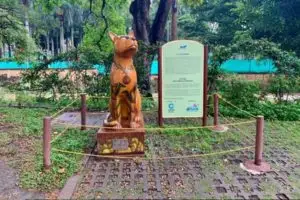
Cali is an urban metropolis that has something for everything. Stay in the metro area for an exciting night or venture out into nearby nature to take a breather from city life.
Parque de La Retreta
The Cali River runs through the northern and western zones of the city. Parque de La Retreta, located near Barrio Granada, surrounds the river with vegetation, a gazebo, and statues of cats. Sculptor Hernando Tejada originally donated a massive three-ton bronze cat to the city in 1996.
Ten years later, Cali commissioned Colombian artists to paint 15 new cats. Today, metal felines are scattered throughout the city, with a notable concentration on the banks of the Cali River.

Take a Salsa Class
It’s hard to overstate how much Salsa means to this city. Your first salsa class is a rite of passage when you arrive in Cali. Northwestern Cali has a sea of Salsa classes for beginners, experts, and everything in between. If you’ve never danced a day in your life, don’t despair. The helpful instructors (frequently clad in silk or velvet) will guide you through “basic move” until you feel the sweat dripping down your brow.
Many studios offer free classes to first-time students. These introductory courses are a great way to meet locals and expats alike. Shop around during these complimentary classes to find the right instructor for you.
Visit the Orchid Park
Colombia has the widest variety of orchids in the world. Visit the Orquideorama Enrique Pérez Arbeláez for an open-air orchid museum that takes you through a wooded park. The two-acre museum plays host to special events, social gatherings, and scientific exhibitions.
Hike Cerro de Las Tres Cruces
El Cerro de Las Tres Cruces, a popular hiking destination, is located in the northwestern part of Cali, just to the north of San Antonio and west of Barrio Granada. The one-hour hike is quite steep—you may end up your hands and knees during the most challenging portions. Once at the top, enjoy a fresh-squeezed orange juice to celebrate your victory.
Hike early in the morning for the best views. Plus, you’ll make the climb before the thermometer reaches 80 F. It’s best to hike the trail on the weekends, as the large crowds on the trails help keep you safe.
Hit the Museum Circuit
If you’re looking to beat the heat on a hot Cali day, check out one of the city’s many museums. Learn about sugarcane, one of Colombia’s most important crops, at Museo de la Caña de Azúcar.
If you’re an aviation fan, head over to Museo Aereo Felix, where you can see full-size airplanes, helicopters, and more.
Visit the Caliwood Museo de la Cinematografía, Colombia’s premier cinema museum, to learn about the filmmaking process. Peruse the collection of theater projectors, cameras, and memorabilia before watching a few short clips on vintage equipment.
Is it Safe to Live in Cali, Colombia?

Cali has a reputation for being one of the more dangerous cities in Colombia. However, crime has been steadily decreasing for years, and most of the violence occurs in Eastern Cali, a region where most expats never visit.
More upscale neighborhoods like Barrio Granada are much safer, but it’s always a good idea to practice standard safety measures. Don’t walk alone at night, flash expensive jewelry, or carry large amounts of cash. After dark, consider taking Ubers to get around the city. Fares are low and you’ll have peace of mind. As long as you use common sense and avoid risky situations, you should be just fine.
Feature Image Copyright: ©iStock/diegograndi
Colombia Deep Dives
Colombia Fast Facts
Cost of Living in Colombia
Economy in Colombia
Healthcare in Colombia
Live in Colombia
Real Estate in Colombia
Renting in Colombia
Retire to Colombia
Traditions and Culture in Colombia
Visa and Residency in Colombia
Weather in Colombia
Where is Colombia?
City and Area Guide
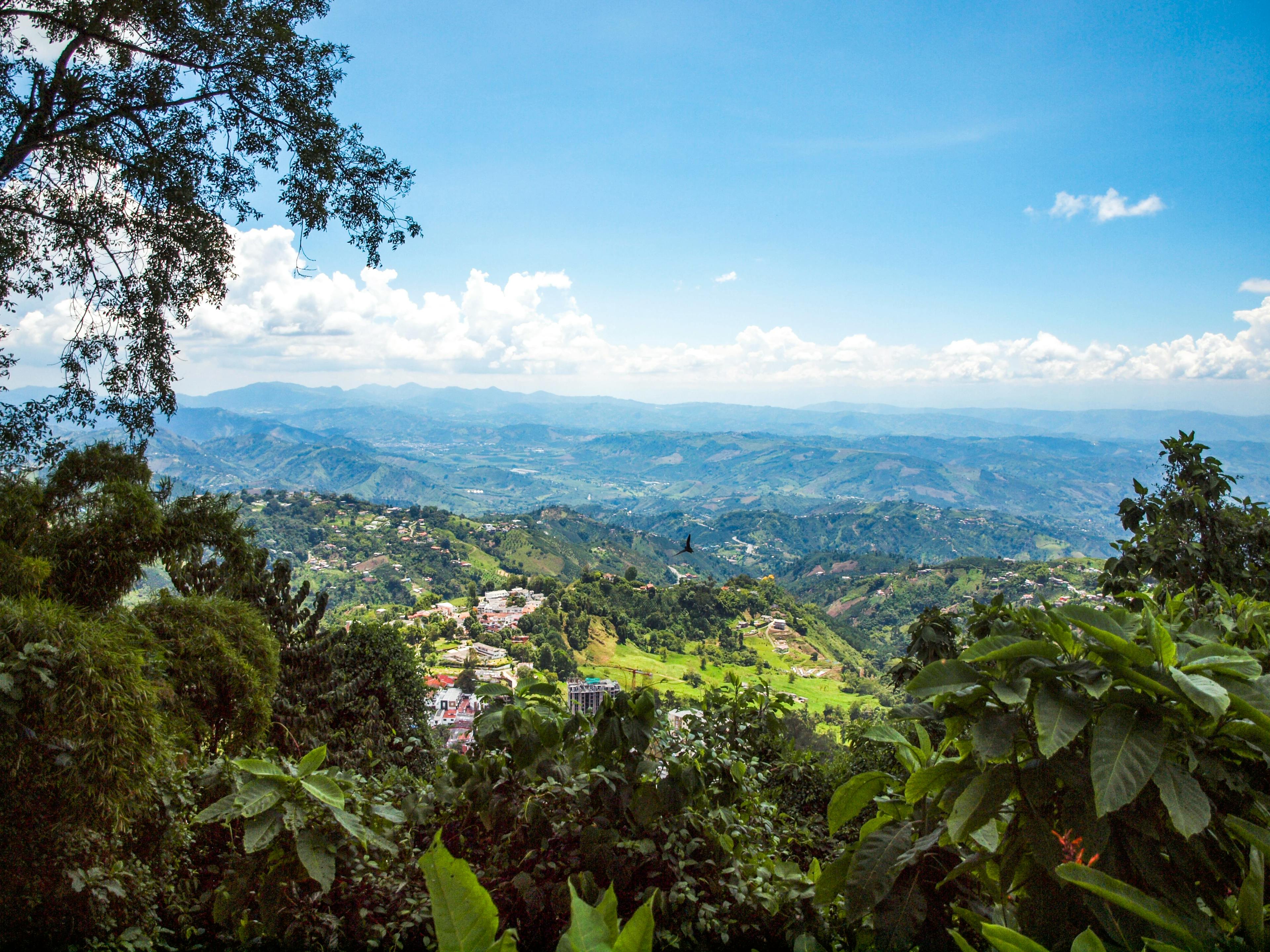

- TRAVEL TIPS
- HIKING & CAMPING
Cali, Colombia
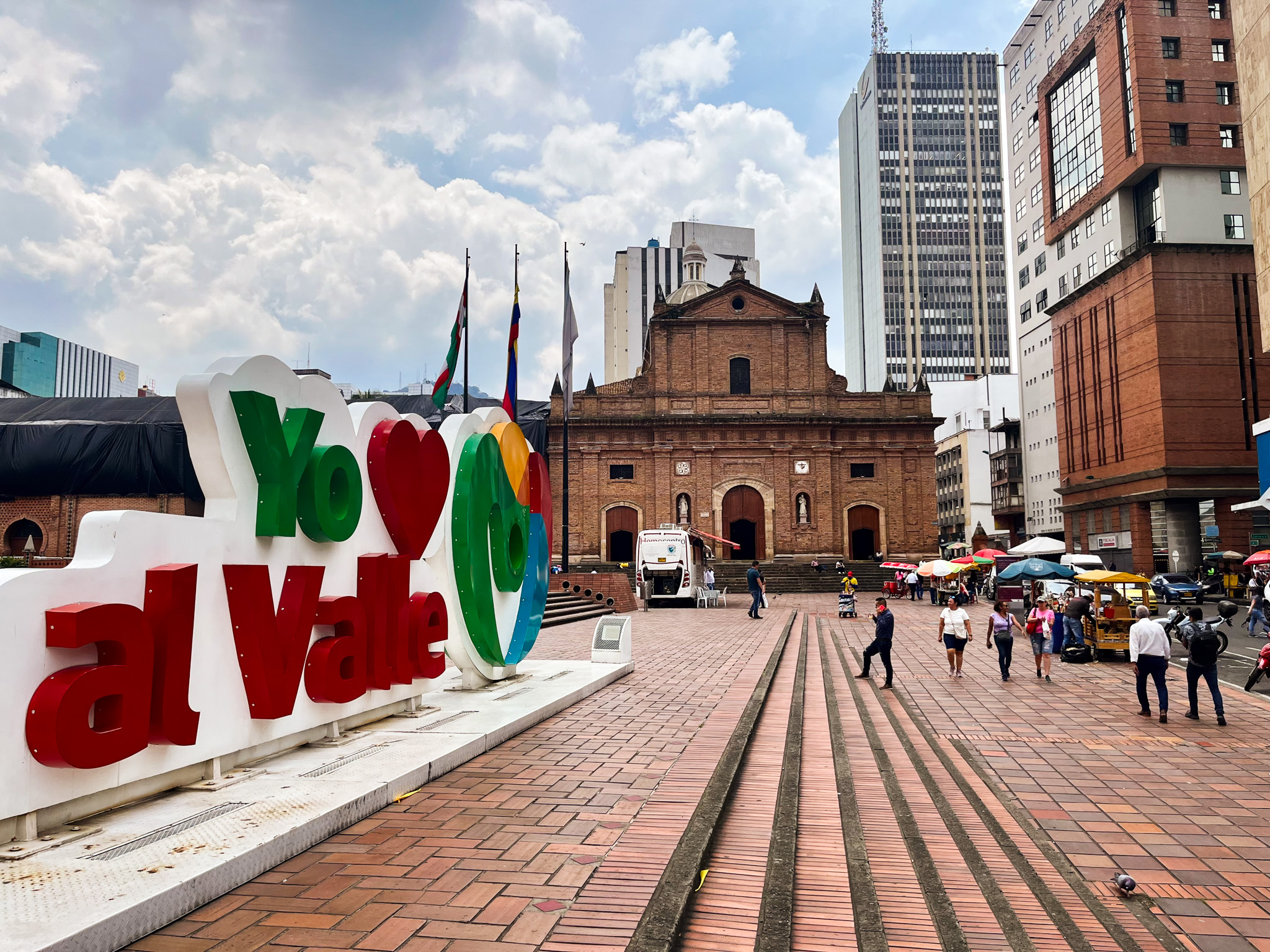
I have two distinctive memories of Cali, Colombia: the warmth of the people I met and the dynamic dance culture that pulsated through the city. It’s a shame that Cali is often skipped over by visitors due to its perceived lack of tourist attractions and unfair reputation as a dangerous place. I loved my time in Cali, and it was the most authentic experience I had in Colombia!
In this guide to Cali, Colombia, I’ll do my best to capture the essence of this vibrant city, as well as provide information that will help you plan your own unforgettable trip here. For more Colombia travel tips and destination guides, head to my Colombia page .
Table of Contents
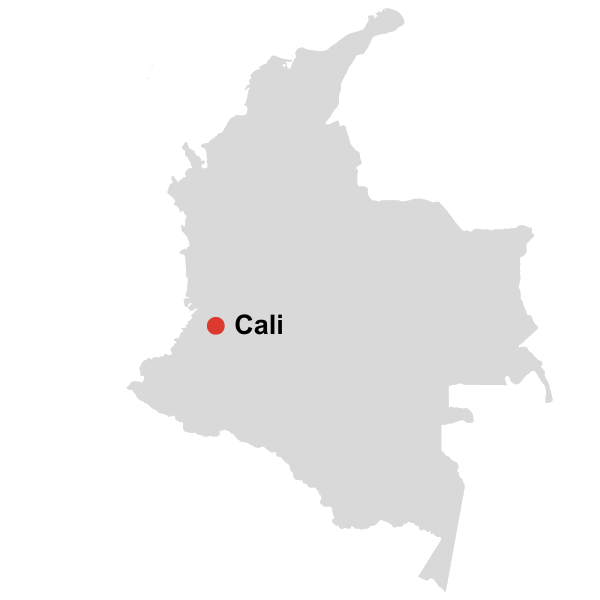
Cali, Colombia History
Cali is located in Southwest Colombia and is the third most populated city in the country, after Bogotá and Medellín . If you’re traveling between Colombia and Ecuador you’ll likely pass through Cali since it is located on the Pan American highway.
Cali was founded in 1536 and was historically a hub for agriculture and cattle. Cali controlled Colombia’s only Pacific coast port. The port in combination with the sugar industry attracted many Afro-Caribbeans and other immigrants over the years, contributing to Cali’s unique heritage. In the 1950s and 1960s the flourishing industrial scene attracted additional waves of immigration.
Cali is called the “Capital de la Salsa” and is famous for salsa music and dancing. You’ll find locals dancing a particular style – salsa caleña, characterized by its faster pace and intricate footwork that set it aside from salsa styles elsewhere in the world. Salsa arrived here in the mid-twentieth century, when rhythms from Cuba crossed the Caribbean and reached Cali.
My Trip to Cali, Colombia
Arriving in cali.
I began my journey to Cali from Salento , changing buses in Armenia. On the bus, the passenger in the row next to me was so thrilled about the onboard Wi-Fi that he shared the password with me unprompted. Our journey hit a snag when traffic came to a standstill due to an accident. As we passed through the accident site, all that remained were a fallen motorcycle and a woman sobbing hysterically, sending a chill down my spine.
A few hours later, I arrived in Cali, not knowing what to expect. Initially, I had planned to skip Cali based on misconceptions that there wasn’t much for tourists to do and that it was unsafe (both of which I can now confirm are false). I was also nervous about my hostel, which I had paid only $5 per night for, in contrast to the typical $10-20 range I was accustomed to in Colombia.
My Hostel in Cali, Colombia
My fears dissipated upon arriving at the hostel. I was pleasantly surprised to find it conveniently located near the historic center, including a charming terrace, and offering complimentary dance classes. What struck me even more was the fact that all the foreign guests at the hostel spoke fluent Spanish. Half of them were dating local Colombians, which somewhat explained this.
Shortly after my arrival, the hostel hosted a salsa class. Although I’ve danced salsa competitively for many years, I never had the chance to learn Cali style (salsa caleña) and was instantly in love. After the class I walked around the city center with a new friend from the hostel, mimicking the locals by grabbing beers and fried street food for the walk. My favorite part of the walk was an enormous trumpet monument; when standing under the bells, you hear different classic salsa songs.
I returned to the hostel to find everyone on the terrace, passing around bottles of Colombian rum and smokes. There was also a show-and-tell of everyone’s shopping finds for the day, and I was impressed by the high-quality clothing everyone had scored for as low as $1 per item.
Salsa Dancing in Cali, Colombia
Later in the evening, we headed out to La Topa Tolondra for some salsa dancing. One perk of our hostel was that we were given free entrance wristbands. We made a stop by another hostel (Viajeros) to pick up any stragglers who’d like to join our group, but we weren’t successful in convincing anyone to leave the admittedly lively Viajeros pool party.
At La Topa Tolondra, I danced a few times but mostly watched the talented locals of all ages skillfully dancing salsa caleña. In the early hours of the morning, we walked back to the hostel and stopped by a 24/7 bakery for local cheese pastries. Sadly, there were many beggars and homeless people in the streets. I regretted not following our hostel’s advice to never walk at night when we saw a group of men throwing a huge pile of papers into a fire they had built on the street.
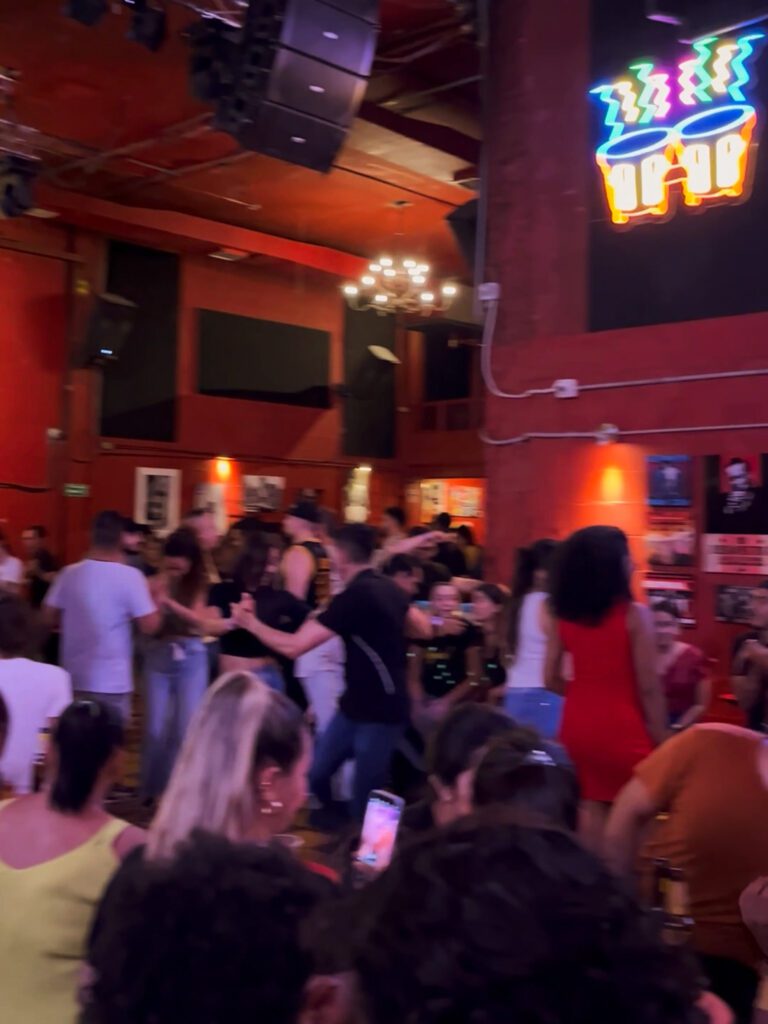
Sightseeing and Leaving Cali
Unfortunately I had planned for only two half-days in Colombia, and I wished I had more time. To add to the sadness, my last day in Cali was also my final day in Colombia.
I indulged in one last breakfast of huevos pericos at a local cafeteria before heading to the bus station to purchase my ticket for later that day. Initially, I panicked when I couldn’t find any tickets online. However, the more experienced travelers at the hostel reassured me that there were plenty of buses heading in that direction that weren’t posted online, and they were right. Feeling much calmer, I then strolled around the city center, which unfortunately was strewn with trash and populated by homeless people. The shopping areas and parks, while cleaner, were not particularly interesting.
Upon returning to the hostel, I attempted to plan my next month, considering a trip to Patagonia on the other side of the continent. Spoiler alert: I did end up going to Patagonia, but not until five months later. Everyone in the hostel laughed at my detailed planning, and I realized I still had much to learn about traveling as a backpacker.
It was then time to say goodbye to my new friends, and I made my way to the bus station. During the ride, I chatted with my Uber driver about my next destination. He shared a wealth of helpful information about the bus route; just another example of the friendliness of Cali locals!
I boarded the bus with a heavy heart, sad that my time in Colombia had come to an end and not knowing what to expect in my next destination, Ecuador.
Cali, Colombia Trip Planning Information
Things to do in cali, colombia.
My top recommendations for things to do in Cali are to spend a day seeing the sights near the city center, then going dancing or watching a salsa show at night. If you’re a dance lover, Cali is a great place for high quality and affordable lessons.
Explore Cali’s Neighborhoods
In El Peñon neighborhood, visit Parque de los Gatos, a park full of cat sculptures.
When in the city center , the main sights to visit are Iglesia Ermita, Plaza de Caicedo, and Parque Simón Bolívar. Don’t miss the Monumento Niche, which was constructed in honor of a famous salsa musician. The monument is shaped like trumpets and trombones, and when you step under the bells, you’ll hear each one playing a different song! Also make sure to walk around the charming San Antonio neighborhood, and visit its church and park. For an authentic shopping experience, check out Parque Artesanal Loma de La Cruz, a park with vendors selling artisanal products.
I recommend heading to La Topa Tolondra for salsa dancing. If you don’t feel like dancing, you can still enjoy a drink and be impressed by the locals!
If you’d prefer to leave the dancing to professionals, head to El Delirio . This is Cali’s most famous salsa show; a combination of dance, music, and circus performances. Tickets start at 150,000 COP (38 USD) and the venue is a ~30 min drive from the center of town.
If you have the time, take a dance class at a local studio. Private lessons are very affordable, and if you’ll be staying for a while, local studios host social events where you can practice.
In Cali, Colombia, the streets of the city center are full of vendors selling everything you could possibly want at very low prices. There are also many malls (centro commercial) in the center and in the neighborhoods north of the center.
For an aerial panorama of Cali, head to Cristo Rey, which is free to enter. This giant Christ structure is 85 ft (26 m) tall and located at the top of a hill. It’s possible and safe to walk there, but you might not want to since the walk is 1 h 45 min and uphill. An Uber or taxi will take you there in ~15 min for 20,000 – 30,000 COP (5.10 – 7.65 USD). To get to Cristo Rey by public transportation, take the MIO bus A04 for 2,700 COP (0.70 USD). Ride the bus to the entrance of the Bellavista neighborhood, from where you can catch a Jeep or Chiva bus for ~ 4,000 COP (1 USD). They’ll drop you off about 10 min from the entrance.
Cerro de las Tres Cruces
For another great view of Cali, Colombia, hike to Cerro de las Tres Cruces. The hike is 2.5 mi (4 km) and 1,300 ft (400 m) elevation gain. The trail starts near El Peñon, and depending on where you’re staying you may be able to walk or take public transportation there. For safety reasons, it’s best to do the Cerro de las Tres Cruces hike when there are a lot of other people on the trail, such as on weekend mornings.
Waterfalls and Rivers Near Cali, Colombia
If you’re craving an escape in nature, Cali has some fantastic rivers and jungles nearby to explore. These areas are hard to get to by public transportation, so I would suggest going with a tour. Head to the Jordan River to enjoy waterfalls and natural jacuzzis, or San Cipriano for river tubing and to experience a unique local form of rail transport.
How Long to Stay
If you’re a dance lover, you could spend weeks in Cali, Colombia. I considered dropping all of my plans and extending my stay…that’s how good the dancing was. If not, 1 day is sufficient to see the major sights and enjoy a night out.
Cali, Colombia Weather
Cali is warm year round with cool nights. Dry season is June – September, and to a lesser extent, January to February.
Festivals in Cali, Colombia
From December 25-30, Cali celebrates La Feria de Cali (The Cali Fair), which includes parades, concerts, and cultural events.
Cali, Colombia Hotels and Where to Stay
I recommend staying in El Peñon or San Antonio, which are safe neighborhoods that are also close to tourist attractions. Other safe neighborhoods are: Centro, San Cayetano, Granada, Versailles, and Juanambú. I’ve recommended some safe places to stay below.
Budget: Viajero Hostel Cali & Salsa School . They have a nice courtyard with a bar and pool, which will be refreshing on Cali’s hot afternoons. You can also take salsa classes with them, and the environment is very social. Choose from dorms or private rooms.
Mid-range: Casa Ruta Sur . This guesthouse has beautifully furnished private rooms and a courtyard. Luxury: Hotel Stein Colonial . This hotel is ideally located next to the park and feels like an oasis in the city with its pool and garden.
Where to Eat and Drink
Cali is a big city with a lot of restaurants; you’ll find both western and traditional options, especially in the center. I was pleased to find many high quality vegetarian restaurants, such as La Casona Vegetariana , offering affordable lunches.
When in Cali, try some of the regional specialties:
- Pan de bono: bite-sized cheese bread
- Cholado: shaved ice with fresh fruit
- Aborrajado: fried plantain stuffed with cheese
Tap water in Cali, Colombia is safe to drink, but if you’re very sensitive consider bringing your own LifeStraw water filter.
Is Cali, Colombia Safe?
While Cali is often unfairly labeled as dangerous, doing your research and taking necessary precautions significantly reduces the likelihood of any safety issues.
First of all, know which areas to avoid and choose your accommodation in a safe area. Safe areas include the historic center, neighborhoods above and to the east of Parque San Antonio, and the neighborhood north of Parque Simon Bolivar.
Avoid Communes 13, 15, and 21, which are unsafe. These neighborhoods are far from the city center and touristic areas, so it’s unlikely you will stumble across them unless you intentionally venture there.
When arriving in Cali, ask your accommodation for the latest safety information. Don’t walk late at night, even in a group. Take a licensed taxi or Uber. Lastly, keep an eye on your belongings when walking through San Pedro (the neighborhood above the center, including the park), which is a hotspot for petty crime. Check out my Colombia safety guide for more tips, and make sure you have travel insurance .
Budget and Money
Cali is not a touristic city, and prices will be lower than those in Medellín or Cartagena. Many touristic activities are free.
ATMs are widely available near the center, but don’t carry around large quantities of cash.
What to Bring to Cali, Colombia
For a full list of what to bring, refer to my Colombia packing list . I would stress the following:
- Downloaded maps of Cali and nearby areas you want to visit (use Google Maps or MapsME)
- SIM or eSIM card
- Rain jacket ( Women’s , Men’s )
- Mosquito spray . Surprisingly, there are many mosquitos in Cali’s city center.
- Shoes that you can dance salsa in. Sneakers are ok, but don’t wear sandals or hiking boots!
How to Get to Cali, Colombia
Check out my guide to transportation in Colombia for more information.
Flights to Cali, Colombia
There are direct flights to Cali from many other destinations in Colombia and also internationally.
Keep in mind that the Cali airport (CLO) is far from the city center. For peace of mind and a fixed price, reserve an airport transfer in advance. A taxi to the center will be 50,000 – 60,000 COP (12.80 – 15.30 USD) and take ~30 min. Uber can’t enter airport terminals, so you’ll need to exit the airport to catch one.
A cheaper but slower option to get out from the airport is taking the bus, which will drop you off at the bus station near the center. There are 2 buses companies Rapido Aeropuerto and Expreso Palmira. Buses run every 20 min and cost 8,000 COP (2 USD).
How to Get to Cali by Bus
I recommend using BusBud to look up prices and bus routes to Cali.
Armenia to Cali: 3 hours. Add on an extra hour and bus connection if arriving from Salento.
Medellín to Cali: 8+ hours.
Bogotá to Cali: 11+ hours.
Ipiales (border with Ecuador) to Cali: 12 hours.
Getting from the bus station to the city center will take ~30 min by public transport (MIO bus line). However, a taxi or Uber will be faster (10-15 min) and safer when traveling with luggage.
How to Get Around Cali, Colombia
Uber is available in Cali, and it is cheaper and sometimes safer than taxis. Much of the safe areas near the center are walkable.
You can also take the local bus line (MIO), which is 2,700 COP (0.70 USD) per ride. You’ll need to buy a card to load with money. Use Google Maps to look up the bus routes.
Where to Go Next
- Salento and Valle de Cocora
- Pasto: visit the unique Las Lajas sanctuary hanging on the edge of a canyon
- San Augustin: an archeological site called the “Andean Easter Island”
- Tierradentro: an archeological site with painted underground tombs
- Tatacoa desert: unique orange and red formations in the desert
- Ecuador: get there via the border town of Ipiales, Colombia
Thanks for reading! I hope this Cali, Colombia travel guide helps you plan your trip. Have you tried salsa dancing? Let me know your thoughts and questions, I’d love to hear from you in the comments. For more Colombia travel tips and destination guides, head to my Colombia page .
Confirm all logistical and safety information before your trip. Also If you buy through links on this site, I may earn an affiliate commission. Thanks for supporting me in creating free content for you to enjoy!
Save this post for later and share on Pinterest !
TRAVEL RESOURCES
Head to my Travel Resources Page for more recommendations.
Packing list . See my recommendations for packing a carry-on for long-term or multi-season travel.
Booking.com . This is my go-to platform for booking accommodation since it consistently gives me competitive prices and additional discounts based on usage.
SafetyWing . The most affordable travel insurance I’ve found that also offers excellent coverage.
Viator and Get Your Guide . Offer extensive tour options for both day trips and multi-day excursions.
BusBud . A great platform to search for bus routes in more than 80 countries and buy tickets online.
LifeStraw . This easy-to-use water filter guarantees that you always have access to clean drinking water.
Travel Credit Card . Earn substantial points for travel-related expenses and a very generous bonus when opening an account.
Related Posts

Leave a Comment Cancel Reply
Your email address will not be published. Required fields are marked *
Save my name, email, and website in this browser for the next time I comment.

Hi, I’m Kristina! I’m a solo female traveler sharing my personal experiences around the world. Authentic travel is important to me; in my destination guides I emphasize not just the most spectacular sights but also the local stories and history.
Other things I’m passionate about are discovering hidden gems, budget-friendly travel, and hiking and backpacking. My goal is to show you how to seek adventurous experiences for yourself!
You are using an outdated browser. Upgrade your browser today or install Google Chrome Frame to better experience this site.
Colombia Traveler View
Travel health notices, vaccines and medicines, non-vaccine-preventable diseases, stay healthy and safe.
- Packing List
After Your Trip
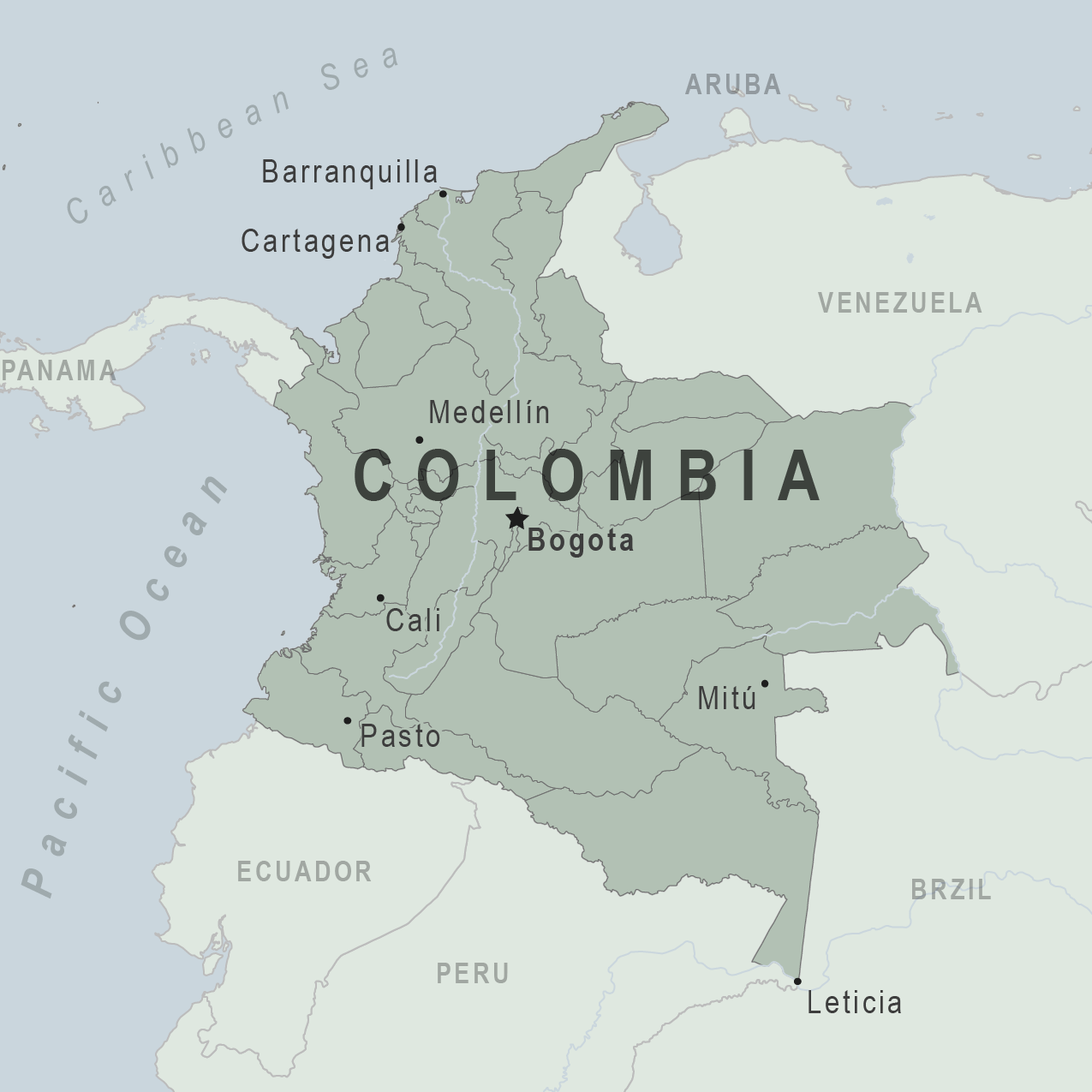
Be aware of current health issues in Colombia. Learn how to protect yourself.
Level 1 Practice Usual Precautions
- Dengue in the Americas April 18, 2024 Dengue is a risk in many parts of Central and South America, Mexico, and the Caribbean. Some countries are reporting increased numbers of cases of the disease. Travelers to the Americas can protect themselves by preventing mosquito bites. Destination List: Argentina, Brazil, Colombia, Costa Rica, Ecuador, including the Galápagos Islands, French Guiana (France), Guadeloupe, Guatemala, Martinique (France), Mexico, Nicaragua, Panama, Paraguay, Peru, Turks and Caicos Islands (U.K.), Uruguay
⇧ Top
Check the vaccines and medicines list and visit your doctor at least a month before your trip to get vaccines or medicines you may need. If you or your doctor need help finding a location that provides certain vaccines or medicines, visit the Find a Clinic page.
Routine vaccines
Recommendations.
Make sure you are up-to-date on all routine vaccines before every trip. Some of these vaccines include
- Chickenpox (Varicella)
- Diphtheria-Tetanus-Pertussis
- Flu (influenza)
- Measles-Mumps-Rubella (MMR)
Immunization schedules
All eligible travelers should be up to date with their COVID-19 vaccines. Please see Your COVID-19 Vaccination for more information.
COVID-19 vaccine
Hepatitis A
Recommended for unvaccinated travelers one year old or older going to Colombia.
Infants 6 to 11 months old should also be vaccinated against Hepatitis A. The dose does not count toward the routine 2-dose series.
Travelers allergic to a vaccine component or who are younger than 6 months should receive a single dose of immune globulin, which provides effective protection for up to 2 months depending on dosage given.
Unvaccinated travelers who are over 40 years old, immunocompromised, or have chronic medical conditions planning to depart to a risk area in less than 2 weeks should get the initial dose of vaccine and at the same appointment receive immune globulin.
Hepatitis A - CDC Yellow Book
Dosing info - Hep A
Hepatitis B
Recommended for unvaccinated travelers younger than 60 years old traveling to Colombia. Unvaccinated travelers 60 years and older may get vaccinated before traveling to Colombia.
Hepatitis B - CDC Yellow Book
Dosing info - Hep B
CDC recommends that travelers going to certain areas of Colombia take prescription medicine to prevent malaria. Depending on the medicine you take, you will need to start taking this medicine multiple days before your trip, as well as during and after your trip. Talk to your doctor about which malaria medication you should take.
Find country-specific information about malaria.
Malaria - CDC Yellow Book
Considerations when choosing a drug for malaria prophylaxis (CDC Yellow Book)
Malaria information for Colombia.
Cases of measles are on the rise worldwide. Travelers are at risk of measles if they have not been fully vaccinated at least two weeks prior to departure, or have not had measles in the past, and travel internationally to areas where measles is spreading.
All international travelers should be fully vaccinated against measles with the measles-mumps-rubella (MMR) vaccine, including an early dose for infants 6–11 months, according to CDC’s measles vaccination recommendations for international travel .
Measles (Rubeola) - CDC Yellow Book
Rabid dogs are commonly found in Colombia. If you are bitten or scratched by a dog or other mammal while in Colombia, there may be limited or no rabies treatment available.
Consider rabies vaccination before your trip if your activities mean you will be around dogs or wildlife.
Travelers more likely to encounter rabid animals include
- Campers, adventure travelers, or cave explorers (spelunkers)
- Veterinarians, animal handlers, field biologists, or laboratory workers handling animal specimens
- Visitors to rural areas
Since children are more likely to be bitten or scratched by a dog or other animals, consider rabies vaccination for children traveling to Colombia.
Rabies - CDC Yellow Book
Recommended for most travelers, especially those staying with friends or relatives or visiting smaller cities or rural areas.
Typhoid - CDC Yellow Book
Dosing info - Typhoid
Yellow Fever
Required for travelers ≥1 year old arriving from Angola, Brazil, Democratic Republic of the Congo, or Uganda; this includes >12-hour airport transits or layovers in any of these countries.
Recommended for all travelers ≥9 months old except as follows. Generally not recommended for travel limited to the cities of Barranquilla, Cali, Cartagena, or Medellín. Not recommended for travel limited to areas >2,300 m (≈7,550 ft) elevation, the archipelago department of San Andrés and Providencia, or the city of Bogotá (the capital).
Yellow Fever - CDC Yellow Book
Avoid contaminated water
Leptospirosis
How most people get sick (most common modes of transmission)
- Touching urine or other body fluids from an animal infected with leptospirosis
- Swimming or wading in urine-contaminated fresh water, or contact with urine-contaminated mud
- Drinking water or eating food contaminated with animal urine
- Avoid contaminated water and soil
Clinical Guidance
Avoid bug bites, chagas disease (american trypanosomiasis).
- Accidentally rub feces (poop) of the triatomine bug into the bug bite, other breaks in the skin, your eyes, or mouth
- From pregnant woman to her baby, contaminated blood products (transfusions), or contaminated food or drink.
- Avoid Bug Bites
Chagas disease
- Mosquito bite
Leishmaniasis
- Sand fly bite
- An infected pregnant woman can spread it to her unborn baby
Airborne & droplet
- Breathing in air or accidentally eating food contaminated with the urine, droppings, or saliva of infected rodents
- Bite from an infected rodent
- Less commonly, being around someone sick with hantavirus (only occurs with Andes virus)
- Avoid rodents and areas where they live
- Avoid sick people
Tuberculosis (TB)
- Breathe in TB bacteria that is in the air from an infected and contagious person coughing, speaking, or singing.
Learn actions you can take to stay healthy and safe on your trip. Vaccines cannot protect you from many diseases in Colombia, so your behaviors are important.
Eat and drink safely
Food and water standards around the world vary based on the destination. Standards may also differ within a country and risk may change depending on activity type (e.g., hiking versus business trip). You can learn more about safe food and drink choices when traveling by accessing the resources below.
- Choose Safe Food and Drinks When Traveling
- Water Treatment Options When Hiking, Camping or Traveling
- Global Water, Sanitation and Hygiene | Healthy Water
- Avoid Contaminated Water During Travel
You can also visit the Department of State Country Information Pages for additional information about food and water safety.
Prevent bug bites
Bugs (like mosquitoes, ticks, and fleas) can spread a number of diseases in Colombia. Many of these diseases cannot be prevented with a vaccine or medicine. You can reduce your risk by taking steps to prevent bug bites.
What can I do to prevent bug bites?
- Cover exposed skin by wearing long-sleeved shirts, long pants, and hats.
- Use an appropriate insect repellent (see below).
- Use permethrin-treated clothing and gear (such as boots, pants, socks, and tents). Do not use permethrin directly on skin.
- Stay and sleep in air-conditioned or screened rooms.
- Use a bed net if the area where you are sleeping is exposed to the outdoors.
What type of insect repellent should I use?
- FOR PROTECTION AGAINST TICKS AND MOSQUITOES: Use a repellent that contains 20% or more DEET for protection that lasts up to several hours.
- Picaridin (also known as KBR 3023, Bayrepel, and icaridin)
- Oil of lemon eucalyptus (OLE) or para-menthane-diol (PMD)
- 2-undecanone
- Always use insect repellent as directed.
What should I do if I am bitten by bugs?
- Avoid scratching bug bites, and apply hydrocortisone cream or calamine lotion to reduce the itching.
- Check your entire body for ticks after outdoor activity. Be sure to remove ticks properly.
What can I do to avoid bed bugs?
Although bed bugs do not carry disease, they are an annoyance. See our information page about avoiding bug bites for some easy tips to avoid them. For more information on bed bugs, see Bed Bugs .
For more detailed information on avoiding bug bites, see Avoid Bug Bites .
Stay safe outdoors
If your travel plans in Colombia include outdoor activities, take these steps to stay safe and healthy during your trip.
- Stay alert to changing weather conditions and adjust your plans if conditions become unsafe.
- Prepare for activities by wearing the right clothes and packing protective items, such as bug spray, sunscreen, and a basic first aid kit.
- Consider learning basic first aid and CPR before travel. Bring a travel health kit with items appropriate for your activities.
- If you are outside for many hours in heat, eat salty snacks and drink water to stay hydrated and replace salt lost through sweating.
- Protect yourself from UV radiation : use sunscreen with an SPF of at least 15, wear protective clothing, and seek shade during the hottest time of day (10 a.m.–4 p.m.).
- Be especially careful during summer months and at high elevation. Because sunlight reflects off snow, sand, and water, sun exposure may be increased during activities like skiing, swimming, and sailing.
- Very cold temperatures can be dangerous. Dress in layers and cover heads, hands, and feet properly if you are visiting a cold location.
Stay safe around water
- Swim only in designated swimming areas. Obey lifeguards and warning flags on beaches.
- Practice safe boating—follow all boating safety laws, do not drink alcohol if driving a boat, and always wear a life jacket.
- Do not dive into shallow water.
- Do not swim in freshwater in developing areas or where sanitation is poor.
- Avoid swallowing water when swimming. Untreated water can carry germs that make you sick.
- To prevent infections, wear shoes on beaches where there may be animal waste.
Leptospirosis, a bacterial infection that can be spread in fresh water, is found in Colombia. Avoid swimming in fresh, unchlorinated water, such as lakes, ponds, or rivers.
Keep away from animals
Most animals avoid people, but they may attack if they feel threatened, are protecting their young or territory, or if they are injured or ill. Animal bites and scratches can lead to serious diseases such as rabies.
Follow these tips to protect yourself:
- Do not touch or feed any animals you do not know.
- Do not allow animals to lick open wounds, and do not get animal saliva in your eyes or mouth.
- Avoid rodents and their urine and feces.
- Traveling pets should be supervised closely and not allowed to come in contact with local animals.
- If you wake in a room with a bat, seek medical care immediately. Bat bites may be hard to see.
All animals can pose a threat, but be extra careful around dogs, bats, monkeys, sea animals such as jellyfish, and snakes. If you are bitten or scratched by an animal, immediately:
- Wash the wound with soap and clean water.
- Go to a doctor right away.
- Tell your doctor about your injury when you get back to the United States.
Consider buying medical evacuation insurance. Rabies is a deadly disease that must be treated quickly, and treatment may not be available in some countries.
Reduce your exposure to germs
Follow these tips to avoid getting sick or spreading illness to others while traveling:
- Wash your hands often, especially before eating.
- If soap and water aren’t available, clean hands with hand sanitizer (containing at least 60% alcohol).
- Don’t touch your eyes, nose, or mouth. If you need to touch your face, make sure your hands are clean.
- Cover your mouth and nose with a tissue or your sleeve (not your hands) when coughing or sneezing.
- Try to avoid contact with people who are sick.
- If you are sick, stay home or in your hotel room, unless you need medical care.
Avoid sharing body fluids
Diseases can be spread through body fluids, such as saliva, blood, vomit, and semen.
Protect yourself:
- Use latex condoms correctly.
- Do not inject drugs.
- Limit alcohol consumption. People take more risks when intoxicated.
- Do not share needles or any devices that can break the skin. That includes needles for tattoos, piercings, and acupuncture.
- If you receive medical or dental care, make sure the equipment is disinfected or sanitized.
Know how to get medical care while traveling
Plan for how you will get health care during your trip, should the need arise:
- Carry a list of local doctors and hospitals at your destination.
- Review your health insurance plan to determine what medical services it would cover during your trip. Consider purchasing travel health and medical evacuation insurance.
- Carry a card that identifies, in the local language, your blood type, chronic conditions or serious allergies, and the generic names of any medications you take.
- Some prescription drugs may be illegal in other countries. Call Colombia’s embassy to verify that all of your prescription(s) are legal to bring with you.
- Bring all the medicines (including over-the-counter medicines) you think you might need during your trip, including extra in case of travel delays. Ask your doctor to help you get prescriptions filled early if you need to.
Many foreign hospitals and clinics are accredited by the Joint Commission International. A list of accredited facilities is available at their website ( www.jointcommissioninternational.org ).
In some countries, medicine (prescription and over-the-counter) may be substandard or counterfeit. Bring the medicines you will need from the United States to avoid having to buy them at your destination.
Malaria is a risk in some parts of Colombia. If you are going to a risk area, fill your malaria prescription before you leave, and take enough with you for the entire length of your trip. Follow your doctor’s instructions for taking the pills; some need to be started before you leave.
Select safe transportation
Motor vehicle crashes are the #1 killer of healthy US citizens in foreign countries.
In many places cars, buses, large trucks, rickshaws, bikes, people on foot, and even animals share the same lanes of traffic, increasing the risk for crashes.
Be smart when you are traveling on foot.
- Use sidewalks and marked crosswalks.
- Pay attention to the traffic around you, especially in crowded areas.
- Remember, people on foot do not always have the right of way in other countries.
Riding/Driving
Choose a safe vehicle.
- Choose official taxis or public transportation, such as trains and buses.
- Ride only in cars that have seatbelts.
- Avoid overcrowded, overloaded, top-heavy buses and minivans.
- Avoid riding on motorcycles or motorbikes, especially motorbike taxis. (Many crashes are caused by inexperienced motorbike drivers.)
- Choose newer vehicles—they may have more safety features, such as airbags, and be more reliable.
- Choose larger vehicles, which may provide more protection in crashes.
Think about the driver.
- Do not drive after drinking alcohol or ride with someone who has been drinking.
- Consider hiring a licensed, trained driver familiar with the area.
- Arrange payment before departing.
Follow basic safety tips.
- Wear a seatbelt at all times.
- Sit in the back seat of cars and taxis.
- When on motorbikes or bicycles, always wear a helmet. (Bring a helmet from home, if needed.)
- Avoid driving at night; street lighting in certain parts of Colombia may be poor.
- Do not use a cell phone or text while driving (illegal in many countries).
- Travel during daylight hours only, especially in rural areas.
- If you choose to drive a vehicle in Colombia, learn the local traffic laws and have the proper paperwork.
- Get any driving permits and insurance you may need. Get an International Driving Permit (IDP). Carry the IDP and a US-issued driver's license at all times.
- Check with your auto insurance policy's international coverage, and get more coverage if needed. Make sure you have liability insurance.
- Avoid using local, unscheduled aircraft.
- If possible, fly on larger planes (more than 30 seats); larger airplanes are more likely to have regular safety inspections.
- Try to schedule flights during daylight hours and in good weather.
Medical Evacuation Insurance
If you are seriously injured, emergency care may not be available or may not meet US standards. Trauma care centers are uncommon outside urban areas. Having medical evacuation insurance can be helpful for these reasons.
Helpful Resources
Road Safety Overseas (Information from the US Department of State): Includes tips on driving in other countries, International Driving Permits, auto insurance, and other resources.
The Association for International Road Travel has country-specific Road Travel Reports available for most countries for a minimal fee.
Maintain personal security
Use the same common sense traveling overseas that you would at home, and always stay alert and aware of your surroundings.
Before you leave
- Research your destination(s), including local laws, customs, and culture.
- Monitor travel advisories and alerts and read travel tips from the US Department of State.
- Enroll in the Smart Traveler Enrollment Program (STEP) .
- Leave a copy of your itinerary, contact information, credit cards, and passport with someone at home.
- Pack as light as possible, and leave at home any item you could not replace.
While at your destination(s)
- Carry contact information for the nearest US embassy or consulate .
- Carry a photocopy of your passport and entry stamp; leave the actual passport securely in your hotel.
- Follow all local laws and social customs.
- Do not wear expensive clothing or jewelry.
- Always keep hotel doors locked, and store valuables in secure areas.
- If possible, choose hotel rooms between the 2nd and 6th floors.
Healthy Travel Packing List
Use the Healthy Travel Packing List for Colombia for a list of health-related items to consider packing for your trip. Talk to your doctor about which items are most important for you.
Why does CDC recommend packing these health-related items?
It’s best to be prepared to prevent and treat common illnesses and injuries. Some supplies and medicines may be difficult to find at your destination, may have different names, or may have different ingredients than what you normally use.
If you are not feeling well after your trip, you may need to see a doctor. If you need help finding a travel medicine specialist, see Find a Clinic . Be sure to tell your doctor about your travel, including where you went and what you did on your trip. Also tell your doctor if you were bitten or scratched by an animal while traveling.
If your doctor prescribed antimalarial medicine for your trip, keep taking the rest of your pills after you return home. If you stop taking your medicine too soon, you could still get sick.
Malaria is always a serious disease and may be a deadly illness. If you become ill with a fever either while traveling in a malaria-risk area or after you return home (for up to 1 year), you should seek immediate medical attention and should tell the doctor about your travel history.
For more information on what to do if you are sick after your trip, see Getting Sick after Travel .
Map Disclaimer - The boundaries and names shown and the designations used on maps do not imply the expression of any opinion whatsoever on the part of the Centers for Disease Control and Prevention concerning the legal status of any country, territory, city or area or of its authorities, or concerning the delimitation of its frontiers or boundaries. Approximate border lines for which there may not yet be full agreement are generally marked.
Other Destinations
If you need help finding travel information:
Message & data rates may apply. CDC Privacy Policy
File Formats Help:
- Adobe PDF file
- Microsoft PowerPoint file
- Microsoft Word file
- Microsoft Excel file
- Audio/Video file
- Apple Quicktime file
- RealPlayer file
- Zip Archive file
Exit Notification / Disclaimer Policy
- The Centers for Disease Control and Prevention (CDC) cannot attest to the accuracy of a non-federal website.
- Linking to a non-federal website does not constitute an endorsement by CDC or any of its employees of the sponsors or the information and products presented on the website.
- You will be subject to the destination website's privacy policy when you follow the link.
- CDC is not responsible for Section 508 compliance (accessibility) on other federal or private website.
Update May 10, 2024
Information for u.s. citizens in the middle east.
- Travel Advisories |
- Contact Us |
- MyTravelGov |
Find U.S. Embassies & Consulates
Travel.state.gov, congressional liaison, special issuance agency, u.s. passports, international travel, intercountry adoption, international parental child abduction, records and authentications, popular links, travel advisories, mytravelgov, stay connected, legal resources, legal information, info for u.s. law enforcement, replace or certify documents.
Before You Go
Learn About Your Destination
While Abroad
Emergencies
Share this page:
Travel Advisory January 2, 2024
Colombia - level 3: reconsider travel.
Reissued with updates to the country summary.
Reconsider travel due to crime and terrorism . Exercise increased caution due to civil unrest and kidnapping . Some areas have increased risk. Read the entire Travel Advisory.
Do Not Travel to:
- Arauca, Cauca (excluding Popayán), and Norte de Santander departments due to crime and terrorism.
- The Colombia-Venezuela border region due to crime, kidnapping, and risk of detention when crossing into Venezuela from Colombia.
Country Summary: Violent crime, such as homicide, assault, and armed robbery, is widespread. Organized criminal activities, such as extortion, robbery, and kidnapping, are common in some areas.
Terrorist groups and criminal organizations continue operating and carrying out attacks in Colombia. They may attack with little or no warning, targeting transportation hubs, markets/shopping malls, local government facilities, police stations, military facilities, hotels, clubs, restaurants, airports, other public areas, and U.S. government facilities.
Demonstrations occur regularly throughout the country and can be about a variety of political or economic issues. They can shutdown roads and highways, often without prior notice or estimated reopening timelines. Demonstrations and road closures may significantly reduce access to public transportation and may disrupt travel within and between cities. Protests can become violent and can result in fatalities and injuries.
U.S. direct-hire government employees must adhere to the noted restrictions:
- They are not permitted to travel by road between most cities.
- Colombia’s land border areas are off-limits to U.S. government personnel unless specifically authorized.
- They may not use motorcycles.
- They may not hail street taxis or use public buses.
Read the country information page for additional information on travel to Colombia.
If you decide to travel to Colombia:
- Avoid protest areas and crowds.
- Monitor local media for breaking events and adjust your plans based on new information.
- Keep a low profile.
- Be aware of your surroundings.
- Enroll in the Smart Traveler Enrollment Program (STEP) to receive Alerts and make it easier to locate you in an emergency.
- Follow the Department of State on Facebook and Twitter
- Review the Country Security Report for Colombia.
- Prepare a contingency plan for emergency situations. Review the Traveler’s Checklist .
Arauca, Cauca, and Norte de Santander Departments – Level 4: Do Not Travel
Violent crime, including armed robbery and homicide, is widespread. Terrorist groups are active in some parts.
The U.S. government has limited ability to provide emergency services to U.S. citizens as U.S. government-personnel travel to these areas is severely restricted due to security concerns.
Colombia - Venezuela Border – Level 4: Do Not Travel
U.S. citizens are advised not to travel to the border of Colombia and Venezuela. U.S. citizens are at risk of detention when crossing into Venezuela.
The Colombia-Venezuela border is not clearly marked, and U.S. citizens should not go near the border due to the risk of crossing into Venezuela accidentally.
U.S. citizens attempting to enter Venezuela without a visa have been charged with terrorism and other serious crimes and detained for long periods. For more information, see the Venezuela Travel Advisory.
Visit our website for Travel to High-Risk Areas .
Embassy Messages
View Alerts and Messages Archive
Quick Facts
Must be valid at the time of entry and for the duration of stay.
One page required for entry stamp unless enrolled in Migración Automática, a program for frequent travelers.
Not required for stays 90 days or less.
Yellow fever vaccination is required for travelers coming from certain countries or visiting certain national parks.
10,000 USD maximum.
Embassies and Consulates
U.S. Embassy Bogota
Physical Address: Calle 24 Bis No. 48-50, Bogotá, D.C., Colombia Mailing address: Carrera 45 No. 24B-27, Bogotá, D.C. 110111, Colombia Telephone: +(57) (601) 275-2000 Emergency after-hours telephone: +(57) (601) 275-2000 and press 0 Email: [email protected]
U.S. Consular Agency Barranquilla Calle 77B No. 57-141, Suite 511 Centro Empresarial Las Americas 1, Barranquilla, Atlántico, Colombia Telephone: +(57) 605-353-2001 and +(57) 605-369-0149 Emergency after-hours telephone: +(57) (601) 275-4021 Email: [email protected]
For hours and services, please visit the U.S. Embassy Bogota website .
Destination Description
See the Department of State’s website www.state.gov for information on U.S. - Colombia relations.
Entry, Exit and Visa Requirements
Travelers must complete Migración Colombia’s Online Check-Mig Form within 72 hours of boarding an inbound or outbound flight from Colombia. There is no fee to complete the form.
All U.S. citizens who do not also hold Colombian citizenship must present a valid U.S. passport to enter and leave Colombia. U.S. citizens do not need a Colombian visa for a tourist or business stay of 90 days or less, or for cumulative stays of 180 days or less per calendar year. Before your 90-day stay expires, you may request an extension of up to 90 additional days from the Colombian immigration authority ( Migración Colombia ). You will face a fine if you remain in Colombia longer than allowed, and you may not be able to leave Colombia until the fine is paid.
Any traveler entering with a Colombian visa of any type (as opposed to visa-free entry described above) with more than three months’ validity must register the visa at a Migración Colombia office or online within 15 days of arrival in Colombia or face fines. You may be denied entry to Colombia if you do not have a return ticket. Visit the Ministry of Commerce, Industry, and Tourism website for the most current visa information.
Visit the CDC Traveler View website for vaccination information, and the Colombian Ministry of Health website for Yellow Fever vaccination requirements.
Special Entry/Exit Instructions for U.S. Citizens Born in Colombia: All Colombian citizens—regardless of dual citizenship—MUST present a valid, non-expired Colombian passport to enter and exit Colombia. Colombian citizens traveling with non-Colombian passports may be unable to depart the country until they obtain a Colombian passport.
Be aware that any person born in Colombia or of Colombian parentage may be considered a Colombian citizen, even if never documented as such.
Be aware as well that all U.S. citizens, regardless of dual citizenship, must present a valid U.S. passport upon returning to the United States. Persons who are both U.S. and Colombian citizens MUST travel between these countries with both passports, presenting the Colombian passport upon departing Colombia and the U.S. passport upon arrival in the United States.
Additional Exit Requirements for Minors: To prevent international child abduction, Colombia has implemented special exit procedures for Colombian children under 18 (including dual nationals) who depart the country alone, without both parents, or without a legal guardian. For detailed information regarding exit requirements for minors with Colombian nationality please visit Migración Colombia's website (in Spanish only).
Lost or Stolen Passport: If your U.S. passport is lost or stolen in Colombia, you must obtain a new one before leaving the country. You can report the loss or theft on the Colombian National Police website .
The U.S. Department of State is unaware of any HIV/AIDS entry restrictions for visitors to or foreign residents of Colombia.
Find information on dual nationality , prevention of international child abduction , and customs regulations on our websites.
Safety and Security
Terrorism : Terrorist groups and those inspired by such organizations are intent on attacking U.S. citizens abroad. Terrorists are increasingly using less sophisticated methods of attack – including knives, firearms, and vehicles – to more effectively target crowds. Frequently, their aim is focused on unprotected or vulnerable targets, such as:
- High-profile public events (sporting events, political rallies, demonstrations, holiday events, celebratory gatherings, etc.)
- Hotels, clubs, and restaurants frequented by tourists
- Places of worship
- Shopping malls and markets
- Public transportation systems (including subways, buses, trains, and scheduled commercial flights)
Terrorist groups and criminal organizations continue operating and carrying out attacks in Colombia.
For more information, see our Terrorism page.
Crime : Crimes and scams against tourists, and those perceived to be wealthy, are common and well-coordinated in urban areas, including in affluent neighborhoods. Firearms and knives are prevalent in Colombia and often used in muggings and robberies under the threat of violence. Drive-by motorcyclist snatchings of cell phones, bags, and valuables are extremely common. Victims are often identified well in advance of the robbery based on visible jewelry, high value wristwatches, and general attire while in public places such as shopping malls, restaurants, and airports.
Narco-trafficking groups, including the Clan del Golfo frequently engage in violence against civilians and security forces.
Dating App Robberies/Drugging/Homicides: Criminals use dating apps to lure victims to meet in places such as hotels, restaurants, and bars, and then later assault and rob them. Numerous U.S. citizens in Colombia have been drugged, robbed, and even killed by their Colombian dates. You should be cautious if using dating apps in Colombia. If meeting with a stranger, you should strongly consider meeting only in public places and avoiding isolated locations, such as residences or hotel rooms, where crimes are most likely to occur. Tell a friend or family member of your plans, including where you are going, details of the person you are meeting, and the app you used to meet them.
ATMs : There have been instances of fraudulent charges or withdrawals from accounts due to “skimmed” cards. If you choose to use credit or debit cards, you should regularly check your account to ensure there are no unauthorized transactions. Travelers should limit the amount of cash they carry in public, exercise caution when withdrawing cash from ATMs, and avoid ATMs located on the street. ATMs inside shopping malls or other protected locations are preferable.
Taxis : U.S. government employees are prohibited from hailing taxis on the street due to the risk of assault or robbery. U.S. citizens have been killed during robberies while using taxis. Use a dispatch service or cell phone app whenever possible.
Disabling Drugs : The Embassy receives regular reports of criminals using drugs to temporarily incapacitate unsuspecting victims and then rob or assault them. Scopolamine, a fast-acting incapacitating drug, is often surreptitiously applied to food, drinks, and hand sanitizer vials by criminals to rob or assault their victims. Victims of scopolamine-related crimes are often targeted in bars, night clubs, or through dating apps. Avoid leaving food or drinks unattended at a bar or restaurant, and refuse offers of something to eat or drink from a stranger.
Ayahuasca/Hallucinogens: Traditional hallucinogens, often referred to as ayahuasca, can be marketed to tourists as “spiritual cleansing,” and typically contain dimethyltryptamine (DMT), a strong psychedelic that is illegal in the United States and many other countries. Risks to hallucinogen users while intoxicated include robbery, assault, illness, or death. People claiming to be shamans or spiritual practitioners are neither licensed nor regulated.
Demonstrations : Protests and demonstrations occur frequently, particularly in Bogota. They may take place in response to political or economic issues, on politically significant holidays, and during international events.
- Demonstrations can be unpredictable; avoid areas around protests and demonstrations.
- Check local media for updates and traffic advisories.
International Financial Scams : See the Department of State and the FBI pages for information.
Internet romance and financial scams are prevalent in Colombia. Scams are often initiated through Internet postings/profiles or by unsolicited emails and letters. Scammers almost always pose as U.S. citizens who have no one else to turn to for help. Common scams include:
- Romance/Online dating
- Money transfers
- Lucrative sales
- Gold purchase
- Contracts with promises of large commissions
- Grandparent/Relative targeting
- Free Trip/Luggage
- Inheritance notices
- Work permits/job offers
- Bank overpayments
- Posing as U.S. government officials soliciting payment for services.
Victims of Crime: U.S. citizen victims of sexual assault are encouraged to contact the U.S. Embassy for assistance. Report crimes to the local police by dialing 123 and contact the U.S. Embassy at +57 (601) 275-2000 or +57 (601) 275-4021 after hours. Remember that local authorities are responsible for investigating and prosecuting crimes.
See our webpage on help for U.S. victims of crime overseas .
- Help you find appropriate medical care.
- Assist you in reporting a crime to the police.
- Contact relatives or friends with your written consent.
- Provide general information regarding the victim’s role during the local investigation and following its conclusion.
- Provide a list of local attorneys.
- Provide our information on victim’s compensation programs in the United States.
- Provide an emergency loan for repatriation to the United States and/or limited medical support in cases of destitution.
- Help you find accommodation and arrange flights home.
- Replace a stolen or lost passport.
Domestic Violence: U.S. citizen victims of domestic violence are encouraged to contact the Embassy for assistance. Help in domestic violence situations is available, in Spanish, by calling 155 (*155 from a cell phone).
Tourism : The tourism industry is unevenly regulated, and safety inspections for equipment and facilities are uncommon. Hazardous areas/activities are not always identified with appropriate signage, and staff may not be trained or certified by the government or by recognized authorities. In the event of an injury, adequate medical treatment may only be available in or near major cities. First responders may only be able to provide basic medical treatment and may be unable to access areas outside of major cities. U.S. citizens are encouraged to purchase medical evacuation insurance .
Venezuelan Border : The U.S. Department of State has categorized Venezuela as Level 4: Do Not Travel due to crime, civil unrest, poor health infrastructure, kidnapping, and the arrest and detention of U.S. citizens without due process or fair trial guarantees. U.S. citizens are at risk of detention when crossing into Venezuela from Colombia. The Colombia-Venezuela border is not clearly marked, and U.S. citizens should not go near the border due to the risk of crossing into Venezuela accidentally and being detained for illegal entry. If you still choose to travel to Venezuela, do not attempt to enter Venezuela without a visa. Visas are not available upon arrival. U.S. citizens attempting to enter Venezuela without a visa have been charged with terrorism and other serious crimes and detained for long periods. The Maduro regime does not notify the U.S. government of the detention of U.S. citizens and the U.S. government is not granted access to those citizens. The U.S. government has extremely limited ability to provide emergency services to U.S. citizens in Venezuela.
Local Laws & Special Circumstances
Criminal Penalties : You are subject to local laws. If you violate local laws, even unknowingly, you may be arrested, imprisoned, or expelled.
Individuals establishing a business or practicing a profession that requires additional permits or licensing should seek information from the competent local authorities prior to practicing or operating a business.
Customs Regulations : If you enter or exit Colombia possessing cash or other financial instruments worth more than $10,000USD, you must declare them and be able to prove the legal source of the funds. The Embassy has received reports of customs officials confiscating high-value jewelry that was not declared upon entry.
Colombian law prohibits tourists and business travelers from bringing firearms and ammunition into Colombia. Colombian law also restricts the importation of plants and animals (and some related products).
Artifacts : Colombian law forbids the export of pre-Columbian objects and other artifacts protected by cultural patrimony statutes. U.S. customs officials are obliged to seize pre-Columbian objects and certain colonial religious artwork brought into the United States.
Furthermore, some laws are also prosecutable in the United States, regardless of local law. For examples, see our website on crimes against minors abroad and the Department of Justice website.
Arrest Notification : If you are arrested or detained, ask police to notify the U.S. Embassy immediately. See our webpage for further information.
Penalties for possessing, using, or trafficking in illegal drugs in Colombia are severe, and convicted offenders can expect long pre-trial detention and lengthy prison sentences under harsh conditions. Colombian law may require that released offenders serve a lengthy period of parole in-country, during which the offender is given no housing and may lack permission to work.
Colombia uses comprehensive screening procedures to detect narcotics smuggling at its international airports. Travelers are occasionally questioned, searched, fingerprinted, and/or asked to submit to an abdominal X-ray upon arrival or departure. Most airport inspectors do not speak English.
Counterfeit and Pirated Goods : Although counterfeit and pirated goods are prevalent in many countries, they may still be illegal according to local laws. You may also pay fines or have to give them up if you bring them back to the United States. See the U.S. Department of Justice website for more information.
Faith-Based Travelers : See the following webpages for details:
- Faith-Based Travel Information
- International Religious Freedom Report – see country reports
- Human Rights Report – see country reports
- Hajj Fact Sheet for Travelers
- Best Practices for Volunteering Abroad
LGBTQI+ Travelers : Colombia has one of the strongest legal frameworks in Latin America defending the rights of LGBTQI+ people; however, in practice protections remain a long way from full enforcement and harassment persists, especially in rural areas. In many parts of Colombia, violence against trans people exceeds levels of violence against any other members of the LGBTQI+ community. Criminals do utilize dating apps to target potential victims of theft, so travelers should use caution on such apps. Certain regions, especially in rural areas, experience higher instances of harassment/violence against LGBTQI+ communities. In 2022, there was an uptick of homicides specifically targeting gay men in Medellín. LGBTQI+ associated and friendly establishments exist mostly in metropolitan areas, especially Cartagena, Medellin, and Bogota.
See our LGBTQI+ Travel Information page and section 6 of our Human Rights report for further details.
Travelers with Disabilities : The law in Colombia prohibits discrimination against persons with physical or mental disabilities, but the law is not fully enforced. Social acceptance of persons with disabilities is not as prevalent as in the United States. Many public places and transportation are not adapted to accommodate the needs of persons with disabilities. The most common types of accessible facilities may include restrooms, ramps, and elevators. Expect accessibility to be limited in public transportation, lodging, communication/information, and general infrastructure, including sidewalks, intersections, buses, and taxis. There is a significant difference between the capital (and other large cities) and the rest of the country.
Repair and replacement parts for aids/equipment/devices are available. Sign language interpreters or personal assistants are available for hire.
Students : See our Students Abroad page and FBI travel tips .
Women Travelers : See our travel tips for Women Travelers .
Cruise Ship Passengers : See our travel tips for Cruise Ship Passengers .
For emergency services in Colombia, dial 123 from any mobile phone or land line.
Ambulance services are available in larger cities, but training and availability of emergency responders may be below U.S. standards. Injured or seriously ill travelers may prefer to take a taxi or private vehicle to the nearest major hospital rather than wait for an ambulance.
We do not pay medical bills . Be aware that U.S. Medicare/Medicaid does not apply overseas. Most hospitals and doctors overseas do not accept U.S. health insurance.
Medical Insurance : Make sure your health insurance plan provides coverage overseas. Most care providers overseas only accept cash payments. See our webpage for more information on insurance coverage overseas. Visit the U.S. Centers for Disease Control and Prevention website for more information on the type of insurance you should consider before you travel overseas.
We strongly recommend supplemental insurance to cover medical evacuation.
Always carry your prescription medication in original packaging with your doctor’s prescription. Travelers can check with the Embassy of Colombia in the United States to ensure the medication is legal in Colombia.
Vaccinations : Be up-to-date on all vaccinations recommended by the U.S. Centers for Disease Control and Prevention. Visit the CDC Traveler View website for vaccination information, and the Colombia Ministry of Health website for Yellow Fever vaccination requirements. Childhood vaccinations are required by Colombian law for children ages six and under. Visit the Ministry for Health and Public Safety website for a list of required childhood vaccinations.
Further Health Information :
- World Health Organization
- U.S. Centers for Disease Control and Prevention
Air Quality : Visit AirNow Department of State for information on air quality at U.S. Embassies and Consulates.
The U.S. Embassy maintains a list of doctors and hospitals . We do not endorse or recommend any specific medical provider or clinic.
Health Facilities in General :
- Adequate health facilities are available throughout the country, but health care in rural areas may be below U.S. standards.
- Hospitals and doctors often require payment upfront prior to service or admission. Credit card payment is frequently, but not always, available.
- Medical staff may speak little or no English.
- Patients bear all costs for transfer to or between hospitals.
- Psychological and psychiatric services are limited, even in the larger cities, with hospital-based care only available through government institutions.
Medical Tourism and Elective Surgery :
- U.S. citizens have suffered serious complications or died during or after having cosmetic or other elective surgery.
- Medical tourism is a rapidly growing industry. People seeking health care overseas should understand that medical systems operate differently from those in the United States and are not subject to the same rules and regulations. Anyone interested in traveling for medical purposes should consult with their local physician before traveling and visit the U.S. Centers for Disease Control and Prevention website for more information on Medical Tourism.
- Visit the U.S. Centers for Disease Control and Prevention website for information on medical tourism, the risks of medical tourism, and what you can do to prepare before traveling to Colombia.
- We strongly recommend supplemental insurance to cover medical evacuation in the event of unforeseen medical complications or repatriation in the case of untimely death.
- Your legal options in cases of malpractice are very limited in Colombia.
- Although Colombia has many elective/cosmetic surgery facilities that are on par with those found in the United States, the quality of care varies widely. If you plan to undergo surgery in Colombia, carefully research the doctor and recovery facility you plan to use. Make sure that emergency medical facilities are available, and that professionals are accredited and qualified. Share all health information (e.g. medical conditions, medications, allergies) with your doctor before surgery.
Pharmaceuticals :
- Exercise caution when purchasing medication overseas. Pharmaceuticals, both over the counter and requiring prescription in the United States, are often readily available for purchase with little controls. Counterfeit medication is common and may prove to be ineffective, the wrong strength, or contain dangerous ingredients. Medication should be purchased in consultation with a medical professional and from reputable establishments.
- U.S. Customs and Border Protection and the Food and Drug Administration are responsible for rules governing the transport of medication back to the United States. Medication purchased abroad must meet their requirements to be legally brought back into the United States. Medication should be for personal use and must be approved for usage in the United States. Please visit the U.S. Customs and Border Protection and the Food and Drug Administration websites for more information.
- Colombia does not allow the sale of certain psychiatric medications. Travelers should carry a sufficient supply for their trips. Please review the Colombian government’s open data website for drug unavailability.
Assisted Reproductive Technology and Surrogacy :
- If you are considering traveling to Colombia to have a child through the use of assisted reproductive technology (ART) or surrogacy, please see our ART and Surrogacy Abroad page .
- Surrogacy is currently neither prohibited nor permitted under Colombian law. Although surrogacy agencies/clinics claim surrogacy is legal in Colombia, there is no legal framework for foreigners or same-sex couples to pursue surrogacy. As a result, surrogacy agreements between foreign or same sex intending parents and gestational mothers may not be enforced by Colombian courts.
Water Quality :
- In rural areas, tap water may not be potable. Bottled water and beverages are generally safe, although you should be aware that many restaurants and hotels serve tap water unless bottled water is specifically requested. Be aware that ice for drinks may be made using tap water.
Altitude :
- Many cities in Colombia, such as Bogota, are at high altitude. Be aware of the symptoms of altitude sickness and take precautions before you travel. Visit the U.S. Centers for Disease Control and Prevention website for more information about Travel to High Altitudes .
Adventure Travel :
- Visit the U.S. Centers for Disease Control and Prevention website for more information about Adventure Travel .
General Health :
The following diseases are prevalent:
- Chikungunya
- Yellow Fever
In Chocó, Nariño, and Córdoba, use the U.S. Centers for Disease Control and Prevention recommended mosquito repellents, and sleep under insecticide-impregnated mosquito nets. Chemoprophylaxis is recommended for all travelers in the Amazon region, even for short stays.
HIV/AIDS: Travelers should bring medication sufficient for their entire stay.
Visit the U.S. Centers for Disease Control and Prevention website for more information about Resources for Travelers regarding specific issues in Colombia.
Air Quality :
- Air pollution is a problem in several major cities in Colombia. Consider the impact smog and heavy particulate pollution may have on you and consult your doctor before traveling if necessary.
- Infants, children, and teens
- People over 65 years of age
- People with lung disease such as asthma and chronic obstructive pulmonary disease (COPD), which includes chronic bronchitis and emphysema
- People with heart disease or diabetes
- People who work or are active outdoors
Travel and Transportation
Road Conditions and Safety : Due to the security environment in Colombia and poor infrastructure, U.S. government employees and their families are not permitted to travel by road between most major cities. They also cannot use inter-city or intra-city bus transportation or travel by road outside urban areas at night. Follow these same precautions.
Road travel in Colombia can be dangerous, especially at night. Some roads are poorly maintained, or vulnerable to heavy rains and mudslides. Mountain roads may lack safety features such as crash barriers or guard rails, and conditions are frequently made more treacherous by heavy fog. Highways are often unmarked and unlit, and do not have signs indicating destinations. Slow-moving buses and trucks frequently stop in the middle of the road unexpectedly. In the countryside, livestock is often herded along roads or left to graze on roadsides. Due to a lack of sidewalks, roads are also used by pedestrians.
The use of motorcycles and bicycles is widespread throughout Colombia. U.S. government employees may not use motorcycles because of security concerns.
Traffic Laws : Traffic laws are often ignored and rarely enforced, creating dangerous conditions for drivers and pedestrians. Seat belts are mandatory for all passengers in a private vehicle. Car seats are mandatory for children, and a child under ten years old is not permitted to ride in the front seat. It is against the law to talk on a cellular phone while driving.
If you are involved in an accident, you MUST remain at the scene without moving your vehicle until the authorities arrive. This rule is strictly enforced and moving a vehicle or leaving the scene of an accident may constitute an admission of guilt under Colombian law.
Public Transportation : Do not hail taxis on the street. U.S. government employees may not hail street taxis or use public transportation in Colombia because of security concerns. U.S. citizens have been killed during robberies while using taxis. Use a dispatch service or transportation app whenever possible.
See our Road Safety page for more information. Visit the website of the Colombia national authority responsible for road safety, the Instituto Nacional de Vias .
Aviation Safety Oversight : The U.S. Federal Aviation Administration (FAA) has assessed the government of Colombia’s Civil Aviation Authority as being in compliance with International Civil Aviation Organization (ICAO) aviation safety standards for oversight of Colombia’s air carrier operations. Further information may be found on the FAA’s safety assessment page .
Maritime Travel : Mariners planning travel to Colombia should also check for U.S. maritime advisories and alerts . Information may also be posted to the U.S. Coast Guard homeport website and the NGA broadcast warnings .
Tourist Vessels : Exercise caution when embarked on small tourist boats off the northern coast between Cartagena and the nearby islands. During the months of December and January, the seas off the northern coast can be dangerous for small boats. U.S. citizens have died in boating accidents. Check for lifejackets and safety equipment before boarding a tourist vessel.
For additional travel information
- Enroll in the Smart Traveler Enrollment Program (STEP) to receive security messages and make it easier to locate you in an emergency.
- Call us in Washington, D.C. at 1-888-407-4747 (toll-free in the United States and Canada) or 1-202-501-4444 (from all other countries) from 8:00 a.m. to 8:00 p.m., Eastern Standard Time, Monday through Friday (except U.S. federal holidays).
- See the State Department’s travel website for the Worldwide Caution and Travel Advisories .
- Follow us on Twitter and Facebook .
- See traveling safely abroad for useful travel tips.
Review information about International Parental Child Abduction in Colombia . For additional IPCA-related information, please see the International Child Abduction Prevention and Return Act ( ICAPRA ) report.
Travel Advisory Levels
Assistance for u.s. citizens, colombia map, learn about your destination, enroll in step.

Subscribe to get up-to-date safety and security information and help us reach you in an emergency abroad.
Recommended Web Browsers: Microsoft Edge or Google Chrome.
Check passport expiration dates carefully for all travelers! Children’s passports are issued for 5 years, adult passports for 10 years.
Afghanistan
Antigua and Barbuda
Bonaire, Sint Eustatius, and Saba
Bosnia and Herzegovina
British Virgin Islands
Burkina Faso
Burma (Myanmar)
Cayman Islands
Central African Republic
Cote d Ivoire
Curaçao
Czech Republic
Democratic Republic of the Congo
Dominican Republic
El Salvador
Equatorial Guinea
Eswatini (Swaziland)
Falkland Islands
France (includes Monaco)
French Guiana
French Polynesia
French West Indies
Guadeloupe, Martinique, Saint Martin, and Saint Barthélemy (French West Indies)
Guinea-Bissau
Isle of Man
Israel, The West Bank and Gaza
Liechtenstein
Marshall Islands
Netherlands
New Caledonia
New Zealand
North Korea (Democratic People's Republic of Korea)
Papua New Guinea
Philippines
Republic of North Macedonia
Republic of the Congo
Saint Kitts and Nevis
Saint Lucia
Saint Vincent and the Grenadines
Sao Tome and Principe
Saudi Arabia
Sierra Leone
Sint Maarten
Solomon Islands
South Africa
South Korea
South Sudan
Switzerland
The Bahamas
Timor-Leste
Trinidad and Tobago
Turkmenistan
Turks and Caicos Islands
United Arab Emirates
United Kingdom
Vatican City (Holy See)
External Link
You are about to leave travel.state.gov for an external website that is not maintained by the U.S. Department of State.
Links to external websites are provided as a convenience and should not be construed as an endorsement by the U.S. Department of State of the views or products contained therein. If you wish to remain on travel.state.gov, click the "cancel" message.
You are about to visit:
Colombia Travel Restrictions
Traveler's COVID-19 vaccination status
Traveling from the United States to Colombia
Open for vaccinated visitors
COVID-19 testing
Not required
Not required for vaccinated visitors
Restaurants
Not required in enclosed environments and public transportation.
Colombia entry details and exceptions
Documents & additional resources, ready to travel, find flights to colombia, find stays in colombia, explore more countries on travel restrictions map, destinations you can travel to now, dominican republic, netherlands, philippines, puerto rico, switzerland, united arab emirates, united kingdom, know when to go.
Sign up for email alerts as countries begin to open - choose the destinations you're interested in so you're in the know.
Can I travel to Colombia from the United States?
Most visitors from the United States, regardless of vaccination status, can enter Colombia.
Can I travel to Colombia if I am vaccinated?
Fully vaccinated visitors from the United States can enter Colombia without restrictions.
Can I travel to Colombia without being vaccinated?
Unvaccinated visitors from the United States can enter Colombia without restrictions.
Do I need a COVID test to enter Colombia?
Visitors from the United States are not required to present a negative COVID-19 PCR test or antigen result upon entering Colombia.
Can I travel to Colombia without quarantine?
Travelers from the United States are not required to quarantine.
Do I need to wear a mask in Colombia?
Mask usage in Colombia is not required in enclosed environments and public transportation.
Are the restaurants and bars open in Colombia?
Restaurants in Colombia are open. Bars in Colombia are .
Cali, Colombia Travel Guide
Juan Madrigal Photo/Getty Images
Cali is Colombia 's third largest city. Founded in 1536 by Sebastian de Belalcazar, it was a sleepy little mountain town until the sugar and coffee industries brought prosperity to the region. Here's how to plan your next visit.
Cali is located in Colombia’s southwestern region, about 995 meters above sea level. A diverse region of coast, foothills and the Andean cordillera. Cali is a rich archaeological area, as well as culturally diverse.
Colombia’s climate varies little throughout the year. You can expect a hot, humid climate, but there is a drier season called summer, as opposed to the wet season called winter. The Andean highlands, where Cali is located, has two dry seasons, from December to March and again in July and August. Cali's average temperature is 23° C (73.4°F)
Practical Facts
Although the Cali Cartel officially is no longer a threat, drug trafficking still continues. The usual safety measures apply, and it is wise to take caution after dark.
Things to Do and See
- Iglesia de la Merced is a beautiful colonial cathedral on the Plaza Caycedo in the historic district. It is Cali’s oldest church.
- Museo de Arte Colonial , in the monastery adjoining the cathedral, displays mainly colonial religious art.
- Museo Arqueológico displays pre-Colombian pottery and artifacts from the various indigenous groups of the area.
- Museo de Oro exhibits gold items from the Calima culture.
- Museo de Arte Moderno La Tertulia displays modern art, sculpture, and photography.
- Iglesia de San Antonio , located atop a hill near the city center, offers a fine view of Cali.
- Teatro Experimental de Cali (TEC) began Colombia’s national theater.
- Sugar Cane Museum
- Plaza de Toros de Cañaveralejo bullfighting ring
- Zoológico de Cali
- Federico Carlos Lehmann Valencia Natural Science Museum with exhibits of fauna, ethnological samples, and insects of the region.
- Salsotecas abound on the northern side of the river, particularly in the Juanchito suburb. Night tours in Chivas last about five hours and will get you into a number of hot salsa spots.
- The Feria de Cali from December 25 through New Years with parades, bullfights, salsa events, and a beauty contest.
- Monumento de las Tres Cruces are the three crosses on the mountaintop, a pilgrimage during Semana Santa .
- Parque Nacional Farallones de Cali is a mountain park with diverse vegetation and wildlife offers day excursions or hiking to Reserva Natural Hato Viejo where you’ll find lodging, food, and guides to the park.
- Hacienda El Paraiso
- Hacienda Piedechinche
- Two don't miss sights are the archaeological sites of pre-Columbian civilizations at Parque Arqueológico De Tierradentro and Parque Arqueológico De San Agustín. Both are considered sacred sites and contain ancient monuments, statuary, tombs, and burial mounds. Check into the state of the roads from Cali; they can be in poor shape. Whenever you go to Cali, enjoy yourself and Buen Viaje!
Top Most Popular Cities & Towns in Colombia
The Top 12 Things to Do in Medellin, Colombia
Mérida: Planning Your Trip
Top 15 Things to Do in Cartagena, Colombia
Everything You Need to Know About Bogota, Colombia
Arica, Chile: City of Eternal Spring
All About Traveling in Cartagena, Colombia
Travel Inspiration: A Visit to Cusco
17 Best Things to Do in Caracas, Venezuela
The Top 20 Things to Do in Peru
Top 20 Things to Do in Lima, Peru
The Top 14 Things to Do in Puebla, Mexico
The Top 15 Things to Do in Santo Domingo
Is It Safe in Colombia?
12 Best Things to Do in Guayaquil, Ecuador
Colombia's Quintessential but Uncrowded Tropical Paradise
We’re sorry, this site is currently experiencing technical difficulties. Please try again in a few moments. Exception: request blocked
The Best Time to Visit Cali, Colombia for Weather, Safety, & Tourism
The best times to visit Cali for ideal weather are
May 21st to June 24th
based on average temperature and humidity from NOAA (the National Oceanic and Atmospheric Administration). Read below for more weather and travel details.
Cali Travel Guide
Temperature.
- Perceived Temperature
- Rain and snow
- Humidity and wind
- The busiest and least popular months
- Overall travel experience by time of year
Other Cali Travel Info
Weather in cali.
Average temperatures in Cali vary barely at all. Considering humidity, temperatures feel hot for most of the year with a low chance of precipitation most of the year. The area is less temperate than some — in the 30th percentile for pleasant weather — compared to tourist destinations worldwide. Weeks with ideal weather are listed above . If you’re looking for the very warmest time to visit Cali, the hottest months are September, August, and then July. See average monthly temperatures below. The warmest time of year is generally late July where highs are regularly around 89.5°F (31.9°C) with temperatures rarely dropping below 66°F (18.9°C) at night.
Cali Temperatures (Fahrenheit)
Cali temperatures (celsius), “feels-like” temperatures.
The way we experience weather isn’t all about temperature. Higher temperatures affect us much more at higher humidity, and colder temperatures feel piercing with high winds. Our perceived temperatures factor in humidity and wind chill to better represent how hot or cold the day feels to a person.
Cali Perceived Temperature (F)
Cali perceived temperature (c), average cali temperatures by month.
Daily highs (averaged for the month) usually give the best indication of the weather. A significantly lower mean and low generally just means it gets colder at night.
Show Fahrenheit
Show celsius, precipitation (rain or snow).
If dry weather is what you’re after, the months with the lowest chance of significant precipitation in Cali are August, July, and then June. Note that we define “significant precipitation” as .1 inches or more in this section. The lowest chance of rain or snow occurs around early to mid July. For example, on the week of July 9th there are no days of precipitation on average. By contrast, it’s most likely to rain or snow in mid April with an average of 2 days of significant precipitation the week of April 16th.
Chance of Precipitation
The graph below shows the % chance of rainy and snowy days in Cali.
Snow on the Ground
The graph below shows the average snow on the ground in Cali (in).
Average Rain and Snow by Month
Show inches, show centimeters, humidity and wind.
Cali has some very humid months, and above average humidity throughout the year. The least humid month is September (63.1% relative humidity), and the most humid month is May (71.4%).
Wind in Cali is usually calm . The windiest month is September, followed by August and October. September’s average wind speed of around 4.8 knots (5.5 MPH or 8.8 KPH) is considered “a light breeze.” Maximum sustained winds (the highest speed for the day lasting more than a few moments) are at their highest in early to mid September where average top sustained speeds reach 12.8 knots, which is considered a moderate breeze.
Relative Humidity (%)
The graph below shows the average % humidity by month in Cali.
The graph below shows wind speed (max and average) in knots.
Average Wind Speeds
Show wind speeds.
All wind speeds are in knots. 1 knot = 1.15 MPH or 1.85 KPH.
Show Relative Humidity by Month
Is it safe to travel to cali.
Our best data indicates this area is somewhat safe, but with extra warnings in a few regions. As of Dec 04, 2023 there are travel warnings and regional advisories for Colombia; exercise a high degree of caution and avoid some areas. Check this page for any recent changes or regions to avoid: Travel Advice and Advisories . This advisory was last updated on Nov 27, 2023.
The Busiest and Least Crowded Months
The busiest month for tourism in Cali, Colombia is April, followed by January and May. Prices for hotels and flights will be most expensive during these months, though you can save if you purchase well in advance. Tourists are unlikely to visit Cali in July. Those willing to visit at these times will likely find it the least expensive month.
Estimated Tourism by Month
Most popular months to visit, overall cali travel experience by season, spring (march through may).
Humidity and temperatures combine to make this season feel warm. Highs range from 87.5°F (30.8°C) and 85.5°F (29.7°C) with similar temperatures in the later months. Rain is somewhat common with 5 to 7 days of significant precipitation per month. Spring is the busiest for tourism, which makes it a good time for those looking for things to do.
Summer (June through August)
The middle-year months have very comfortable weather with high temperatures that are quite warm. These months see the least precipitation with 2 to 3 days of precipitation per month. June – August is fairly slow season for tourism in Cali, so lodging and other accommodations may cost slightly less.
Fall (September through November)
Fall daily highs range from 89.5°F (31.9°C) and 84.7°F (29.3°C), which will feel very nice given the humidity and wind. It rains or snows a significant amount: 3 to 7 days per month. Tourism is the slowest during these months due to the weather, so hotels may be affordably priced.
Winter (December through February)
Weather is perfect this time of year in Cali to be enjoyable for warm weather travelers. The average high during this season is between 87.3°F (30.7°C) and 84.4°F (29.1°C). On average, it rains or snows a smalll amount: 3 to 4 times per month. These times of year are the second busiest with tourists.
Best Times to Travel › Colombia › Cali, Colombia
Similar Destinations
- Palmira, Colombia
- Pacifica, Colombia
- Calima, Colombia
- Buga, Colombia
- Buenaventura, Colombia
- Tulua, Colombia
- Popayan, Colombia
- La Tebaida, Colombia
- Neiva, Colombia
- Montenegro, Colombia
Popular Destinations
- Langkawi, Malaysia
- Unawatuna, Sri Lanka
- Rio de Janeiro, Brazil
Nomadic Matt's Travel Site
Travel Better, Cheaper, Longer
Is Colombia Safe to Visit?
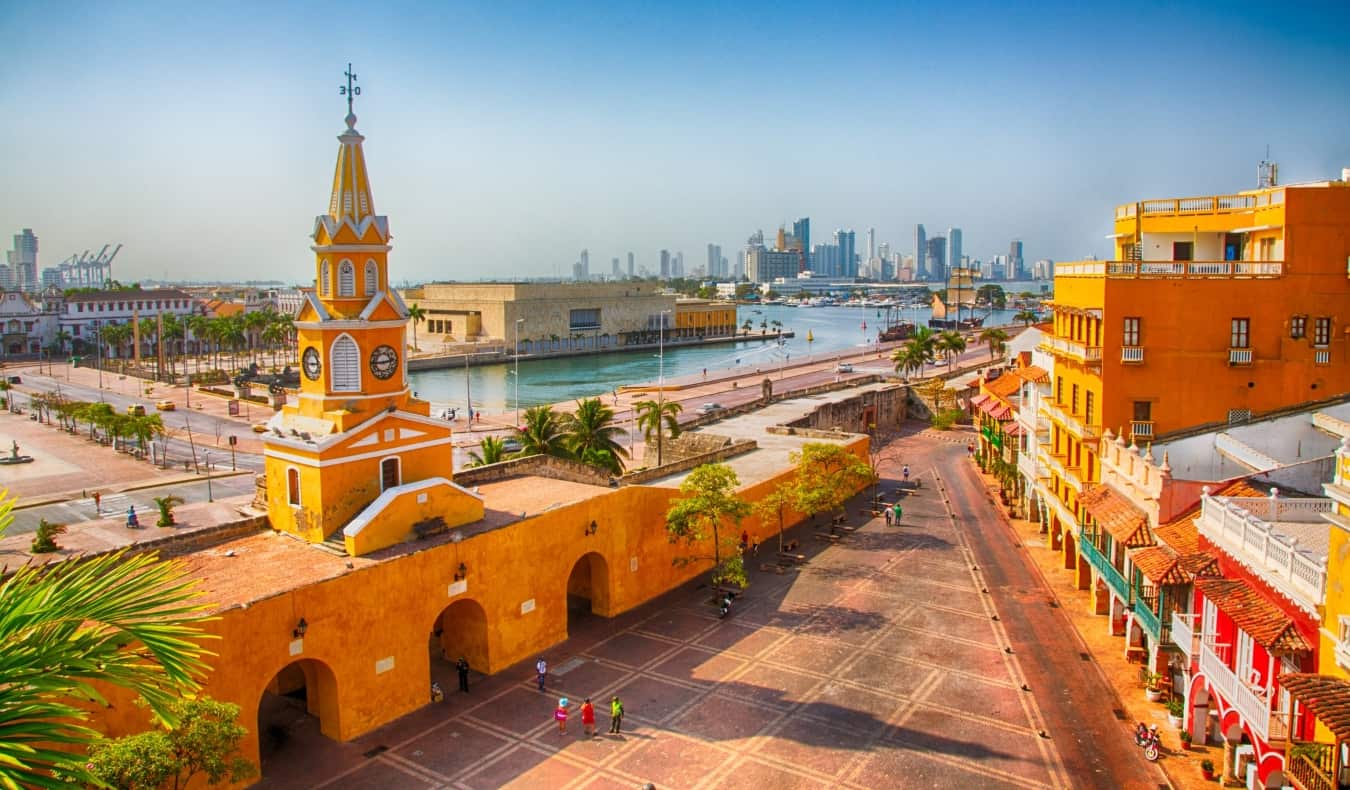
Colombia is one of the most popular countries in South America for backpackers and travelers. In 2022, it saw over 4.6 million visitors — a huge increase from the early 2000s, when just 700,000 visitors came to Colombia each year .
Over the past few decades, Colombia has been working hard to dispel the violent image it earned thanks to the drug cartels that once ravaged the country.
While Colombia still isn’t perfect, it’s come a long way since our parents’ generation . Between the 1970s-1990s, Colombia’s position as an epicenter of cocaine production and trade led to the rise of drug trafficking cartels and associated violence.
Thankfully, violent crimes that were once common here, such as murder and kidnapping, have decreased. Kidnapping has declined by 92% and homicides are down by 50% over the past two decades.
Slowly but surely, conditions in Colombia are improving for locals and tourists alike.
So, as long as you stay in well-traveled areas and mind the advice from locals you can still enjoy traveling here (this is actually one of those times when you want to consider staying on the ‘beaten path’).
But a lot of people still ask me: is Colombia safe? So, here’s everything you need to know about staying safe in Colombia.
Table of Contents
My Experience in Colombia
10 safety tips for colombia.
- Is Colombia Safe for Solo Travelers?
Is Colombia Safe for Solo Female Travelers?
- Are Taxis Safe Colombia?
Is the Food Safe in Colombia?
Can you drink the tap water in colombia, should you visit colombia.
Before I went to Colombia, I’d heard countless stories of petty theft. While there, I heard even more. A friend of mine had been robbed three times, the last time at gunpoint while on his way to meet me for dinner.
Locals and expats alike told me the same thing: the rumors of petty theft are true, but if you keep your wits about you, follow the rules, and don’t flash your valuables, you’ll be OK.
There’s even a local expression about it: “No dar papaya” (Don’t give papaya). Essentially, it means that you shouldn’t have something “sweet” out in the open (a phone, computer, watch, etc.) that would make you a target. Keep your valuables hidden, don’t wander around places you shouldn’t at night, don’t flash money around, avoid coming out of nightlife spots alone at night, etc. Simply put: don’t put yourself in a position where people can take advantage of you.
I heeded such advice. I didn’t wear headphones in public. I didn’t take my phone out unless I was in a group or a restaurant, or completely sure no one else was around. I took just enough money with me for the day when I left my hostel. I warned friends about wearing flashy jewelry or watches when they visited.
But the longer you are somewhere, the more complacent you get.
When you see locals on their phones in crowded areas, tourists toting thousand-dollar cameras, and kids wearing Airpods and Apple Watches, you begin to think, “OK, during the day, maybe it’s not so bad.”
Suddenly, you step out of a café with your phone out without even thinking about it.
You’re giving papaya.
And someone wants to take it.
Which is how I ended up getting mugged and knifed . (I’m OK.)
This was also just a matter of being unlucky and not specific to Colombia. A wrong-time-wrong-place situation. It could have happened to me anywhere where I didn’t follow the safety rules that help you minimize risk.
The experience reminded me of why you can’t get complacent. I gave papaya. I shouldn’t have had my phone out. It didn’t matter the time of day. That’s the rule in Colombia. Keep your valuables hidden. (Especially in Bogotá, which does have a higher rate of petty crime (though a lower homicide rate) than elsewhere in the country.) I didn’t follow the advice.
And I got unlucky because of it. I’d been having my phone out too often and, with each non-incident, I grew more and more relaxed. I kept dropping my guard.
What happened was unlucky, but it didn’t need to happen if I had followed the rules.
This is why people warned me to be careful.
So, if you follow the rules and take appropriate precautions, you’re unlikely to have a problem. I’m not going to let this freak incident change my view of such an amazing country. I’d go back to Colombia the same way I’d get in a car after a car accident. In fact, I was terribly upset to leave. I was having an amazing time.
I still love Bogotá . I still have plans to go back to Colombia.
Learn from my mistake. Not only for when you visit Colombia but when you travel in general.
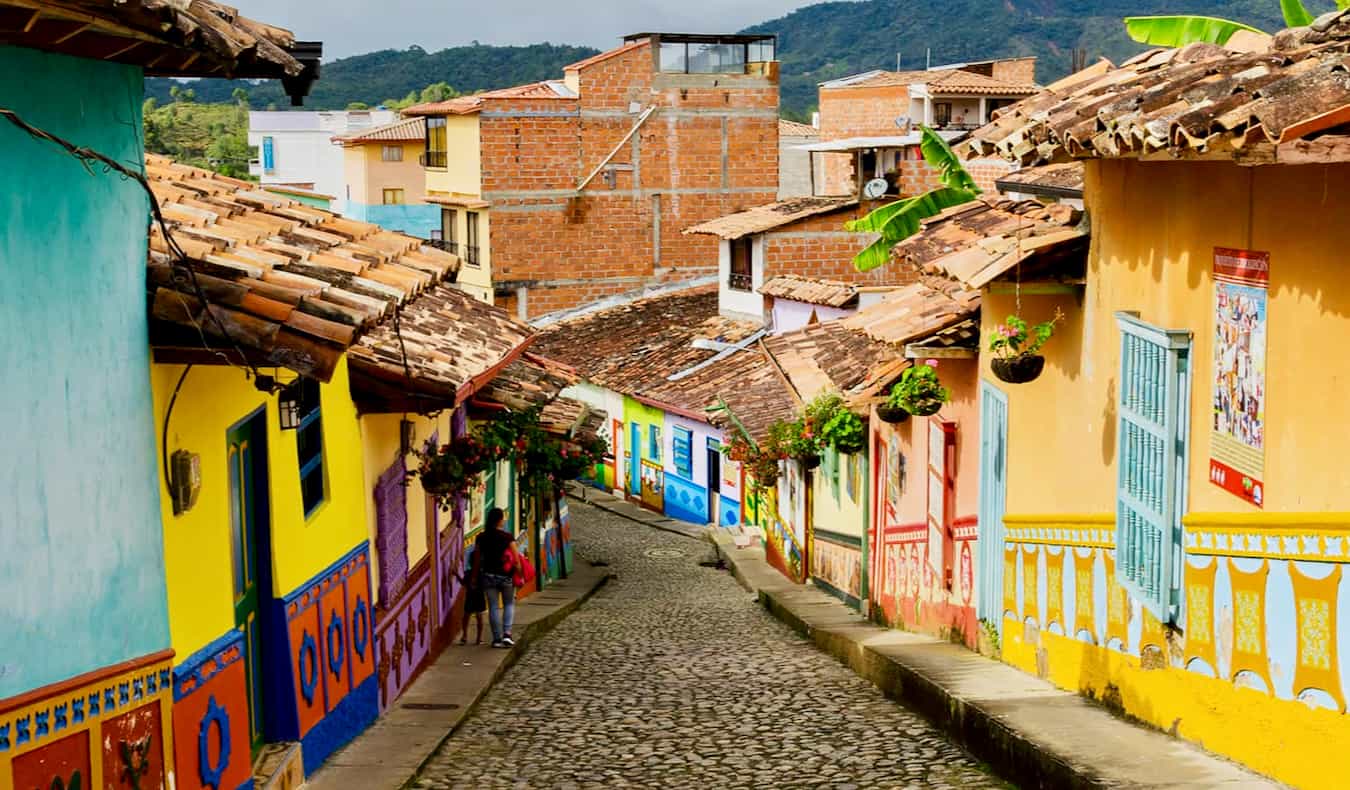
1. Stay somewhere with 24-hour security – You always want someone around in case you need assistance. Most hostels and hotels have security cameras or guards. If you don’t feel safe somewhere, don’t hesitate to move on. This way you always have someone to talk to in case something goes wrong.
2. Don’t flash your belongings while you’re out and about – Keep your phone out of sight, and don’t wear any jewelry or watches. If you need to use your phone, do it inside and not out on the street. This is where people get in the most trouble. This is how I got into trouble. Put everything away so you don’t stand out.
3. Don’t travel alone at night – Try to go out with other travelers if you’re going out at night. Also, if you’re out, watch your drink and don’t leave it unattended and be cautious when using dating apps. If you do plan to go out alone or party late, be sure to take an Uber home or have someone call you a cab. Don’t walk alone really late at night.
4. Learn some Spanish – Even just a few phrases can help you in an emergency. Download Spanish on the Google Translate app so you have it offline as well, just in case.
5. Download an offline map of the city – Having a map will be helpful in case you get lost and need to guide yourself (or a taxi driver) back to your accommodation. If you use your phone at night, be sure to not use it out in the streets.
6. Don’t do drugs – The drug cartels have crippled this country. Don’t support them by buying drugs. Locals don’t like it because drugs have devastated the country and doing it just further harms the country. It’s really disrespectful. Additionally, getting involved with drugs here increases your chances of getting into trouble. Finally, doing drugs here is illegal, and you don’t want to end up in a Colombian prison.
7. Keep your valuables separate – When you’re going out for the day, leave some credit cards and cash locked in your accommodation. That way, if you lose your wallet, you’ll still have cash and cards back at your hostel. In general, it’s a good idea to make photocopies of your passport to take with you and lock up your passport in your hostel locker. Keep digital copies of your passport in your email inbox too just in case.
8. If the worst happens, just give the attacker your stuff – Handing over your things is much better than risking the alternative (trust me). If you have travel insurance , you’ll be able to get reimbursed (just be sure to save all of your receipts).
9. Download the Prey app to your phone and laptop – If either device gets stolen, you’ll be able to track it and remotely turn on your camera to photograph the thief (you can also wipe the data and message the thief too). It costs just $1.10/month.
10. Buy travel insurance – If something does go wrong, you want to be sure you’re covered and someone has your back. Travel insurance can help you find medical treatment and give you money to buy replacements for what was stolen. It’s always better to be safe than sorry, especially in a country where petty crime is still a problem.
We recommend Safety Wing for travelers under 70, while Insure My Trip is the best choice for travelers over 70.
You can check out this widget to get a quote for Safety Wing:
For more information on travel insurance, check out these posts:
- What Does Travel Insurance ACTUALLY Cover?
- The Best Travel Insurance Companies
- How to Buy the Best Travel Insurance
So, is Colombia Safe for Solo Travelers?
Colombia can be safe for solo travelers if you take the right precautions. While petty crime is still a problem, as long as you don’t flaunt your valuables, you’ll likely not run into any problems. When you go out, only take what you need for the day and leave your other valuables in your hostel or hotel room.
If you’re not feeling comfortable, try to meet other travelers at hostels or on tours so you can explore together. That way you’ll never be alone and will avoid being a target for pickpockets and petty criminals.
At night, make sure you’re never traveling alone and that you have your ride home planned in advance. Don’t get into sketchy cabs. Avoid wandering around non-touristy areas at night and alone. If you’re using dating apps, exercise caution as there have been instances of tourists being drugged and robbed.
I never felt really unsafe in the country during the day or in public places. You’ll see locals with phones out and, generally, going about their life. It’s really at night that you have to be careful.
While solo female travelers should take some extra precautions in Colombia, the country should definitely still be under consideration for women traveling on their own.
Whenever possible, avoid traveling alone — especially at night or in areas where there are not many people. Don’t flaunt any valuables, and avoid taking taxis alone at night.
Always watch your drinks in a bar and don’t accept drinks from people you don’t know.
Always have a downloaded map and translator so you can find your way home or ask for help if you need it.
By taking some precautions and planning accordingly, solo female travelers will be able to have a rewarding time traveling in Colombia. Just make sure to follow the advice and tips above!
Here are a couple of helpful posts on safety written by our solo female travel experts:
- How to Stay Safe as a Solo Female Traveler
- 8 Myths About Solo Female Travel Debunked
- 10 Common Questions About Solo Female Travel
Are Taxis Safe in Colombia?
Taxis are safe here, but always make sure you call your taxi in advance or use an app like EasyTaxi. Never get into a random vehicle. Even if it looks like a taxi, it might not be one. It’s always better to play it safe.
Get your hostel or accommodation to call a cab for you, or download a taxi app (Uber is available in major cities in Colombia, including Cartagena , Medellín , Cali , and Bogotá ) so you can order your own. Avoid taking taxis at night as well (especially as a solo female traveler).
The food in Colombia is quite safe. Just make sure to avoid any food that’s been sitting out in the sun all day. Look for places with lots of patrons — that’s how you can tell the food is fresh and delicious.
Also, make sure any fruit you eat has a peel to avoid it getting contaminated.
If you’re a vegetarian or have other dietary concerns, you might be hard-pressed to find food outside of the major cities, as most dishes are meat-based. Learn some basic phrases (or download Google Translate) to help you ask questions and find foods suitable for your diet.
Lastly, always wash your hands before you eat. That’s the best way to avoid getting sick!
While improvements in water treatment are coming along, you can’t really drink the water outside of Bogotá and Medellín.
I’d suggest you travel with a Lifestraw so you can purify water no matter where you are. That will help you save money and reduce your reliance on single-use plastic. Double win!
So, is Colombia safe?
That depends on how you act, where you go, and if you follow the tips above.
While petty theft is a growing concern and there has been a slight uptick in crime, the country has so much to offer the intrepid traveler. There is amazing nature, vibrant cities, a fun nightlife, and a growing community of entrepreneurs and digital nomads who call Colombia home .
It’s cheap and easy to navigate, and as long as you follow your instincts and use common sense, you will avoid trouble.
So, while my personal experience in Colombia didn’t end well, I definitely plan on going back.
Because it’s just too amazing a place not to visit.
Book Your Trip to Colombia: Logistical Tips and Tricks
Book Your Flight Use Skyscanner to find a cheap flight. They are my favorite search engine because they search websites and airlines around the globe so you always know no stone is left unturned!
Book Your Accommodation You can book your hostel with Hostelworld as they have the biggest inventory and best deals. If you want to stay somewhere other than a hostel, use Booking.com as they consistently return the cheapest rates for guesthouses and cheap hotels.
Don’t Forget Travel Insurance Travel insurance will protect you against illness, injury, theft, and cancellations. It’s comprehensive protection in case anything goes wrong. I never go on a trip without it as I’ve had to use it many times in the past. My favorite companies that offer the best service and value are:
- Safety Wing (best for everyone)
- Insure My Trip (for those over 70)
- Medjet (for additional evacuation coverage)
Looking for the Best Companies to Save Money With? Check out my resource page for the best companies to use when you travel. I list all the ones I use to save money when I’m on the road. They will save you money when you travel too.
Want More Information on Colombia? Be sure to visit our robust destination guide to Colombia for even more planning tips!
Got a comment on this article? Join the conversation on Facebook , Instagram , or Twitter and share your thoughts!
Disclosure: Please note that some of the links above may be affiliate links, and at no additional cost to you, I earn a commission if you make a purchase. I recommend only products and companies I use and the income goes to keeping the site community supported and ad free.
Related Posts

Get my best stuff sent straight to you!
Pin it on pinterest.
- Meet Our Advisory Board
- Global Connections at Yale
- Y Global Health?
- SHI Venture Development Program
- SHI Mentors in Residence
- SHI Fellows
- Staff and Advisors
- Past Events
- YIGH Global Health Conversation Series
- Yale Global Health Insights Podcast
- Global Health Symposium
- Bobo-Dioulasso, Burkina Faso - IRSS
- Bobo-Dioulasso, Burkina Faso - INSTech
- Legon, Ghana
- Nairobi, Kenya
- Jos, Nigeria
- Dakar, Senegal - CIGASS
- Dakar, Senegal - Institut Pasteur
- Pietermaritzburg, South Africa
- Cape Town, South Africa
- Johannesburg, South Africa
- Shinyanga, Tanzania
- Kampala, Uganda
- Lusaka, Zambia
- Harare, Zimbabwe
- Cali, Colombia
- Bogota, Colombia
- Quito, Ecuador
- Mona, Jamaica
- Managua, Nicaragua
- Lima, Peru - LID
- Lima, Peru - SPHA
- Kyiv, Ukraine
- Dhaka and Matlab, Bangladesh - Stanford
- Dhaka and Matlab, Bangladesh - UC Berkeley
- Mysore, India
- Chennai, India
- Kuala Lumpur, Malaysia
- Karachi, Pakistan
- Apia, Samoa
- Eligibility
- Selection Process
- Contact Information
- A Successful GHES Applicant
- Current Fellows
- Past Fellows
- Publications
- Search International Activity
- Search Keywords
- Yale Antimicrobial Resistance Faculty Network (AMR)
- Yale Biological Embedding, Global Research & Intervention Network (BEGIN)
- Yale Emergency, Critical Care and Disaster Medicine Network (ECCDM)
- Yale Global Addictions Network
- Yale Global HIV/AIDS Research Network (GARNER)
- Yale Global Health Ethics Network
- Yale Network for Global Non-Communicable Diseases (NGN)
- Yale Global Surgery Network
- Yale Global Women's Health Network
- Yale Planetary Health Interdisciplinary Network Exchange (PHINEX)
- Yale-Uganda
- Yale Network for Vaccine Initiatives
- Yale Vector-Borne and Zoonotic Diseases (VB&ZD) Network
- Frequently Asked Questions
- Global Health Spark Awards
- CIRA 2024 Pilot Projects in HIV Research
- Other Yale Opportunities
- International Travel Resources
- Global Health Seminar
- Topics in Global Medicine and Health
- Digital Media for Health Outcomes
- 2020 Leadership in Global Health Fellows
- 2021 Leadership in Global Health Fellows
- 2022 Leadership in Global Health Fellows
- 2023 Leadership in Global Health Fellows
- YIGH Student Fellows
- Global Health Ethics Program
- 2020 Case Competition
- 2021 Case Competition
- 2022 Case Competition
- 2023 Case Competition
- 2024 Case Competition
INFORMATION FOR
- Residents & Fellows
- Researchers
YJBM Spring 2024 Colloquium
Come to YJBM's Spring 2024 Colloquium on Cell Fate, featuring Josien van Wolfswinkel, PHD, MSc, Assistant Professor of Molecular, Cellular and Developmental Biology at Yale University, giving her talk "The Eternal Life of Planarian Stem Cells."
- Josien van Wolfswinkel, PhD, MSc Assistant Professor of Molecular, Cellular and Developmental Biology
Host Organization
- Biology and Medicine, Yale Journal of (YJBM)

COMMENTS
The third-largest Colombian city, Cali, provides a relatively safe destination as long as you adhere to the Colombian tenet, "No dar papaya.". That means don't give papaya literally and it is slang for not flashing money or expensive items. Despite the Colombian drug trade and housing some of the most famed drug cartels, Colombia still ...
Cali is one of the more dangerous cities in Colombia, but it is safe to travel as long as you take extra safety precautions. Crime is concentrated in a few areas, so as long as travelers stay in tourist areas, they'll be safer. It is important that you don't " dar papaya ", a Colombian Spanish saying for "don't put yourself in a ...
Read the entire Travel Advisory. Do Not Travel to: Arauca, Cauca (excluding Popayán), and Norte de Santander departments due to crime and terrorism. The Colombia-Venezuela border region due to crime, kidnapping, and risk of detention when crossing into Venezuela from Colombia. Country Summary: Violent crime, such as homicide, assault, and ...
It's true—Colombia is becoming a hotspot for tourists, with a record-breaking 5.8 million visitors in 2023. CNN even named it one of the "Best Destinations to Visit," and the star of our article, Cali, got a special mention from Forbes as a top place to visit.. Now, Cali isn't just any city—it's the salsa capital of Colombia! CNN even says salsa dancing here is a must-do experience.
The Department of State renewed its Travel Advisory for Colombia on October 26, 2021, which remains at Level 3 (Reconsider Travel). Reconsider travel to Colombia due to COVID-19. Exercise increased caution in Colombia due to civil unrest, crime, terrorism and kidnapping. Some areas have increased risk.
Yes! It absolutely is safe to travel to Colombia, today. Around 5,188,312 international visitors were welcomed in Colombia from January to November 2023 as recorded by Ministry of Commerce, Industry and Tourism. Most tourists had a secured visit.
2. Avoid Drugs. There are a lot of drug dealers in Colombia, and Cali is no different. Unfortunately, there's still a lot of drug tourism in Colombia. However, the people in Colombia try to get as far away from drugs as possible, as it is the cause of so much bloodshed in their country.
However, by following the local rules, a fun and safe trip to Colombia is possible. COVID safety requirements in Cali, Colombia: Travelers must be vaccinated or have a valid negative COVID test before they can enter Colombia. Travelers must show proof that they received the final injection of the series more than 14 days prior to travel.
A Few Cali, Colombia Statistics (from dataimpacts.org) ~ Cali's Homicide Rate Peaked In 1994. ~ Cali Was One Of The 10 Most Dangerous Cities In The World. ~ 50% Of Victims Were Intoxicated Or At A Bar When Killed. ~ Enforcement Policies Led To A 50% Decrease In The Homicide Rate By 1997.
Stick to exploring one section of the country and exploring it well: spend three weeks bouncing between sun-soaked, Caribbean beaches or heading from Medellín deep into the Zona Cafetera. Your trip should match Colombia's characteristic pace: slow and enjoyable. 2. Domestic flights are affordable and quick.
Government travel advisories have declared several regions of Colombia to be safe for travel. These include Bogotá , Tunja, Bucaramanga, Medellín, Cali , the Coffee Zone departments of Quindio, Risaralda and Caldas, San Andres, the Caribbean cities of Cartagena, Barranquilla, Santa Marta and Capurganá, and the Pacific coast towns Nuquí and ...
Cali is a relatively safe place to visit in Colombia and there are some landmarks I'll mention below that will give you more reasons to visit. As long as you take precautions and follow basic safety travel tips, you will be able to explore most of the attractions this city has to offer. The risk level is moderate because organized crime is ...
Colombia Travel Costs. Hostel prices - Large dorm rooms with 8-10 beds start as low as 16,000 COP per night but average closer to 30,000 COP. Dorm rooms with 4-6 beds start at 30,000 COP per night. Private rooms start around 40,000 COP per night for a double room for two people but can cost up to 170,000 COP.
Cali, a hotbed for Salsa music, is located in a valley adjacent to the magnificent Andes Mountains. Hop in a car, and you can be at the ocean in just a couple of hours. But Colombia's third-largest city is best known for its energetic atmosphere, growing economy, and bustling nightlife. With over 2 million people, Cali is a center of Latin ...
Bogotá to Cali: 11+ hours. Ipiales (border with Ecuador) to Cali: 12 hours. Getting from the bus station to the city center will take ~30 min by public transport (MIO bus line). However, a taxi or Uber will be faster (10-15 min) and safer when traveling with luggage.
If your travel plans in Colombia include outdoor activities, take these steps to stay safe and healthy during your trip. Stay alert to changing weather conditions and adjust your plans if conditions become unsafe. Prepare for activities by wearing the right clothes and packing protective items, such as bug spray, sunscreen, and a basic first ...
Call us in Washington, D.C. at 1-888-407-4747 (toll-free in the United States and Canada) or 1-202-501-4444 (from all other countries) from 8:00 a.m. to 8:00 p.m., Eastern Standard Time, Monday through Friday (except U.S. federal holidays). See the State Department's travel website for the Worldwide Caution and Travel Advisories.
Find continuously updated travel restrictions for Colombia such as border, vaccination, COVID-19 testing, and quarantine requirements.
Colombia's climate varies little throughout the year. You can expect a hot, humid climate, but there is a drier season called summer, as opposed to the wet season called winter. The Andean highlands, where Cali is located, has two dry seasons, from December to March and again in July and August. Cali's average temperature is 23° C (73.4°F)
Colombia - Venezuela Border - Level 4: Do Not Travel. U.S. citizens are advised not to travel to the border of Colombia and Venezuela. U.S. citizens are at risk of detention when crossing into Venezuela. The Colombia-Venezuela border is not clearly marked, and U.S. citizens should not go near the border due to the risk of crossing into ...
Is it Safe to Travel to Cali? Our best data indicates this area is somewhat safe, but with extra warnings in a few regions. As of Dec 04, 2023 there are travel warnings and regional advisories for Colombia; exercise a high degree of caution and avoid some areas. Check this page for any recent changes or regions to avoid: Travel Advice and Advisories.
Colombia is one of the most popular countries in South America for backpackers and travelers. In 2022, it saw over 4.6 million visitors — a huge increase from the early 2000s, when just 700,000 visitors came to Colombia each year. Over the past few decades, Colombia has been working hard to dispel the violent image it earned thanks to the ...
Bogota to Cali via cheap domestic flight takes only about 1.5 hours and is offered by a handful of different national airlines including Avianca, Wingo and Latam. One-way tickets run under $100 USD. Medellin to Cali flights take under an hour, cost around $50 USD, and are available daily via Latam and Wingo.
05/08/2024 event : Come to YJBM's Spring 2024 Colloquium on Cell Fate, featuring Josien van Wolfswinkel, PHD, MSc, Assistant Professor of Molecular, Cellular